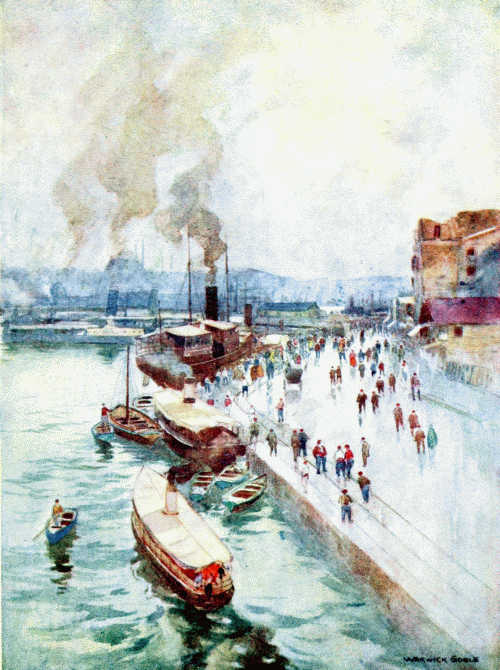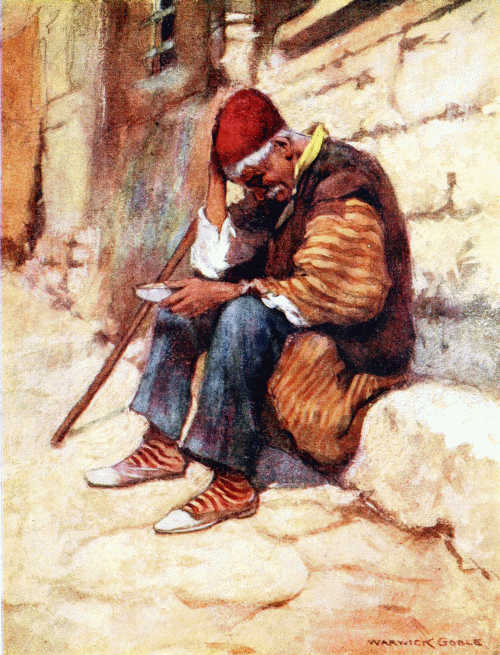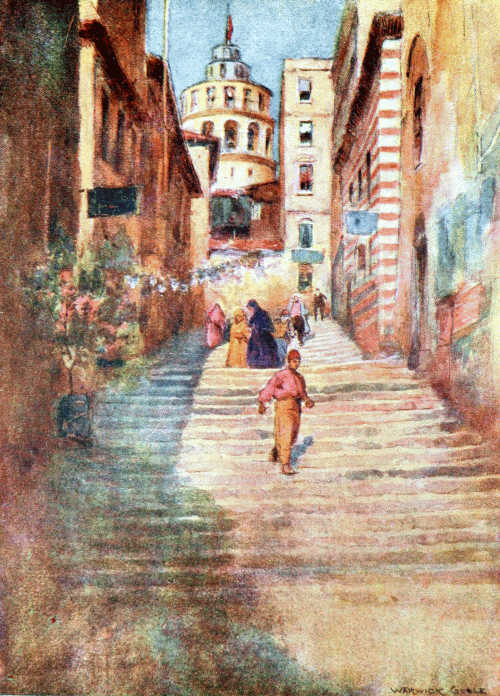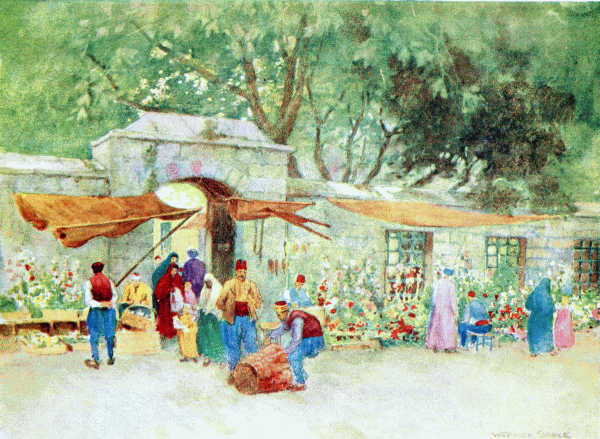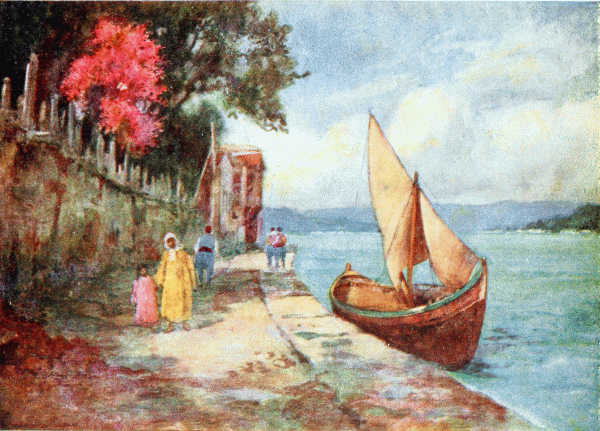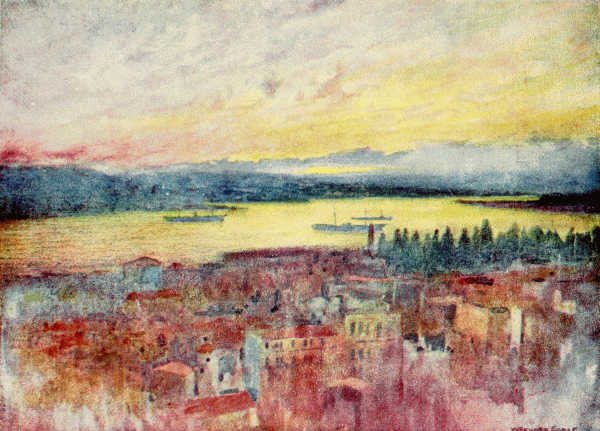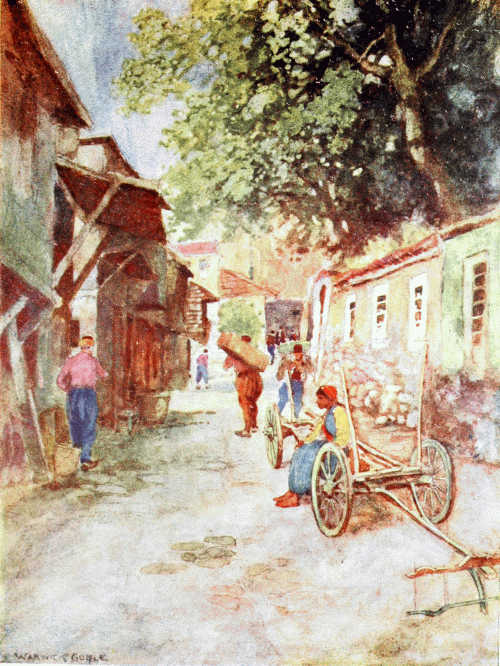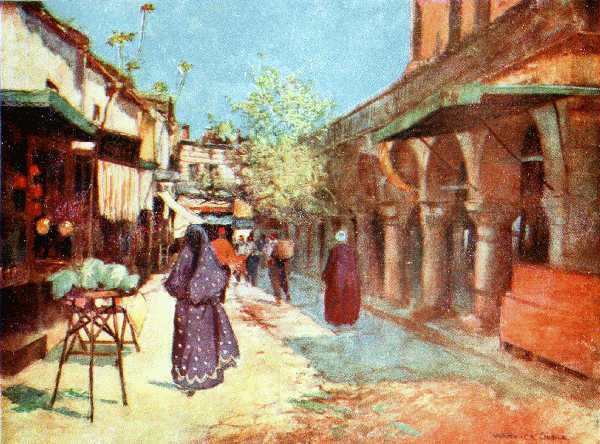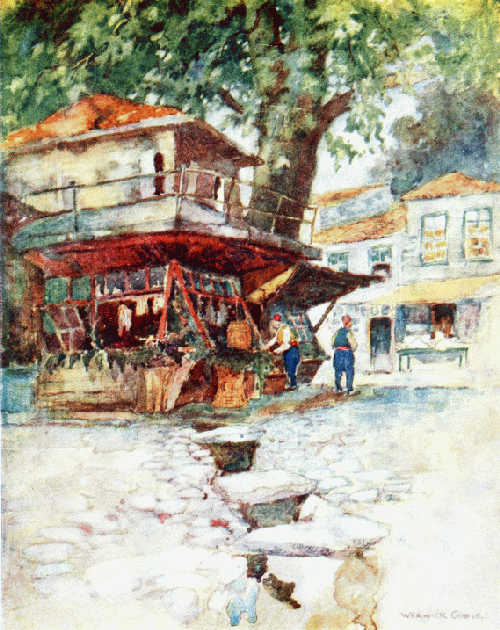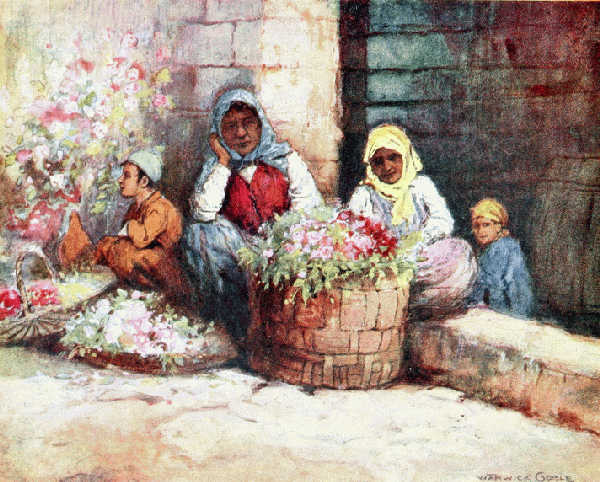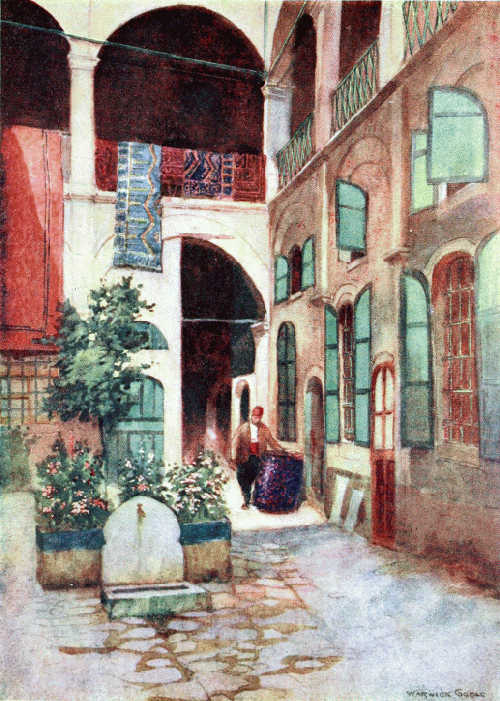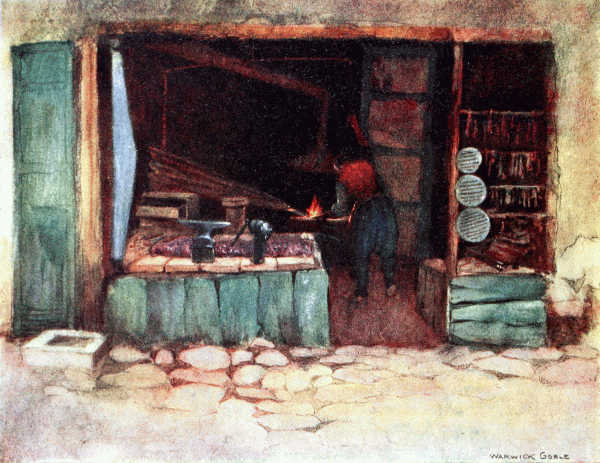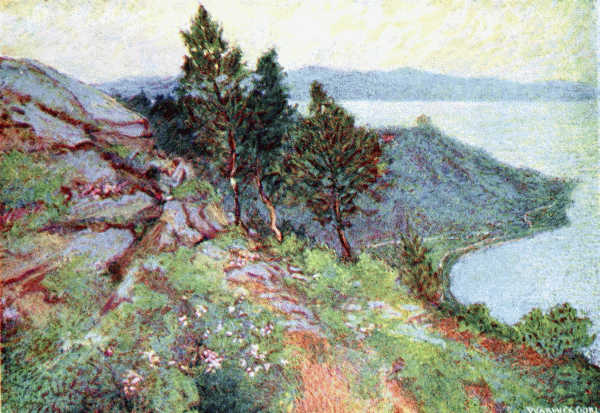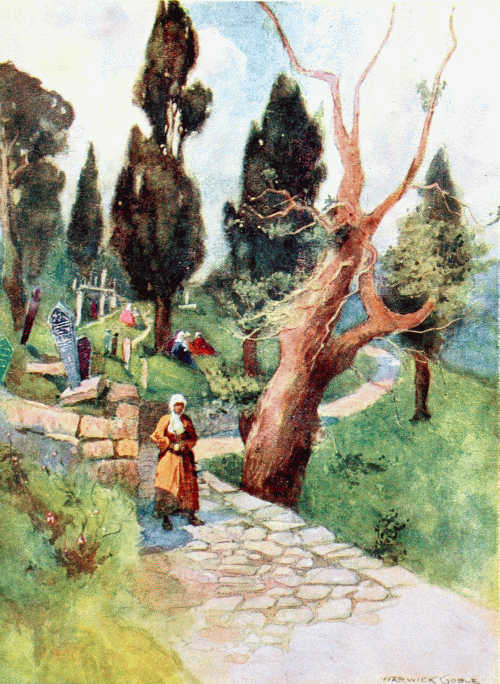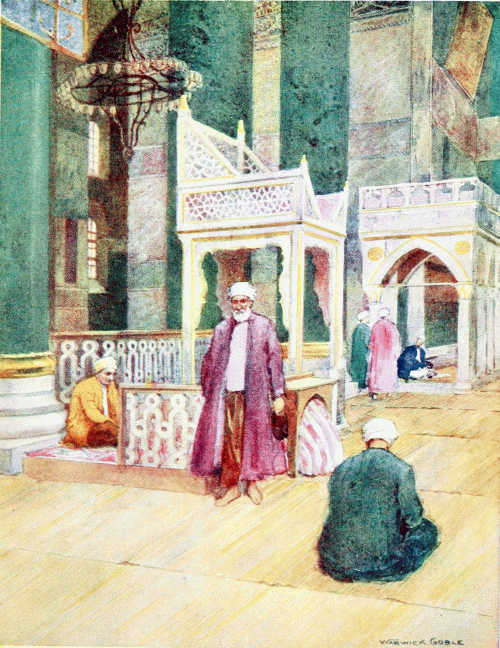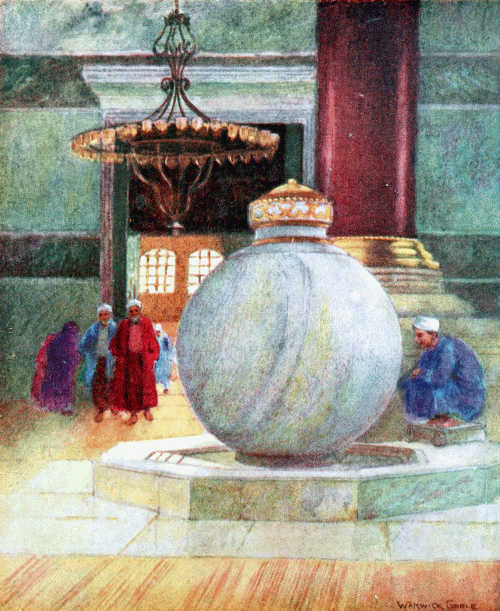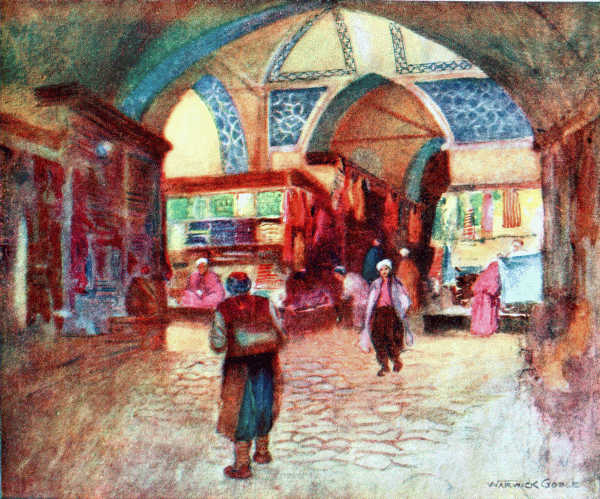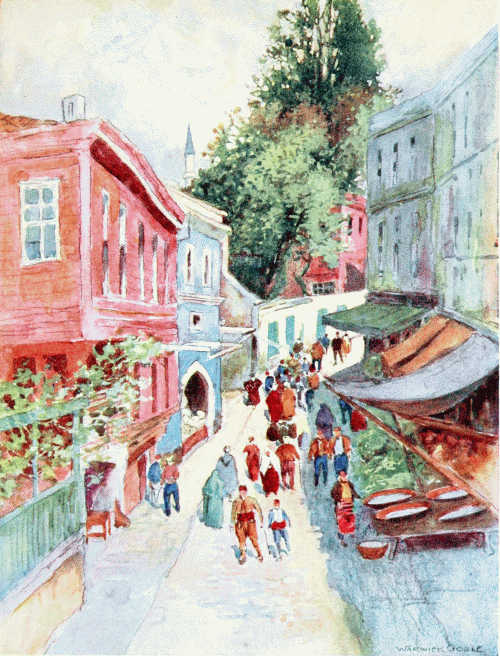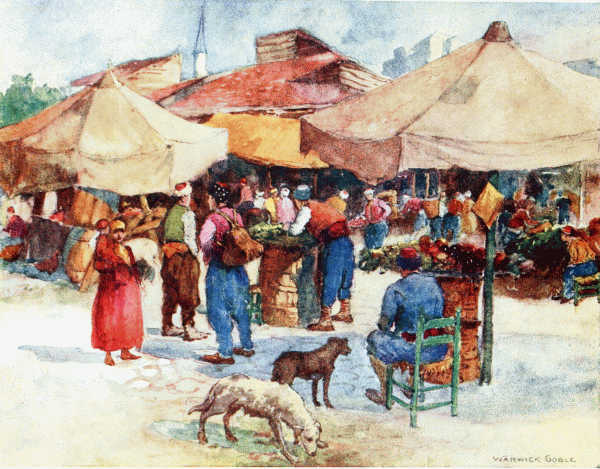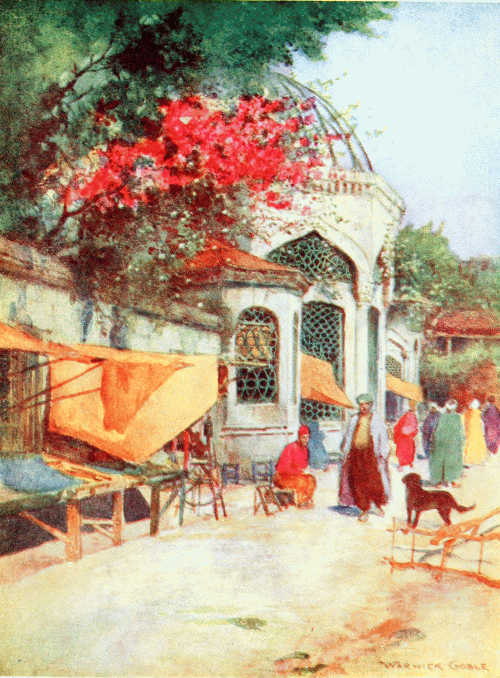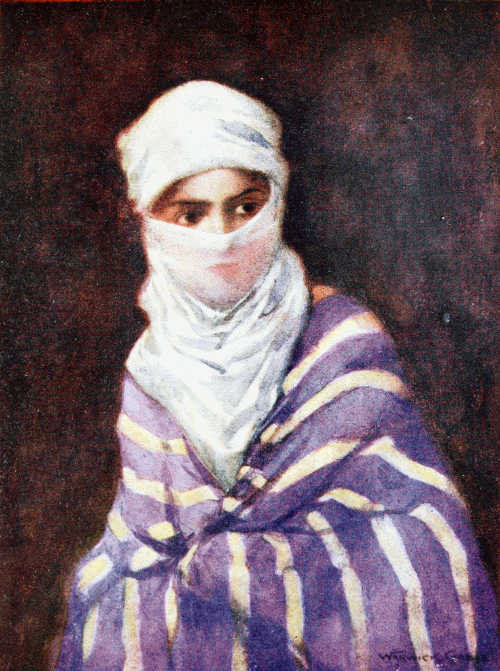.

|
AGENTS
| America | The Macmillan Company |
| 64 & 66 Fifth Avenue, New York | |
| Australasia | The Oxford University Press |
| 205 Flinders Lane, Melbourne | |
| Canada | The Macmillan Company of Canada, Ltd. |
| St. Martin’s House, 70 Bond Street, Toronto | |
| India | Macmillan & Company, Ltd. |
| Macmillan Building, Bombay | |
| 309 Bow Bazaar Street, Calcutta |
CONSTANTINOPLE,
PAINTED BY WARWICK GOBLE · DESCRIBED
BY ALEXANDER VAN MILLINGEN, M.A., D.D. PUBLISHED BY A. & C. BLACK · LONDON
MCMVI
CONTENTS
| CHAPTER I | |
| PAGE | |
| The Making of Constantinople under Constantine the Great | 1 |
| CHAPTER II | |
| The Making of Constantinople, under the Emperors Constantius, Julian, Valens, Theodosius the Great, and Arcadius | 24 |
| CHAPTER III | |
| The Making of Constantinople under Theodosius II | 52 |
| CHAPTER IV | |
| Along the Walls | 80 |
| CHAPTER V | |
| Along the Walls beside the Golden Horn | 101 |
| CHAPTER VI | |
| Along the Landward Walls | 118 |
| CHAPTER VII | |
| Among the Churches of the City | 132 |
| CHAPTER VIII | |
| Among the Churches | 147 |
| CHAPTER IX | |
| Among the Churches | 170 |
| CHAPTER X | |
| Impressions of the City To-day | 195 |
| CHAPTER XI | |
| Religious Colouring | 223 |
| CHAPTER XII | |
| Turkish Women | 242 |
| CHAPTER XIII | |
| Epilogue | 262 |
| INDEX | 277 |
LIST OF ILLUSTRATIONS
| 1. A Turkish Lady in Out-Door Dress | Frontispiece |
| FACING PAGE | |
| 2. The Quay in Galata | 2 |
| 3. Galata from the Aqueduct of Valens | 6 |
| 4. Stamboul Beggar | 10 |
| 5. Gypsy Basket-Maker | 12 |
| 6. A Step Street in Galata | 16 |
| 7. A Flower-Market, Scutari | 18 |
| 8. The Galata Bridge | 22 |
| 9. A Cemetery by the Bosporus | 24 |
| 10. “A Kafedji” | 28 |
| 11. Golden Horn from the British Hospital, Galata | 30 |
| 12. Street Scene, Clay Works | 34 |
| 13. Street Scene, Stamboul | 36 |
| 14. A Village Store at Kavak | 40 |
| 15. Galata Tower from the Bridge | 42 |
| 16. Refugee Huts on the Marmora | 48 |
| 17. Turkish Delight Factory | 50 |
| 18. Flower-Sellers | 52 |
| 19. Carpet-Menders | 56 |
| 20. Fruit-Market, Stamboul | 60 |
| 21. Carpet Warehouse | 64 |
| 22. Shoemaker, Stamboul | 66 |
| 23. Street Scene, Roumeli Hissar | 70 |
| 24. Grand Bazaar, Stamboul | 72 |
| 25. A Blacksmith’s Shop | 76 |
| 26. Seraglio Point from “The Stones” | 82 |
| 27. The Seraglio Lighthouse and Scutari | 84 |
| 28. Crimean Memorial, British Cemetery, Haidar Pasha | 88 |
| 29. Interior of the Mosque of Sultan Ahmed I. | 94 |
| 30. Prinkipo (Princes Islands) | 98 |
| 31. Golden Horn, early Morning | 104 |
| 32. The Bridge from Galata | 106 |
| 33. Golden Horn | 108 |
| 34. Suleimaniyeh at Sunrise | 110 |
| 35. Cemetery at Eyoub | 112 |
| 36. Galata and Stamboul from Eyoub | 114 |
| 37. Golden Horn after Sunset | 116 |
| 38. The Walls; the Tower of Isaac Angelus | 120 |
| 39. Constantinople and Golden Horn from the Cemetery at Eyoub | 130 |
| 40. View from an old Cemetery | 134 |
| 41. Market in the Court of the Mosque of Sultan Ahmed I. | 138 |
| 42. Court of the Suleimaniyeh | 142 |
| 43. Interior of S. Sophia | 158 |
| 44. Interior of S. Sophia, the Sultan’s Gallery | 180 |
| 45. Fountain in S. Sophia | 184 |
| 46. A Wet Day on the Galata Bridge | 196 |
| 47. In the Grand Bazaar | 198 |
| 48. A Fortune-Teller | 200 |
| 49. Street Scene, Top-Khaneh | 202 |
| 50. A Step Street | 206 |
| 51. Simit-Seller | 208 |
| 52. Market at Scutari | 212 |
| 53. Entrance to a Turkish Khan | 214 |
| 54. Turkish Well, Stamboul | 216 |
| 55. A Fountain by the Bosporus | 218 |
| 56. Open Air Café, Stamboul | 222 |
| 57. Roumeli Hissar | 224 |
| 58. A Howling Dervish | 228 |
| 59. A Whirling Dervish | 230 |
| 60. Tomb in Scutari | 238 |
| 61. The Sweet Waters of Europe | 254 |
| 62. The Yashmak | 256 |
| 63. The Sweet Waters of Asia | 260 |
CONSTANTINOPLE
CHAPTER I
the making of constantinople under constantine the great
328-337 a.d.
The foundation of Constantinople was an event of the utmost political significance. That personal feelings actuated Constantine the Great in the decision to establish a seat of government far from the walls of Rome is doubtless true. The insults to which he was exposed, on the occasion of his visit to the ancient capital of the Empire, in 326, on account of the execution of his wife and of his son, could not fail to annoy him, and make him willing to shake the dust of the rude city from off his feet. To have a placard put on his palace gates comparing him with Nero was not flattering. Certainly the Roman populace did not make respectful subjects. Diocletian also, before Constantine, had found Roman citizens insolent, and2 fled from the slings and arrows of their sarcasm without waiting to meet the Senate, or to be invested with the consular dignity. But after all, personal feelings go only a short way towards the explanation of an event so serious in the history of the Roman State as the establishment of another seat of imperial authority. The volume and force of a mighty river might as well be explained by the drops of a shower which fall into its current. Constantine was too great a statesman to be swayed by mere personal impulse. The foundation of Constantinople was the outward and visible sign of profound changes in the ideas and policy created and long embodied by the city enthroned beside the Tiber. It was the expression of the spirit of a new epoch; as much so as the foundation of Alexandria signified a change in the political conceptions of the Hellenic world, or the building of St. Petersburg marked the new aspirations heaving in the heart of Russia, or the erection, in more recent times, of Washington or Ottawa proclaimed the birth of new commonwealths, and the application of new principles. Old ideas and ancient institutions cannot be altered in one day, or at the caprice of one man. They are not the flimsy things which can be created or destroyed by the wave of a magician’s wand. Con3stantine only placed the copestone on an edifice which other hands, before his reign, had gradually raised from the foundations to the point demanding completion. He finished what others had begun. The creation of the new capital was the result of causes, long in action; not a whim or matter of taste.
In the first place, the political relation of the city of Rome to the Roman world had undergone a fundamental change. The citizens of that wonderful city were no longer the proprietors and sovereigns of the realm over which the Roman eagles had spread their wings. The Senate which assembled in the Curia, the people which gathered in the Forum Romanum, had ceased to rule subject cities and nations. That glory had departed. In Gibbon’s mordant language, “The Senate was left a venerable but useless monument of antiquity upon the Capitoline hill.” Every freeman within the Empire’s bounds was now the equal of the men whose forefathers had been the kings of the world. Rome was now only one of the great cities of the Roman State, differing from her peers only in the memories and the prestige of a happier and grander past. The government of the world by the city had broken down, and was vested in4 the hands of one supreme man. And that man had gradually become an absolute lord and monarch; who exercised plenary authority wherever he chose to reside, who decked himself with jewels and resplendent robes, who made his throne the lofty peak of a vast hierarchy of nobles and officials, and introduced new methods of administration; a man, perhaps, without a drop of the blood which Romans proudly bore, but a rude provincial, yet to whose will the Eternal City bowed as humbly as the remotest village beneath his sceptre. If a Cassius still lived he might, pointing to the Master of the Empire, well exclaim, “He doth bestride the narrow world like a Colossus, and we petty men walk under his huge legs, and peep about to find ourselves dishonourable graves.... Rome, thou hast lost the breed of noble bloods!” That a city which had been sovereign and self-centred should remain the head and representative of a cosmopolitan State, and of an autocratic Government, was something incongruous and unnatural.
Nor was this the only respect in which the old order had changed and given place to new. Under Constantine the attitude of the Roman Government towards the Christian Church was the direct5 opposite of that maintained by his predecessors. What they had regarded as a hostile organisation, he welcomed as an ally and friend. What they had endeavoured to uproot and destroy, he cultivated and supported. That he entertained a sincere respect for Christianity as a moral and social force, and believed that there was something Divine associated with it, cannot be doubted. And in his opinion, it was the part of true statesmanship to accept the religious and moral revolution that had come into the world, and to utilise it for the welfare of the Empire. This is not the place to discuss the question how wisely the alliance between Church and State was effected, or to decide how much the parties to the union thereby gained or lost. It is enough for our purpose to recognise that the union introduced as profound a change of policy as can be introduced into the affairs of men, that it widened the breach between the past and the present, and rendered the embodiment of the new system of things in forms peculiar to itself perfectly natural, if not inevitable. This was the more certain to occur, seeing Rome continued to be the centre of opposition to the new faith.
Yet another change in the Roman world which explains the appearance of a new capital was6 the increased importance and influence of the Eastern part of the Empire. Not only “captured Greece” but captured Asia also “led captive her captor.” The centre of gravity was now in the East. There commerce was more flourishing, and intellectual life more active. There the population was larger, and grouped in more important cities. There Christianity had its home. Nor was it only in thought, and art, and temper that the East exercised an ascendency. It was, moreover, the post of greatest danger. Its frontiers were exposed to the most formidable attacks which the Roman arms were now called to repel. The secular hostility of Persia along the Tigris and Euphrates, the incursions of Goths and Sarmatians across the lower Danube into the Balkan lands, demanded constant vigilance, and involved frequent warfare. The military front of the Empire was turned eastwards. There “the triumph of barbarism” was meanwhile to be chiefly contested.
But to realise all the circumstances under which Constantinople was founded, we should remember yet another fact. The rule of the Roman world by one man had broken down, just as the rule of that world by the citizens of Rome had failed. A single arm, it was discovered, could not defend the 7frontiers of that vast realm against the numerous and fierce foes who threatened its existence; or repress the insurrections which ambitious men readily raised in widely scattered provinces, when the central authority was too distant to strike promptly and with the necessary vigour. Hence the famous scheme of Diocletian to divide the burden of defending and administering the Empire between four rulers, bound to one another by community of interest. As originally devised, it was a short-lived scheme. But it was superseded only so far as its details were concerned; its fundamental idea had come to stay. At first sight, indeed, the restoration of the system of single rule, in the person of Constantine, seemed to imply the abandonment of the multiple form of government which Diocletian had established. Possibly Constantine may have entertained such a purpose for some time. But eventually he adhered to Diocletian’s plan, and thought to improve upon it by the introduction of the dynastic and hereditary factor, hoping that by distributing the government among members of the same family, joint rule would prove more cordial and permanent, because resting upon a more solid basis. Accordingly, he arranged that after his death the government8 should be divided between his three sons and two nephews.
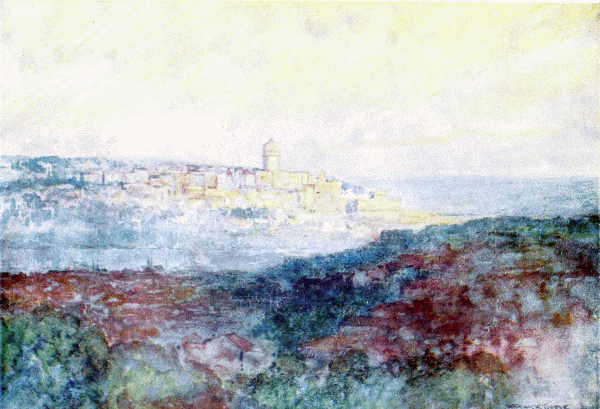
GALATA FROM THE AQUEDUCT OF VALENS
The Galata Tower, which is such a prominent feature from this standpoint, is used as a station for signalling any outbreak of fire, and also the quarter of the city in which it occurs.
This was an excessive partition of power, and proved unsatisfactory. But the view that the welfare of the State required the attention and abilities of more than one ruler was consistently upheld, so long as Western and Eastern Europe formed integral parts of the same dominion.
As a consequence Rome ceased to be the capital of the Empire, even in the ordinary acceptation of the term. For multiplicity of rule involved, necessarily, as many seats of imperial administration as the number of rulers associated in the government of the Empire. Hence, under Diocletian, four cities boasted of being capitals. Furthermore, the selection of what cities should enjoy that honour would be determined by their fitness to become natural parts of the new organisation of the Roman world. Even Rome’s claim to be one of the capitals would be submitted to that test. And when so submitted, the claim of the Eternal City was disallowed even in that portion of the Empire which included Italy, where, for strategic reasons, the choice fell first upon Milan and subsequently upon Ravenna. When it came to the turn of the East to provide suitable seats9 of government, the honours were shared between Singidunum, near the modern Belgrade, and Nicomedia in Asia Minor. But for reasons which will immediately appear, Constantine preferred Byzantium, and, having changed the comparatively insignificant town into a splendid city, named it New Rome and Constantinople, to become the sole centre for the administration of the Eastern portion of the Empire, and the local habitation of the spirit of a New Age.
It would appear that the selection of Byzantium for its great destiny was made after the claims of other cities to that distinction had been duly weighed. Naissus (the modern Nisch in Servia) which was the Emperor’s birthplace, Sardica (now Sofia, the capital of Bulgaria), Thessalonica were thought of for that purpose. They had the recommendation of giving ready access to the Danube frontier, along which the barbarians caused anxiety and demanded close attention. Some consideration was given to Nicomedia, which had already been selected by Diocletian for his capital. It is also said, though without any serious grounds for the statement, that Constantine actually began work for a new city near the site of old Troy, under the spell of the poetic legends which associated10 Ilium with the origin of the Roman people. But the superiority of Byzantium to all rivals was so manifest that there was hardly room for long suspense as to the proper choice. The old oracle, “Build opposite the blind,” which led to the foundation of Byzantium could still serve to guide Constantine in his search for the most suitable position of a new imperial city. There is no place in the wide world more eminently fitted by natural advantages to be the throne of a great dominion, than the promontory which guards the southern end of the Bosporus. There Asia and Europe meet to lay down that antagonism which has made so much of the world’s history, and to blend their resources for man’s welfare. A Power upon that throne, having as much might as it has right, should control a realm extending from the Adriatic Sea to the Persian Gulf, and from the Danube to the Mediterranean. From that point natural highways by sea and land proceed, like the radii of a circle, in all directions where rule can be enforced or commerce developed—to Russia, to Asia, to Africa, to the lands of the West. Its magnificent harbour was fitly named the Golden Horn, for it could be the richest emporium of the world’s wealth. Under no sky can men find a more 11enchanting bower of beauty, or have more readily the charms of nature, the portion and delight of daily life. When Othman, the founder of the Ottoman power, beheld in his dreams this fair city, situated at the junction of two seas and two continents, it seemed to him a diamond set in sapphires and emeralds. Here, moreover, men could dwell secure. Foes advancing through Asia Minor would find their march upon the city arrested by the great moat formed by the Bosporus, the Sea of Marmora, and the Hellespont. The straits just named could be made impassable to hostile fleets approaching from the Euxine or the Mediterranean. While armies which had succeeded in breaking through the barriers of the Danube and the Balkans could be confronted by impregnable fortifications planted along the short landward side of the promontory. “Of all the events of Constantine’s life this choice,” Dean Stanley declares, “is the most convincing and enduring proof of his real genius.” Dr. Hodgkin pronounces it, “One of the highest inspirations of statesmanship that the world has witnessed.”
With these reasons for the choice made by Constantine, personal feelings may have been associated. Such feelings could well play a part12 his attachment to Byzantium as in his detachment from Rome. It was at Byzantium and on the neighbouring heights of Chrysopolis (Scutari), on the Asiatic side of the narrow straits between the two towns, that Constantine had finally defeated his rival Licinius, and brought the Roman dominion under his own rule. To set up his throne amidst the scenes of his crowning victories, where his figure would stand out to view for ever in solitary grandeur, as the inaugurator of a new epoch in the world’s history, was a consideration that would appeal to the feelings of men far less ambitious than the founder of Constantinople.
The long history of Byzantium, since the day when a band of colonists from Megara settled there in 658 b.c., to the day in 328 a.d. when Constantine enlarged the town into New Rome, must not detain us. It was a prosperous little town, much occupied with fisheries, interested in the business of corn and wine, and a port of call for ships trading between the countries bordering the Euxine and the Ægean. It was also celebrated as a fortress, being surrounded by walls of extraordinary strength, which were defended on more than one occasion with great heroism. Situated on one of the principal highways between the East and the West, “even in the force and road of 13casualty,” many of the chief movements of ancient times in either direction passed by its ramparts, and compelled its citizens to take a side in the conflicts of the great powers of the day, and act a part on the field of general history. When Darius I. crossed the Bosporus into Europe to chastise the Scythians in Russia, the town fell under the power of Persia, and remained subject to the Great King until Pausanias, the victor at Platæa, delivered it from that yoke. In the struggle for supremacy between Sparta, Athens, and Thebes, it was controlled now by one of the rivals and then by another of them. It acquired great fame by its resistance to Philip of Macedon, when the star and crescent moon, which have from that time been the device of the city through all changes of fortune, exposed the approach of the enemy and disconcerted his plans. With the rest of the Greek world, Byzantium formed part of the dominion of Alexander the Great. In the war between Rome and Mithridates, it became the ally of the former, and was eventually merged in the Roman Empire. Septimius Severus levelled its splendid walls to the ground, because of its loyal adherence to the cause of his rival, Pescennius Niger. He also deprived it of its higher rank among the towns of the province, making it14 subordinate to Heraclea. But he soon recognised the mistake of destroying a stronghold that guarded one of the great highways into the Empire, and ordered the fortifications to be rebuilt, and the town to be refurnished with temples, theatres, baths, and other public edifices. The subordination of the town to Heraclea, however, was maintained, with the result that the Bishop of Heraclea became the superior of his brother of Byzantium until Constantinople was founded. Then, naturally, the ecclesiastical chief of the new capital took precedence. But in virtue of the higher position held previously by Heraclea, the Bishop of that see acquired the right to preside at the consecration of the patriarch of Constantinople, and retains that right to the present day. So long may a comparatively trifling action leave its mark upon the world’s history.
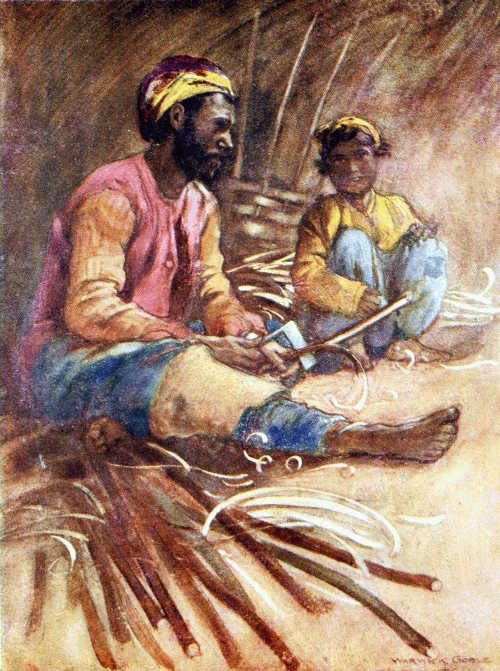
GYPSY BASKET-MAKER
With the knife he is holding he cuts long shavings off the faggots suitable for plaiting into baskets.
In the course of the third century, Byzantium suffered from the raids of the Goths, and in commemoration of the defeat inflicted upon the barbarians by the Emperor Claudius Gothicus at Nissa in 269 a.d., the graceful Corinthian column of granite, which still rises some 50 feet high on the slope above the Seraglio Point, was erected, bearing on its pedestal the inscription, “Fortunæ Reduci15 ob devictos Gothos” (To Returning Fortune, on account of the defeated Goths). Finally, here, as already stated, the struggle between Constantine and Licinius was decided by the fall of the town into Constantine’s hands, after a desperate defence. From all this history of the town, one fact was perfectly clear—the immense strategic value of the place. When Constantine transformed Byzantium into a new capital and a great bulwark of his Empire, he only developed the innate capacities of the site to their natural culmination. Constantinople was Byzantium in flower.
Apart from the advantages offered by its situation, Byzantium had little to recommend it to Constantine’s regard. It presented neither ample room, nor a large population, nor convenient and splendid buildings to favour the rapid growth of a metropolis. Of the tongue of land on which the town stood, only the portion to the east of the line drawn from the present Stamboul Custom House, on the Golden Horn, across to the Seraglio Lighthouse, on the Sea of Marmora, was occupied. In the bay beside that Custom House lay the harbours of the town, where shipping, traders, and merchants did mostly congregate. The Acropolis stood on the rocky hill now enclosed within the Seraglio16 Grounds, and there several temples were found, that gods and goddesses might unite with men in the defence of the citadel. Against the steep side of the Acropolis, facing the blue expanse of the Sea of Marmora and the hills and mountains of the Asiatic shore, two theatres were built, while a stadium lay on the level tract beside the Golden Horn. The huge structure of the Hippodrome, which Severus had begun, was waiting to be completed, and to the north of it were the Baths of Zeuxippus and the adjoining public square which bore the same name. All this did not constitute a rich dowry for the future capital. But perhaps to the founder of Constantinople that fact was not a serious objection; the greatness and splendour of the new city were to be his own creation.
When precisely work upon the new capital commenced cannot be determined, but the year 328 a.d., as already intimated, may be regarded as the most probable date. The circuit of the fortifications which should guard the city was marked out by Constantine himself with solemn ceremonial, and comprised the territory that stretched for nearly two miles to the west of the old town. The north-western extremity of the enclosed area reached the Golden Horn somewhere in the neighbourhood of 17the Stamboul end of the Inner Bridge, while the south-western extremity abutted on the Sea of Marmora, at a point between the districts to which the Byzantine names Vlanga and Psamatia still cling. The most precise indication of the line followed by the landward wall of Constantine is found in the Turkish name Isa Kapoussi (the Gate of Jesus), attached to a locality above the quarter of Psamatia. The name refers to an ancient gateway which stood in the Constantinian fortifications, and survived their disappearance until the year 1508, when it was overthrown by an earthquake. It is mentioned in late Byzantine days as “The Ancient Gate,” and on account of its imposing appearance as “The very Ancient Beautiful Gate” (Antiquissima Pulchra Porta). It was the original Golden Gate or Triumphal Entrance of the city, and, like Temple Bar in London, reminded the passing crowds both of what the city had been, and of what it had become.
The name of the adjoining church, now known as Isa Kapoussi Mesdjidi, probably suggested the Turkish appellation of this interesting and important landmark. The addition made by Constantine to the size of Byzantium was certainly considerable, and the astonishment of his courtiers at the scale of his plans had some ground in reason. But the18 response of the Emperor brings us into closer touch with the emotion which animated the occasion. “I must go on,” said the founder of New Rome, “until He stops who goes before me.” It was a reply in harmony with the declaration made at another time, that he founded the city at the Divine command, jubente deo. The principal agent in a transaction of great moment often feels himself to be the instrument of a higher will than his own, and is haunted by the thought that he builds more wisely than he knows.
Of course a city such as Constantine designed could not be built in one day, but such was the eagerness with which the work was pressed forward, that by the spring of 330 sufficient progress had been made to permit the official inauguration of the capital of the East. The 11th of May in that year was appointed to be the city’s birthday. Never is the region about Constantinople so beautiful as at that season. We can therefore readily imagine the splendour in which earth and sea and sky arrayed themselves to greet the advent of the new queen-city, and to match the state and pomp and joy with which men acclaimed that nativity. In honour of the event there was a long series of popular festivities for a period of forty days, 19besides games in the Hippodrome, free access to the Baths of Zeuxippus, free meals, and liberal gifts of money. For many centuries the anniversary of the day was observed as a public holiday, when the Law Courts were closed and races were held in the Hippodrome. And that the lofty scene of the natal day might be acted over, a gilt statue of Constantine, holding a Figure of the Fortune of the city, was placed in a chariot, and under the escort of soldiers in white uniform and carrying lighted tapers in their hands, was borne round the course to receive the homage of the reigning Emperor and the assembled multitudes. Probably the custom was a reminiscence of a procession in which Constantine himself had taken part on the day of the inauguration of the city.
What the feelings of the “oldest inhabitant” of Byzantium were on that day it is not difficult to imagine. Any regret at the disappearance of ancient and familiar landmarks would be lost in pride for the honour which the old place had received, and in admiration of the magnificence with which it was invested. Moreover, many features of the past had only been transfigured, so that the new was not altogether strange. The Hippodrome, which had stood for more than 13020 years an unfinished pile, was now completed; its seats were packed with spectators, and around its spina, chariots whirled like the wind. The Baths of Zeuxippus kept their place, but enlarged and beautified. The open space to the north of the Baths was converted into a square, surrounded by porticoes, and named Augustaion, after the title Augusta bestowed upon the Emperor’s mother. On the eastern side of the place stood the Senate-House, with a colonnade of six noble columns before the entrance. At the north-western corner of the square was the Milion, whence distances from New Rome were to be measured. To the north, the church dedicated to Irene proclaimed the new faith of the Empire, and told of the peace which had enfolded the Roman world when Constantine became sole Emperor. The ground now occupied by the Mosque of Sultan Achmed, to the east of the Hippodrome, was appropriated for the buildings which were to constitute the imperial palace. The fortifications along the west of the old town had been removed, but instead rose ramparts which could render greater service to mankind, and had a wider outlook upon the world. On the territory within the principal gateway of Byzantium, a forum had been constructed, named after Con21stantine, and there stood a porphyry column, surmounted by his statue watching over the city. The forum, elliptical in shape, was enclosed by a double tier of porticoes, with entrances on the east and the west through fine archways of marble. It was the business centre of the city. Proceeding westwards to the hill now occupied by the Turkish War Office, one came to buildings that recalled the Capitol of Rome; while on the hill now crowned by the Mosque of Sultan Mehemet rose the church dedicated to the Holy Apostles, in and around which the Emperors of Constantinople were to be laid to rest when, in the language of the Byzantine Court ceremonies, the Kings of kings summoned them to appear before Him. Aqueducts and cisterns provided an abundant supply of water for numerous public baths and fountains, as well as for private use. The principal streets were lined with porticoes affording shelter from sun and rain. The sewers ran deep underground. And the waters of a harbour, one of the greatest needs of the city, on its southern side gleamed in the bend of the shore of the Sea of Marmora, where the vegetable gardens of Vlanga Bostan now flourish. It was known, after the superintendent of the works, as the Harbour of Eleutherius.22
Statues, many of them the work of the finest chisels of antiquity, had been collected from all parts of the Empire to make the new capital a museum of art, and to foster the love of the beautiful. Historical monuments also were there, to suggest the continuity between the past and the present, and to rouse the men of a new age to emulate the noble deeds of the old time before them. Of these monuments none was so inspiring as the Serpent Column brought from Delphi to the Hippodrome, upon whose lowest thirteen coils are graven the names of the heroic little States which hurled the Persians out of Greece. No monument stood more appropriately in a city whose supreme task was to resist the encroachments of barbarism upon the civilised world. Scattered over the city were palatial mansions, some erected at the Emperor’s order for personages whom he wished to attract to the new capital, others built by men of wealth and rank who had come of their own accord to bask in the sunshine of imperial favour. Persons belonging to other classes of society had also been attracted in crowds by openings for business, demand for labourers, exemption from certain taxes, and by the free distribution of bread, for which the cornfields of Egypt furnished 80,000 23modii of wheat. After the pattern of Rome, the good order of the city was secured by the division of the city into fourteen wards or regions, of which twelve lay within the walls, and two were suburban. One of the latter, the 13th ward, was on the site of Galata; the other, the 14th ward, the famous suburb of Blachernæ, stood on the hill now occupied by the quarter of Egri Kapou. Both of these extra-mural suburbs were fortified. Each ward had a curator, who attended to the general interests of that portion of the city; a crier or messenger to give public notice to its inhabitants of matters which concerned them; five night watchmen; and a body of men (colligiati) representing the trade-guilds, and varying in number according to the size or importance of the ward, to render assistance in case of fire. After this survey of the new city, the most loyal son of the old town might come to the ancient Strategion—the ground devoted to military exercises (on the level tract beside the present Stamboul Railway Station)—and gladly bow to the decree inscribed on a column erected there, that Byzantium should henceforth be named New Rome.24
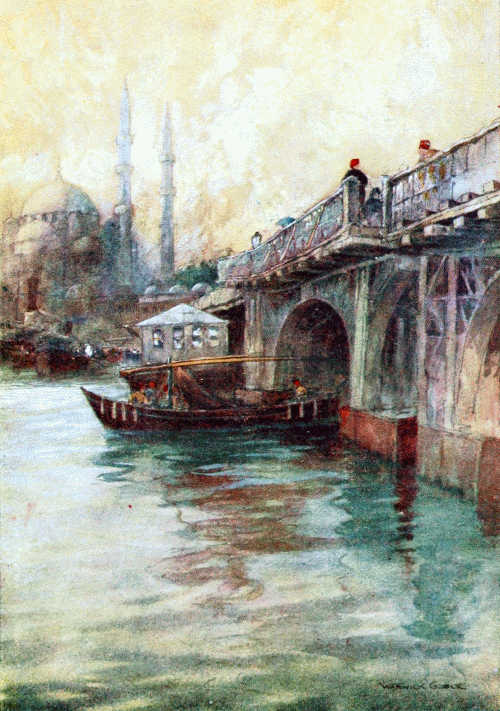
THE GALATA BRIDGE
which spans the Golden Horn at the end near the Bosporus forms the principal link between Galata and Stamboul. It is presented here as seen through a window in a small café on one of the adjoining steamboat quays.
CHAPTER II
the making of constantinople, under the emperors constantius, julian, valens, theodosius the great, and arcadius.
337-408 a.d.
After visiting the sights of Rome, the Persian prince Hormisdas was asked to give his impressions of the city. “One thing disappoints me,” he replied, “men die here just as in the humblest village of the Empire.” So was it in New Rome. Seven years after the inauguration of the city he founded, Constantine the Great died in the neighbourhood of Nicomedia. His body was carried to Constantinople in a golden coffin, and, amid demonstrations of public grief, was laid to rest in a sarcophagus of porphyry in the Church of the Holy Apostles. The tomb was flanked by twelve pillars, representing, so the fact was construed, the glorious company of the Apostles, with whom he could fitly 25be associated as the champion of the Christian faith. The good that men do is, however, not always interred with their bones, and Constantinople remained to attest the far-sighted wisdom of its founder, and to grow in splendour and importance. But one hundred and ten years had to come and go ere the city attained its full stature. It is the history of the growth of Constantinople during this period that will now engage our attention.
Upon the death of Constantine, the eastern division of the Empire came under the rule of his second son, Constantius, who soon discovered how much work upon the new seat of government remained to be done. Nor could his visit to Old Rome fail to impress upon his mind the greatness and the difficulty of the task before him. “Having entered,” says the historian, Ammianus Marcellinus, speaking of that visit of Constantius, “the Forum of Trajan, the most marvellous structure in the whole world, he was struck with admiration, and looked around in amazement without being able to utter a word, wondering at the array of gigantic buildings, which no pen can describe, and which men can create and see but once in the course of centuries. Abandoning all hope of ever being able to erect anything which would approach even at a respectful distance26 Trajan’s work, he turned his attention to the equestrian statue found in the centre of the Forum, and said to his followers that he would have one made like it. Hormisdas, who accompanied the Emperor, quietly remarked, pointing to the Forum, ‘For such a horse, you must first provide such a stable.’”
Nevertheless, Constantius carried forward the improvement of New Rome to such an extent that Themistius, a contemporary, speaking of the Emperor’s services in the matter, declares that the city was indebted to Constantine the Great only for its name, and owed its actual construction to Constantius. During this reign the fortifications of the city were completed, the Church of the Holy Apostles underwent repair, and the Church of S. Sophia, usually ascribed to the founder of the city, was built, the date of its dedication being the 15th of February 360, two years before Constantius died. Constantius, moreover, placed the city, like Rome, under a Prefect—Præfectus Urbis—and, what is worthy of note, endowed the new capital with a library, thus placing in its hand the lamp of learning which was to shine so far in the world’s history. If we may judge by the terms in which Themistius refers to the foundation of this27 library, the value of books was fully appreciated in those days. “Thus,” he exclaims, “the Emperor has recalled and raised from the dead the souls of wise men and of heroes for the welfare of the city for the souls of wise men are in their wisdom, mind, and intelligence, while their monuments are the books and writings in which their remains are found.” The author of the Areopagitica said no more when he declared, “A good book is the precious life-blood of a master spirit embalmed and treasured up to a life beyond life.”
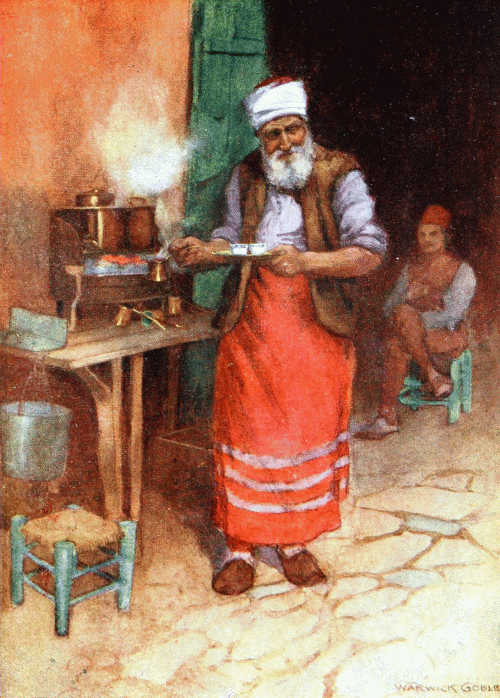
“A KAFEDJI”
Turkish coffee is to be obtained everywhere; a “kafedji” has here set up his little stall at the corner of a street.
Julian, the successor of Constantius, was attached to the city by special ties. It was the place of his birth, and there he had received part of his early education. The school he attended was attached to the Basilica which stood on the site of the Cistern now styled Yeri Batan Serai, a little to the south-west of S. Sophia, and thither he went under the conduct of his pædagogue, Mardonius, to study grammar and rhetoric, dressed simply and associating freely with his fellow-students. His progress in his studies soon became the talk of society, and in public opinion presaged his fitness to become, in due time, the ruler of the Empire. Whereupon the jealousy which besets despotic rule was roused in Constantius, and Julian was banished to Nicomedia.28 But Julian always retained a warm affection for the home of his childhood and youth. Speaking of Constantinople in one of his letters he says, “I love her as my mother, for I was born and brought up there, and I can never be guilty of ingratitude towards her.” Nor had he reason to complain of his Alma Mater’s feelings towards himself. When he approached the city, in 361, to assume the crown, the whole population poured out to meet him, and hailed him with transports of joy as at once their sovereign and fellow-citizen. The young capital acquired a greater sense of dignity and importance at the thought that one who had been cradled within its precincts now occupied the throne of the Roman world. Julian spent only ten months in Constantinople as Emperor, his stay being cut short by war with Persia, whose hostility was not less intense since the chief seat of the Empire had been brought nearer to the frontier between the two States. Into those few months, however, Julian put an immense amount of work. The condition of affairs in his native city was not after his heart, either as a statesman, philosopher, or devotee of the ancient faith of Athens and Rome. There the Christianity he would fain destroy was strongly entrenched. There wrangling sects of the new 29creed, more difficult to appease than the wild Franks and Alemanni, who had felt the strength of his arm upon the banks of the Rhine, kept the population in constant turmoil. There was found an Augean stable of official corruption, of unpunished crimes, of relaxed military discipline, and of extravagant luxury at the court. According to Libanius, a thousand cooks, a thousand hairdressers, more than a thousand cup-bearers, a crowd of waiters, swarming like bees in a hive, and eunuchs, thick as flies in early summer, were employed in the service of the imperial palace. One day Julian sent for a barber, and in answer to the summons an official in a gorgeous uniform made his appearance. “But I called for a barber, not for a receiver-general,” exclaimed the indignant Emperor. An investigation of the case having been made, it was discovered that in addition to a large salary the barber enjoyed the right to many perquisites, and received daily rations sufficient for twenty men and as many horses. Julian swept the palace clean of such abuses. Furthermore, Julian increased the importance of the Senate of the city by the embellishment of the Senate-House, by additional privileges conferred on the members of that body, and by taking part in the deliberations of the assembly. He also30 constructed another harbour on the southern side of the city, placing it in the hollow ground below the heights on which the Hippodrome stands, and thus provided for the convenience and safety of ships that found it difficult to make the Golden Horn from the Sea of Marmora, in the face of the northern winds that prevail in the Bosporus. The harbour was first known as the New Harbour and the Harbour of Julian, but, in the sixth century, it was also named the Harbour of Sophia or the Sophias, in view of extensive repairs made at the instance of the Empress Sophia, the consort of Justin II. The basin of the harbour can still be traced in the configuration of the ground it once occupied, where its memory is preserved by the present name of the locality—Kadriga Limani, the Port of the Galley. At the head of the harbour Julian built a portico, a crescent in shape, and therefore spoken of as the Sigma, from its resemblance to the curved form of that letter in the Greek alphabet. Very appropriately the portico became a favourite lounge of the philosophers in Constantinople, and the scene of their discussions. But what Julian doubtless considered his richest and most filial gift to the city of his birth, was the presentation to its public library of his collection of books.
Valens, the next Emperor concerned with the growth of the city, gave special attention to the water-supply of Constantinople—always a serious question owing to the comparative scarcity of water in the immediate neighbourhood. The picturesque aqueduct which, with its double tier of arches garlanded with ivy, still transports water across the valley between the hills surmounted respectively by the Mosque of Sultan Mehemet and the War Office, was built in this reign. It was an addition to the system of water-supply provided by Constantine; a system which, probably, had previously served the town of Byzantium, and which he only extended and improved. Near the eastern end of the aqueduct a splendid public fountain was placed. The Cistern of the Prætorian Prefect, Modestius, now used as a Saddle-Market, near the Mosque of Sultan Mehemet, belongs to this period; and, as a result of the abundance of water thus introduced into the city, several public baths were erected. The Baths or Thermae of Roman Constantinople, we should remember, are the models of what we style the Turkish bath, and it is a curious fact that this mode of bathing has been continued as a habit of popular life only in countries comprised in the eastern division of the Empire.32
But what, perhaps, makes the reign of Valens chiefly memorable in the history of the city is that in his time the citizens of Constantinople had their first experience of a usurpation of the throne, and of an attack upon their walls.
The former event was brought about by a certain Procopius, a cousin of the Emperor Julian.
Making the most of his relationship to the family of Constantine, he took advantage of the discontent which the administration of Valens had provoked, and having won the populace of the city and a body of troops by means of liberal donatives, seized the palace and installed himself as Emperor. A sharp war with Valens ensued, in which the usurper was at length captured and put to death, while his partizans, and even persons suspected of having favoured his cause, were put to the torture, and had their property confiscated. Thus Constantinople learned—not for the last time—the meaning of a reign of terror. A signal example also was made of Chalcedon (Kadi Keui), on the opposite Asiatic shore, because its inhabitants had sided with Procopius. The walls of the town were ruthlessly torn down, and it was with the material thus made available that the Aqueduct of Valens was built and that the Baths of Constantine were repaired. Yet33 more serious was the quarrel of Valens with the Goths, whom he had permitted to cross the Danube in their retreat before the Huns, and settle in the territory we know as Bulgaria. The officials entrusted with the control of the refugees, and with the duty of providing them with food, did their work with such stupidity and rapacity that the high-minded Goths flew to arms, and, at the close of a struggle extending for upwards of a year, inflicted in 378 an overwhelming defeat upon the imperial forces, outside the walls of Adrianople. The Emperor himself and two-thirds of his army lay dead upon the field. The Roman legions had not known such a disaster since they were defeated by Hannibal at Cannæ. Flushed with victory, the Goths marched upon Constantinople, assailed the walls, and nearly burst the gates open. The honours of the defence fell to the widow of Valens, the Empress Dominica, who, with the money found in the treasury, raised a body of troops among the citizens, arming them with what weapons could be found. A body of Arab soldiers, recently arrived in the city, also rendered valuable aid. Sallying forth, they closed with the Goths in a desperate struggle. Victory wavered between the two sets of barbarians; when, suddenly, a long-haired, almost naked Arab, utter34ing a loud, hoarse, and doleful cry, like a bird of evil omen, rushed upon the Goths, and drawing his dagger, cut the throat of an opponent, and then slaked his thirst at the flowing wound. What with the impression produced by this horrid incident, added to a growing sense of the impossibility of their taking a fortified place, the Goths gave up the contest and retired from the city. This was the first siege of Constantinople.
With the accession of Theodosius I., a brighter day dawned upon the Empire. He not only subdued the Goths, but converted them into allies, and persuaded them to put 40,000 of their brave troops at his service. He even induced their aged king, Athanaric, who had sworn never to set a friendly foot upon Roman soil, to visit Constantinople. The visitor was profoundly impressed by the appearance of the city. “Now,” said he, “I see what I often heard of, but never believed, the renown of this great city.” Then, surveying the city’s situation, the movement of ships coming and going, the splendid fortifications, the crowded population made up of various nationalities, like streams coming from different directions to gush from the same fountain, the well-ordered troops, he exclaimed, “Verily, the Emperor is a god upon 35earth; whoso lifts a hand against him is guilty of his own blood.” Upon the death of Athanaric, which occurred about a fortnight after he reached Constantinople, Theodosius buried the body of his guest with royal honours in the Church of the Holy Apostles, and, by this act of chivalrous courtesy, bound the Goths more firmly to his side.
The barbarians, however, were by no means the only disturbers of the peace of the Empire with whom Theodosius found it necessary to deal. Society in the Roman world was distracted by the conflict between pagans and Christians on the one hand, and by the keener strife between Christian sects on the other, and it was the ambition of Theodosius to calm these troubled waters. For this laudable end he employed the questionable means of edicts for the violent suppression of heathenism and heresy. To destroy the old faith of the Empire was comparatively an easy task, although it involved him in a war with the pagan party in the West. But to uproot the tares of heresy was a more formidable undertaking; they were so numerous, vigorous, and difficult to distinguish from the true wheat. For the space of forty years, the views of Arius on the Person of Christ had prevailed in Constantinople, and the churches of the city were36 in the hands of that theological party. Only in one small chapel, the Church of Anastasia, was the Creed of Nicæa upheld there by Gregory of Nazianzus, and despite his eloquence he was a voice crying in the wilderness. But Theodosius, having been won over to the Nicene Creed, determined to make it the creed of the State. Accordingly, upon his arrival in Constantinople on the 20th of November 380, he sent for Demophilus, the Arian bishop of the city, and commanded him either to accept the orthodox views or leave Constantinople. Demophilus had the courage of his convictions, and, bidding his flock in S. Sophia farewell, left the capital in obedience, as he said, to the injunction, “When they persecute you in one city, flee ye to another.” All the churches of the city were now transferred to the orthodox party. The Arians, however, maintained religious services according to their own tenets outside the city walls, in the district known as the Exokionion (quarter of the outside column). The name was due to the presence there of a column surmounted by a statue of Constantine. Owing to their association with the district, Arians were sometimes designated Exokionitæ. The district lay immediately outside the gateway in the Constantinian walls already noted as the Ancient 37Gate of late Byzantine times, and as Isa Kapoussi since the Turkish Conquest. It can therefore be readily identified, and, curiously enough, under the disguise of a Turkish garb—Alti Mermer, the Six Marbles—the locality still retains its old name. For the Turkish designation is due to a misunderstanding of the meaning of the term Exakionion, a corrupt form of Exokionion frequently employed by Byzantine writers.
In pursuance of his religious policy, Theodosius furthermore convened at Constantinople an assembly of 355 bishops, known as the Second General Council, to reaffirm the Nicene Creed as the true Catholic faith, and to restore the orthodox character of the capital of the East. At this Council, the question of precedence between the Sees of Rome, Antioch, Jerusalem, Alexandria, and Constantinople, which awakened burning jealousies in the Christian world, was finally settled. The first place was assigned to the Bishop of Rome, the prestige of the ancient capital asserting itself, but the second place was given to Constantinople, because it was New Rome, notwithstanding the closer connection of the remaining rival Sees with the earlier history of the Christian faith. In this decision, political reasons outweighed religious considerations.38
But while thus occupied with high matters of Church and State, Theodosius did not forget the embellishment of his capital. On the contrary, what Theodosius did for that object, and left to his son and grandson to complete, entitles him to be regarded as the second founder of Constantinople. Under his auspices, a great forum, named the Forum of Theodosius and the Forum of Taurus, was constructed on the summit of the hill now occupied by the Turkish War Office. It was the largest forum in the city, and there Theodosius erected a hollow column, columna chochlis, similar to the column of Trajan and the column of Marcus Aurelius at Rome. For better or worse, the desire to emulate Rome was always an ambition of the young capital. Around the exterior of the column winded a spiral band of bas-reliefs commemorating the exploits of the Emperor, while the stairway within led to his statue on the summit. Up that stairway, the Emperor Murzuphlus was taken to the top of the column by the Crusaders of the Fourth Crusade after their capture of the city in 1204, and then barbarously hurled to the ground. Certain persons, who became wise after the event, then pointed to a figure represented on the column as falling from a high turret, and read there the39 prophecy of this outrage upon humanity. The column was taken down by Sultan Bajazet II. (1481-1512) to furnish material for the bath he constructed in the vicinity. So does glory vanish. To the forum was attached, as usual, a Basilica, the Basilica Theodosiana, 240 feet long by 140 wide, remarkable for twelve marble columns 25 feet in height. To the same Emperor is also ascribed a lofty pyramidal structure, in or beside the forum, surmounted by a movable bronze figure to indicate the direction of the wind, and appropriately named the Anemodulion. Judging from the descriptions we have of it, the edifice displayed considerable artistic taste. Upon it stood, in characteristic forms, the statues of the twelve winds on the list of ancient meteorologists. There, one could hear youths blowing trumpets, see laughing Cupids pelting each other with apples, and admire wreaths of foliage, flowers, and fruit. It recalls the Temple of the Winds at Athens. Another erection of the time of Theodosius was the Golden Gate which was subsequently incorporated in the fortifications built by his grandson and namesake, Theodosius II. It was originally designed as a triumphal arch to celebrate the victory of Theodosius I. over Maximus, who had usurped the throne of the western division40 of the Empire, and through that archway Theodosius passed three years later, when he returned to Constantinople in triumph. Like similar monuments, the Golden Gate consisted of three arches, the central arch being loftier than its companions, and was decorated with statues of the Emperor, Victory, the Fortune of the city, and a group of elephants in bronze. Upon the two fronts of the central arch was a Latin inscription in gilt metal letters, gleaming like a crown of gold upon the head of the gateway. The legend, “Theodosius adorns this place, after the doom of the usurper,” looked towards the west; while the words, “He who constructed the Golden Gate brings in the Golden Age,” faced the east. When incorporated in the fortifications of Theodosius II., the Golden Gate served as the State entrance to the city.
Another monument of the city due to Theodosius is the obelisk which still keeps its place, as though the symbol of eternity, amid the ruins of the Hippodrome. It was brought from Egypt before the Emperor’s reign, but was successfully placed in position under his auspices, and two inscriptions, one in Latin, the other in Greek, record the pride which the achievement excited. They read to the effect that what others had vainly attempted was 41accomplished by Theodosius during the prefecture of Proclus—the time taken being thirty days according to the Latin legend, thirty-two days according to the Greek version.
The bas-reliefs of the pedestal on which the obelisk stands, however little they flatter the art of the period, are extremely interesting for the glimpses they afford us of life in Constantinople under Theodosius I. Any one who wishes to look upon the events of that distant day, and cares to breathe the atmosphere in which his fellowmen then lived, should come and linger before these weather-worn figures in which the Past is perpetuated. They are not of “Attic shape”; they have not the “fair attitude” of “the brede of marble men and maidens,” with which Grecian urns were overwrought. Nevertheless, they too set the permanent against the transitory scenes of our human history. Here the obelisk is still being dragged through the city to the Hippodrome amidst the deafening shouts of an enthusiastic population; it is still hoisted in breathless silence and suspense from the ground, and set firm upon its base to stand erect for these fifteen centuries. Here four-horse chariots are still driving furiously around the spina of the race-course; the banners of the Factions42blue, green, white, red—still wave frantically in the air; the crack of whips, the cheers of spectators, urging steed and driver onward and faster, may still be heard; the acclamations, the strains of music, the joyous dance, the wild frenzy when the Emperor crowns the victor’s brow with laurel still rend the air. Theodosius, his Empress, his two sons, Honorius and Arcadius, still stand or sit before us. Here are the senators of New Rome, and the courtiers in attendance upon the Emperor. Barbarians, eastern and western, are here doing homage on bended knee to their conqueror, and offering him tribute. Here are the Gothic troops which Theodosius subdued and won to his side, wearing their golden collars, and guarding him with spear and shield. Here the people of the city hold colloquy with their sovereign through the tall heralds—mandatores—who stand on the steps leading to the imperial tribune. Here Christianity with the Labarum in its hand triumphs, and in the Greek and Latin speech inscribed upon these stones we still listen to the voices that mingled in the Græco-Roman world.
Other works of Theodosius could be mentioned, such as the improvement of the Harbour of Eleutherius (at Vlanga Bostan), and the palaces erected 43for the accommodation of members of the imperial family. But perhaps we shall obtain a more vivid impression of the extent to which the growth and improvement of Constantinople were due to this Emperor, from the impression which the changes he introduced made upon the mind of a contemporary who had known the city from the days of Constantius. “No longer,” exclaims Themistius, as he surveys the altered aspect of the place, “no longer is the vacant ground in the city more extensive than the ground occupied by buildings; nor is the land under cultivation within the walls more than that which is inhabited. The beauty of the city is no longer scattered over it in patches, but is now continuous throughout its whole area, like a robe finished to the very fringe. The city is resplendent with gold and porphyry; it boasts of a new forum, named after the Emperor; it is provided with baths, porticoes, gymnasia, and what was its former extreme limit is now its centre. If Constantine could see the city he founded, he would look upon a glorious and splendid scene, not upon a bare and naked void; he would behold it fair, not with apparent, but with real, beauty.” The mansions of the wealthy were now larger and more stately; the suburbs also had grown. “The city,”44 continues the orator, “is full of carpenters, builders, decorators, and every other class of artisans, so that it might fitly be described as a workshop of magnificence. Should the zeal of the Emperor to adorn the city continue, a wider circuit will become necessary, and the question will arise, whether the city added to Constantinople by Theodosius does not excel in splendour the city which Constantine added to Byzantium.”
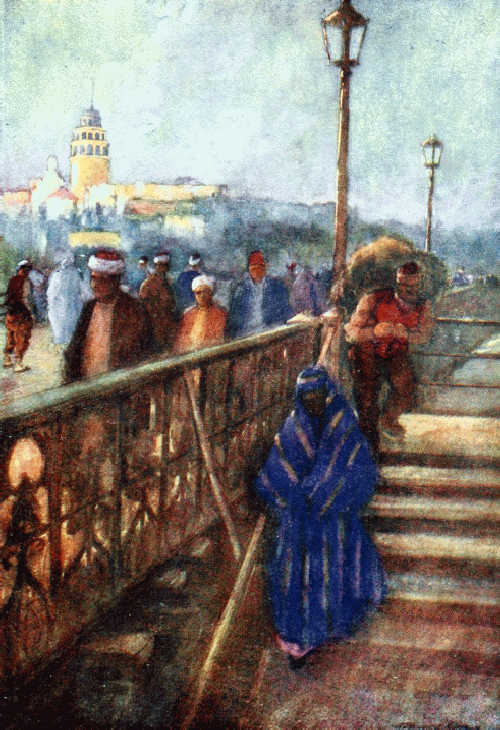
GALATA TOWER FROM THE BRIDGE
The stairway down which the Turkish lady is hurrying leads to one of the many steamboat piers adjoining the bridge.
In the reign of Arcadius, events of great moment in the history of the city occurred. In the first place, the government of the Empire, which had been in the hands of Theodosius alone for a few months, was now again divided between his sons, the West falling to Honorius, the East becoming the dominion of Arcadius. This proved the final division of the government, and prepared the way for the ultimate sundering of Europe into two worlds. For it stimulated a conflict of interests and occasioned a warfare of intrigues that strengthened the tendency for the parts of the Empire to fall apart and form, practically, distinct States. Thus, however, the individuality and independence of Constantinople came to be clearly and fully asserted. In the next place, under Arcadius, the question how far Constantinople and the Balkan lands were45 to remain under the control of the Germans settled to the south of the Danube reached its most critical stage. Would the East be Teutonized, as the West was destined to be? Was the unity of Europe to assume a Germanic form after the old Roman unity was broken? There were moments in the reign of Arcadius when the signs of the times indicated that the same destiny awaited both divisions of the Empire. Alaric, at the head of the Visigoths, was ravaging the Balkan peninsula, and seemed ready to establish a permanent kingdom there. Constantinople was full of Germans. A fair-haired German lady, the Empress Eudoxia, shared the throne of Arcadius. Germans were largely employed as workmen and as household servants. Germans demanded liberty to worship in a church within the walls, according to the Arian views introduced among them by Ulfilas. Chrysostom, opposed their demand, and carried on a mission for the conversion of the Goths in the city to the orthodox faith. The politicians of the capital were divided into a Roman and a German party. Gainas, a Goth, was in command of the army, and had become all-powerful. At his instance, Rufinus and Eutropius, successively chief Ministers of the Government of Arcadius, were46 put to death. He incited the Ostrogoths settled in Asia Minor to rebel, and brought them over to Europe to support his ambitious plans. He filled Constantinople with Gothic soldiers, and twice attempted to burn down the palace. And when, in view of the precautions taken against him, he found it prudent to quit the city, it was with the idea of returning with a larger force to make himself the master of the place. His plan failed, as such schemes often fail, through an accident of an accident. A Gothic soldier treated a poor beggar woman roughly; a citizen took her part and struck the assailant dead. In the condition of the public mind, this proved the spark which produces a tremendous explosion. The city gates were immediately closed and the ramparts manned, while an infuriated mob went through the city hunting for Goths, and did not cease from the mad pursuit until the blood of 7000 victims had stained the streets of the city. Gainas was pursued and defeated, and eventually his head was sent to Constantinople by the Huns among whom he had sought refuge. This, indeed, did not put all further trouble at the hands of Goths to an end, but it was the knell of German domination in Constantinople and the East. The reign of Arcadius is the water47shed upon which streams, which might have flowed together, separated to run in opposite directions and through widely diverse scenes of human affairs. The inscription, “ob devictos Gothos,” upon the column of Claudius Gothicus now acquired a deeper meaning.
But one cannot think of the reign of Arcadius without recalling the fact that for six years of that reign Constantinople was adorned by the virtues, and thrilled by the eloquence, of John Chrysostom. Although popular with the masses, he provoked the bitter hostility of the Court and of a powerful section of the clergy, by his scathing rebukes of the frivolous and luxurious habits of fashionable society, and by the strictness of his ecclesiastical rule. He had the misfortune to quarrel with the ladies of the city, including the Empress, for their extravagance and looseness of manners. Ladies of fashion, for instance, saw nothing unbecoming in taking a swim in the public cisterns of the city. A sermon, preached while a statue of the Empress was being inaugurated close to the cathedral of S. Sophia, filled the cup of his offences. It may not be true that in the course of the discourse he compared the Empress to Herodias demanding the head of his namesake, John the Baptist. But48 whatever the precise form of his words, he said enough to exasperate her to a degree that made her insist upon his final banishment, notwithstanding all the popular opposition to that step. By a strange fate, the pedestal of the column which bore the statue still remains, being now placed for safe keeping within the railing that encloses a narrow strip of ground on the northern side of the Church of S. Irene, in the first court of the Seraglio. A Latin inscription upon it records the erection of the monument in honour of Eudoxia, ever Augusta, by Simplicius, the Prefect of the city; while an inscription in Greek adds the information that the statue was of silver, the column of porphyry, and that the monument stood near the Senate-House.
Notwithstanding, however, the anxieties of the period, the improvement of the city continued to go forward. The splendour of the Court was increased by the erection of four princely mansions, placed respectively at the disposal of the Empress and her three daughters, Arcadia, Marina, and the famous Pulcheria. New Thermæ were built, one of them, the Thermæ Arcadianæ, situated near the Sea of Marmora on the level tract below S. Irene, being a great ornament to the city. A more abundant supply of water was secured by the con49struction of the large open reservoir, whose basin, 152 metres square, now occupied by vegetable gardens and houses, is still seen to the south-west of the Mosque of Sultan Selim, above the quarter of the Phanar. But the most notable addition to the equipment of the capital was a great forum placed upon the summit of the Xerolophus, the hill at the south-western corner of the city. It was commonly known as the Forum of Arcadius, but sometimes also as the Forum of Theodosius, on account, probably, of additions made to it by Theodosius II., the son and successor of Arcadius.
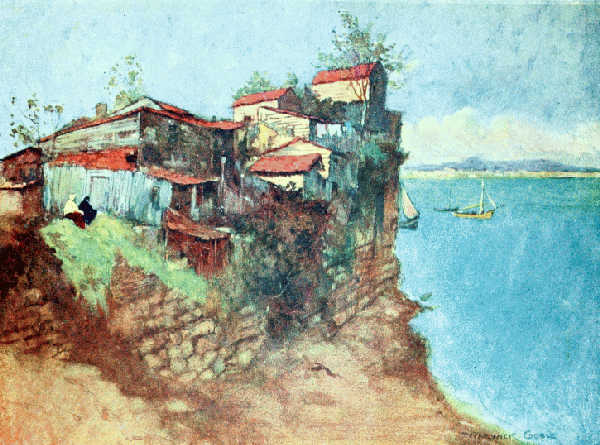
REFUGEE HUTS ON THE MARMORA
This pile of huts is perched on the old seaward walls overlooking the Sea of Marmora. Petroleum cans are largely used for building material.
As usual, the forum was surrounded by porticoes and adorned with many statues; but its chief ornament was another lofty hollow column similar to that in the Forum of Theodosius I., thus furnishing the city with the same number of that class of columns as Rome possessed. On the summit of the monument stood the statue of Arcadius, and the procession of sculptured figures that winded their way around the shaft to his feet celebrated his victories over the Goths. The column held its place, in spite of storms, earthquakes, and fires, until 1715, when, threatening to fall, it was taken down as far as its pedestal, for the safety of neighbouring buildings. But it was inspected by many50 European visitors to Constantinople previous to that date, with the fortunate result that we have drawings and descriptions of the monument which allow us to form some adequate idea of its general appearance and artistic merits. It stood upon a platform of three steps, the uppermost step being 33½ feet square. The pedestal, a hollow cube, rose 26 feet high, each side consisting of six huge blocks of marble. Along its upper portion it was adorned profusely with wreaths, eagles, genii, and other usual forms of architectural decoration, while the eastern, western, and southern sides were covered with triumphal scenes in bas-relief. “Along the highest part of the pedestal, on the southern side,” says the traveller Wheler, “one sees the Labarum in a wreath held by two Victories. Below it, are the Emperors Arcadius and Honorius, in honour of whom the column was erected, with two Victories crowning them in presence of a crowd of senators. Still lower down, in a third line, appear Victories contending with one another, and several figures wearing mural crowns, representing the cities conquered by the armies of the two Emperors.” From the pedestal to the summit of the column 23 drums of marble, so well joined as to seem one piece of 51stone, soared some 121 feet higher to give the monument a total altitude of 146 feet. The figures on the upper part of the shaft were larger than those nearer the ground, so as to appear of the same size as the latter when seen from a distance. The hollow shell of the shaft was 28 feet round, and from 2 feet to 1¾ foot thick, the thickness diminishing as the shaft ascended. From the door in the northern side of the pedestal 233 steps, lighted by 50 lights, led one through the shaft to a door opening upon the abacus of the capital, a platform 17¾ feet square, from which to survey securely the glorious panorama presented by the great city below, and the surrounding landscape of sea and islands and mountains.52
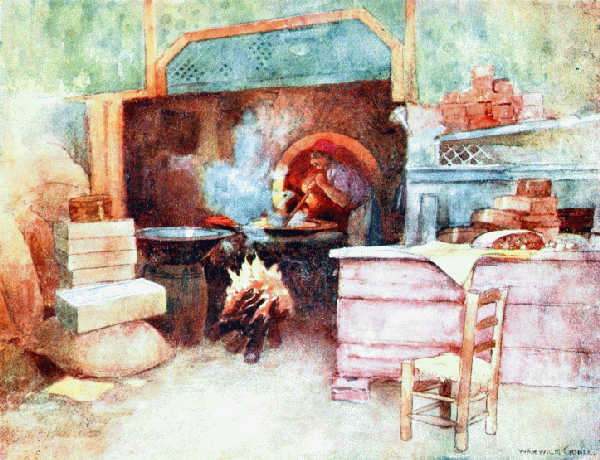
TURKISH DELIGHT FACTORY
The contents of the large copper pans are kept stirring for two hours or more over a wood fire; various flavourings are added during this process according to the result desired; those mostly in use are essence of almonds, vanilla, rose leaves, almonds and pistachios.
CHAPTER III
the making of constantinople under theodosius ii.
408-447 a.d.
Such ornamental public works, as have been described, were, like the blossoms on a plant, indications of the general growth and flourishing state of the city. In point of fact, we learn from historians of the times that the population increased at an extraordinary rate, and put a severe strain upon an adequate supply of food and of sufficient accommodation. The ships importing wheat from Egypt, Asia Minor, Syria, and Phœnicia had all they could do to provide enough bread for the hungry multitudes of the new capital. The dwellings in the city were so closely packed, that the inhabitants, both at home and out of doors, felt cribbed, coffined, and confined. The narrow streets were so encumbered with beasts of burden 53carrying building material in all directions, that it was dangerous to walk abroad. Ground for building had become so scarce that land had to be made by filling in portions of sea along the shores of the city, and the houses on that artificial ground alone formed a considerable town. And so the time came when it was no longer possible to keep the city within the bounds prescribed by its founder, and measures had to be taken to give Constantinople the size and strength required by the altered circumstances of its history. This was done in 413, early in the reign of Theodosius II., and eighty-five years after the foundation of the city. The western limits of New Rome were then carried to the line of fortifications, whose ruins, like veteran warriors loth to quit their post, stretch to-day from the Sea of Marmora to the old Byzantine Palace, known by the Turkish name Tekfour Serai. At the latter point the new bulwarks joined the walls which guarded the outlying 14th ward, the suburb of Blachernæ, and thus enclosed the city down to the Golden Horn. By this change the area of Constantinople was almost doubled, and reached its final size. Any additions to the dimensions of the city after 413, as in the 7th century when the54 tract now occupied by the quarter of Aivan Serai was enclosed, or again in the 11th century when the Palace of Blachernæ was protected by new ramparts, were extremely insignificant additions, and were made not for the sake of obtaining more room but for strategic reasons.
This extension of the city’s limits involved, of course, the erection of new fortifications. Indeed the demand to make the capital of the East a mightier stronghold was not less urgent than the necessity to enlarge its borders. No statesman of the 5th century of our era could fail to realise the formidable character of the barbarian peril which then lowered over the Empire. A period in which an Alaric, an Attila, a Genseric, insulted the majesty of the Roman name, and trampled upon Roman strength, a period in which the Eternal City was captured and sacked, in which Carthage was lost, and the original fabric of the Empire in the West was levelled to the ground, must have been a time when the minds of serious men were troubled by fears and anxieties. These disasters necessarily cast, ere they came, long and dark shadows before them.
Most fortunately for the eastern division of the Empire it had, early in this critical period, a states55man at the head of the Government who comprehended the situation, and who had the sagacity to devise measures by which the strength of the impending storm might be greatly reduced, if not broken. During the first six years of the reign of Theodosius II., who ascended the throne when a child of eight years, the government was in the hands of Anthemius, the Prætorian Prefect of the East. His abilities and character had already made him conspicuous towards the close of the reign of Arcadius. Chrysostom admired him greatly, and described him as a person who honoured any office he held more than the office honoured him. And now that he was Regent of the Empire he did all in his power to prepare the ship of State to encounter the coming tempest. His first step for that purpose was to establish peace with Persia, the standing rival and foe of the Empire. In the next place, he forced the Huns who had appeared to the south of the Danube to retrace their steps, and placed a flotilla of warships upon the river to prevent the return of those fierce barbarians. At the same time he strengthened also the Illyrian fortresses to render the north-western frontier more secure. Then, warned by a bread riot in Constantinople due to a scarcity of wheat in the city,56 he made arrangements for a more regular supply of grain from Egypt, thus making the population of the capital more friendly to the Government. And lastly, as the crowning act of his administration, he decided to array the city in new and better armour, and make it the strongest citadel in the Roman world. The great wall, flanked by ninety-six towers, which forms the innermost line of the fortifications along the landward side of the city, notwithstanding the changes it has undergone since his day, is even in its ruins, a magnificent monument to his wisdom, and to his devotion to the public weal. Those ramparts proved the shield of European civilisation for more than a thousand years. Their erection was one of those great acts in history which confer priceless benefits on mankind.
The change made by Anthemius in the position of the landward walls involved also the extension of the seaward fortifications to join the extremities of the new western limits. But, although that work must have been included in the plans of Anthemius, it was postponed for no less than a quarter of a century. Lack of funds, or the demands of more urgent necessities, or that happy sense of security from naval attack, in which the Government of Constantinople was tempted to indulge, in view 57of the city’s geographical position, may account for the delay. But whatever the explanation of the postponement, the gap in the defences of the capital could not be left open indefinitely, and at length, in 439, the thirty-first year of the reign of Theodosius II., the shores of the city were enclosed by Cyrus, the then Prefect of the city. It was the year in which the Vandals took Carthage, and possibly the alarm excited by their successes in Africa roused Constantinople to defend itself at every point.
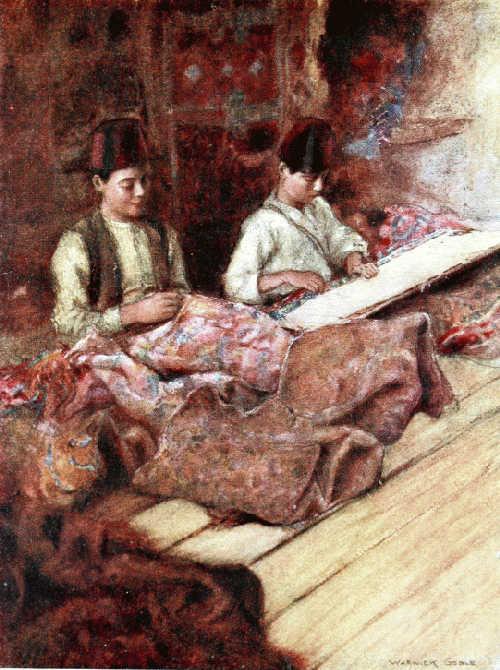
CARPET-MENDERS
These boys are engaged in patching up the holes in old carpets; they are very skilful in matching the faded colours that are so highly prized in the genuine antique.
Scarcely, however, had the city girded on its full armour, when, in the year 447, one of those violent earthquakes, to which Constantinople was liable, shook the city, and overthrew a large portion of the wall of Anthemius, with fifty-seven of its towers. The seaward walls of Cyrus were also injured at the same time. Struck with panic, the population rushed from the city to the open country, as far away as the plains about the suburb of the Hebdomon (Makrikeui), and there, with Emperor, Senate, and clergy, offered prayers and supplication that the quaking earth should keep still. It was a terrible catastrophe under any circumstances, but it was the more so at the moment when Attila was sweeping everything before him in his advance upon the city.58 The crisis was, however, met with extraordinary energy. Under the direction of the Prefect Constantine (whom some authorities identify with Cyrus) the calamity which had overtaken the city was turned into an opportunity of building more formidable fortifications than those which had been destroyed. Requisitions of money and materials were made upon the citizens, and the Factions of the Hippodrome now vied with each other in the race to build the most and the fastest. Not only was the wall of Anthemius repaired, but at a distance of about twenty yards in front of it was placed a second wall, also flanked with ninety-six towers, and then at a distance of some twenty yards from the latter line a broad and deep moat was constructed, with a battlement breast-high surmounting its inner side. So vigorously was the work pressed forward that the second wall was completed in two months. Thus, the capital stood behind a barricade 190-207 feet thick and 100 feet high, comprising four lines of defence, that rose tier above tier to permit concerted action, with ample room for the operation of large bodies of troops, and affording numerous points of vantage from which to pour upon an enemy every missile of death in the arsenal of ancient warfare—arrows, stones, and Greek fire. If men did their duty, the59 city was now impregnable, while the Prefect Constantine earned the right to be associated with Anthemius, as one of the forgers of the weapons with which Constantinople defended the higher life of mankind against the assaults of barbarism for ten centuries. Two inscriptions on the Gate Yeni Mevlevi Khaneh Kapoussi (the ancient Gate of Rhegium)—one in Greek, the other in Latin—have proclaimed the services of the Prefect Constantine from his day to the present time. “In sixty days, at the command of the sceptre-loving Emperor, Constantine the Eparch built wall to wall,” says the former in modest terms. The Latin legend breathes the pride and satisfaction which the work inspired. “By the commands of Theodosius, the second month not being completed, Constantine set up these strong fortifications. Scarcely could Pallas have built so quickly so firm a citadel.”
But the erection of the new walls of the capital was not by any means all the building done in Constantinople during the reign of Theodosius II. The area added to the city naturally offered a wide field for further construction. Much damage caused to the older portions of the city by frequent fires and repeated earthquakes in the course of the Emperor’s reign, or shortly before it, had also to be60 made good. The Church of S. Sophia, and probably the adjoining Senate-House, now rose from the ashes to which they had been reduced when Chrysostom was exiled. The Baths of Achilles and the Public Granaries in the vicinity, destroyed in the fire which burnt down the quarter now marked by the Stamboul Custom House, were likewise rebuilt at this time. To the ornaments of the Hippodrome were now added the four gilt bronze horses of Lysippus, which to-day adorn the Church of S. Mark at Venice, whither they were carried as trophies of the capture of Constantinople, in 1204, by the fleet of the Doge Henrico Dandolo.
In this work of city improvement no one made himself so prominent as the Prefect Cyrus, already mentioned as concerned in the fortification of the shores of the city. He was a poet, a student of art and architecture, and, if not a pagan, strongly imbued with the spirit of the old faith. Moreover, he was distinguished for great integrity, a rare virtue among the officials of the day, and, in consequence, had been appointed simultaneously Prætorian Prefect of the East and Prefect of the city four times. It was doubtless with the view of checking corrupt practices that he restricted the powers of the Prefect of the city in the administration of the 61municipal revenues. Among the improvements he introduced, the proper lighting of shops in the evening is mentioned. His character and services made him immensely popular; but the fact did not make him happier. The dread of the fickleness of fortune ever cast its shadow over his mind, and he was often heard to say, “I do not like Fortune when she smiles much.” At length, his worst fears were realised. Taking his seat one day in the Hippodrome, he received a great ovation from the vast crowds assembled to witness the races. “Constantine,” they shouted, “founded the city; Cyrus has restored it.” Never had the capricious goddess smiled so benignantly upon him, and never did she prove more treacherous. Such popularity offended Theodosius, and he decided to break the idol of the people to pieces. Cyrus was dismissed from office, deprived of his property, and reduced to a political nonentity, by being consecrated Bishop of Smyrna or of Cotæum in Phrygia. Such a proceeding appears very strange, but probably we are ignorant of facts which would explain this transformation of a pagan official into a Christian priest. One can hardly believe that a man like Cyrus was insincere in his new character.
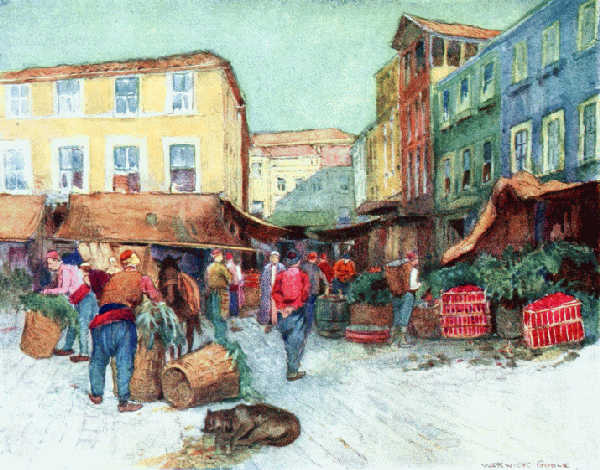
FRUIT-MARKET, STAMBOUL
The street dogs always select the busiest and most inconvenient places for resting.
The post assigned to the ex-Prefect was not62 attractive. Four of his predecessors in the diocese had been murdered by brigands, and the people committed to his care doubted the soundness of his faith. But in a sermon preached on Christmas Day he conciliated his flock by orthodox statements, pointing out at the same time that the mystery before their minds was most honoured by silence. And he died unmolested by robbers. It is curious to observe, in passing, how punishment here assumes a religious form, and how men tried to hide their cruelty under the pretence of doing good to the souls of their victims. In the subsequent history of Constantinople, this species of penalty became common. It was a symptom at once of the mildness and the meanness of the times.
But the reign of Theodosius II. is not distinguished only for the material growth of Constantinople. It is not less memorable for the advance of the city in its intellectual character, as the nursery of learning and the seat of justice. In this reign the University of Constantinople was opened. It found a home in the building known as the Capitol, on the hill now occupied by the Turkish War Office. Judging from the descriptions we have of the building, it resembled in its arrangements a Turkish theological school,63 medresseh,—an open court, surrounded by class-rooms on the level of the court. Some of the rooms were spacious halls, richly decorated, and accommodating large audiences. The studies pursued were chiefly grammar, rhetoric, and literature, both in Latin and in Greek, there being thirteen professors for these studies in the former language and fifteen in the latter. To philosophy only one professor was assigned, while the department of law was in charge of two professors. In the charter, so to speak, of the University, particular stress is laid upon the need of a separate class-room for each teacher, lest the different classes should disturb one another by simultaneous talking and variety of languages, with the result that the ears and minds of the students would be diverted from their proper occupation. A candidate for a professor’s chair was required to undergo an examination before the Senate both as to his learning and his character. After twenty years’ service a professor was rewarded with the title of a Count of the Empire. Only the professors attached to the University were allowed to lecture in public, and they were not permitted to give private instruction. The foundation of the University had two objects mainly in64 view—to prepare young men for the civil service, and to supersede the pagan schools of learning. It had certainly a lofty ideal, for, in the language of an inscription that refers to the institution, it was to be “a glory to scholars, an ornament to the city, the hope of youth, weapons to virtue, and wealth to the good.” Thus, while the shadows of ignorance were gathering to settle down upon western Europe, the light of knowledge was kept burning in the capital of the East until the darkness passed away. The study of Latin indeed was erelong abandoned in Constantinople, but Greek learning had always its friends there, who handed that treasure down from century to century, and bequeathed it at last to safer keeping and wider use.
Another act that does honour to the reign of Theodosius II. is the codification of the laws enacted since the time of Constantine the Great. The compilation took nine years to be made, and is known as the Theodosian Code. How great a need it supplied is quaintly set forth in the preamble to the Code. “The chaos presented by the state in which the laws were found was such that few persons had an adequate knowledge of the subject, even though their faces have grown pale from late lucubrations.” “When we consider,” to quote 65Professor Bury’s translation, “the enormous multitude of books, the divers modes of process, and the difficulty of legal cases, and further the hugeness of imperial constitutions, which, hidden as it were under a veil of gross mist and darkness, precludes men’s intellects from gaining a knowledge of them, we feel that we have met a real need of our age, and, dispelling the darkness, have given light to the laws by a short compendium.”
On 23rd December of the year 438, the Code compiled at Constantinople was presented to the Senate of Rome and recognised by that body. It was a curious reversal of the part which the elder city had acted in the world. The teacher had become the pupil. Or is it truer to say, the pupil then did homage to the teacher? The Theodosian Code was superseded by the Code of Justinian the Great, but the earlier compilation retains the honour of being the first great legal instrument to confer upon New Rome the distinction of becoming the tribunal which has guided the most civilised nations of the world into the paths of righteousness and justice in the dealings between man and man. Into the religious controversies which agitated Constantinople while Theodosius II. was upon the throne, this is not the place to enter. But Con66stantinople would not have been itself without a hard theological problem to discuss, if not to solve, and we do not know the soul, so to speak, of Constantinople unless we recognise what may be termed the religious temperament of the city. At a period, indeed, when a great religious revolution in the faith of men had taken place, and men were called to make clear to themselves what exactly they believed, and how their beliefs were to be harmonised with their philosophy and the general principles of reason, religious questions could not fail to be prominent everywhere. They were as naturally prominent in the fourth and fifth centuries of our era, when Christianity became the religion of the State, as they were at the time of the Reformation. But Constantinople made these questions peculiarly its own. It could not well be otherwise where the seat of the chief bishop of the Church in the East was found, and in the capital of a Government which concerned itself in these debates as matters of political importance. Nor can it be denied that in the discussion of the subjects before the public mind we often witness great intellectual acumen, and a profound religious spirit. Able and pious men anxiously sought to reconcile faith in the unity of the Divine, 67with faith in the intimate oneness between the Divine and the human manifested in the life of Christ. No age is dishonoured by keen interest in that theme.
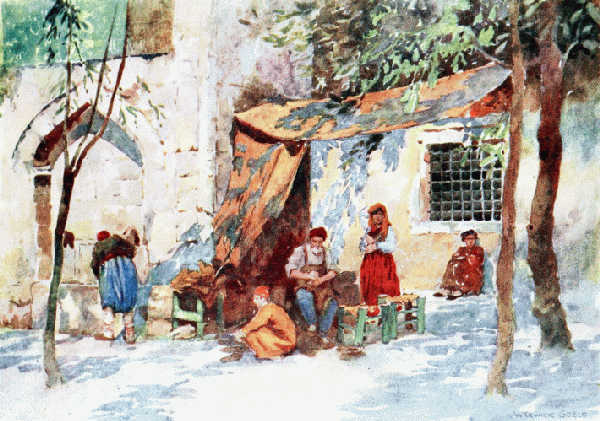
SHOEMAKER, STAMBOUL
His business plant consists of an awning propped up against the wall of a fountain and a few broken-down old stools.
On the other hand, these discussions sometimes degenerated into idle debate, and displayed some of the most odious feelings of human nature. And Constantinople laid itself open to the well-known satirical description of its theological bias by Gregory of Nyssa. “The city is full of mechanics and slaves, who are all of them profound theologians, and preach in the shops and in the streets. If you desire a man to change a piece of money for you, he informs you wherein the Son differs from the Father; if you ask the price of a loaf, you are told by way of reply that the Son is inferior to the Father; and if you inquire whether the bath is ready, the answer is that the Son was made out of nothing.”
Under Theodosius II., the interest taken by the citizens of Constantinople in theological controversy was all the greater, inasmuch as the points at issue were raised by religious teachers in the capital itself; one of the heretics being no less a personage than Nestorius, the patriarch of the city. He denied the propriety of the epithet, Theotokos, Mother of68 God, commonly bestowed upon the Mother of our Lord. A great controversy followed, in which all classes of society, from the Emperor and his family to the monks and populace, took part, and displayed, as usual in such cases, a spirit unworthy of the Christian name. So great was the commotion caused by the questions in dispute, that two General Councils of the Church—that of Ephesus in 431, and that of Chalcedon in 451—were convened to affirm the orthodox faith, if not to restore peace. And thus for some twenty years people in Constantinople had all the theology they could wish to discuss. One result of these religious troubles was to evoke the latent antagonism between the different races which composed the population of the Empire. Under the guise of religious differences, national diversities asserted themselves. Rome and Constantinople, the West and the East, did not learn to love each other better in the heat of such debates. While from the Council of Ephesus and the Council of Chalcedon, the Armenian Church and the Coptic Church date, respectively, their separation from the main body of Christendom. The extent to which religious and political aspirations are associated in the minds of the populations of the modern East69 casts much light upon the formation of different Churches along national lines in the earlier days of the Christian world, and also enables us to understand why religious conflicts caused so much anxiety to the imperial Government of New Rome.
Another feature in the religious life of Constantinople that became very distinct in the time of Theodosius II., was the veneration cherished for relics, and the growing desire to consecrate and enrich the city by their presence. The body of Chrysostom was taken from its grave in Pityus and entombed in the Church of the Holy Apostles, as an act of reparation for the wrongs he had suffered, and as an atonement for the sins of his persecutors. The supposed relics of Joseph and of Zacharias, on their arrival in the city, were received with great pomp by the Emperor, the Senate, and great officials, as though the saints were being welcomed in person. Pulcheria brought the relics of the Forty Saints martyred at Sivas, and enshrined them in a church she erected on the Xerolophus. To her also is ascribed the foundation of the three principal churches dedicated to the Mother of the Lord, S. Mary of Blachernæ, S. Mary Chalcoprateia and S. Mary Hodegetria, to become treasuries rich in relics of the Theotokos. The Empress70 Eudocia, on her return to Constantinople from a pilgrimage to Jerusalem, brought with her, besides other relics, the portrait of Christ ascribed to S. Luke. In this way, Constantinople grew to be a sacred city, a sanctuary to which pilgrims came to acquire merit and receive benefits, almost as great as those obtained by a pilgrimage to the land over whose acres walked the blessed feet of the Saviour.
To omit all reference, however brief, to the influence of ladies in the public life of Constantinople while Theodosius II. occupied the throne, would be to omit an important feature of the time; a feature which often reappeared in the subsequent life of the Empire, and profoundly affected the course of its history. Pulcheria, the sister of Theodosius II., was the power behind her brother’s throne. She directed his education, arranged his marriage, and was, with brief interruptions, the presiding genius of his career. The vow of virginity which she had taken, and which she persuaded her sisters to take, her charities, her activity in building churches, her orthodoxy, all rendered her popular in devout circles and with the dominant ecclesiastical party. To her was due the strong religious tone of the Court, and in the theological 71disputes that agitated the Church and the State in her day she took an active interest, and helped materially to determine the particular form of their settlement. Her opposition to Nestorius and Eutychius had much to do with the condemnation of their views. And notwithstanding the occasional loss of her influence over a brother who was too weak to adhere steadily to a single course, she triumphed at last over all her rivals, and upon his death mounted the throne as the consort of Marcian.
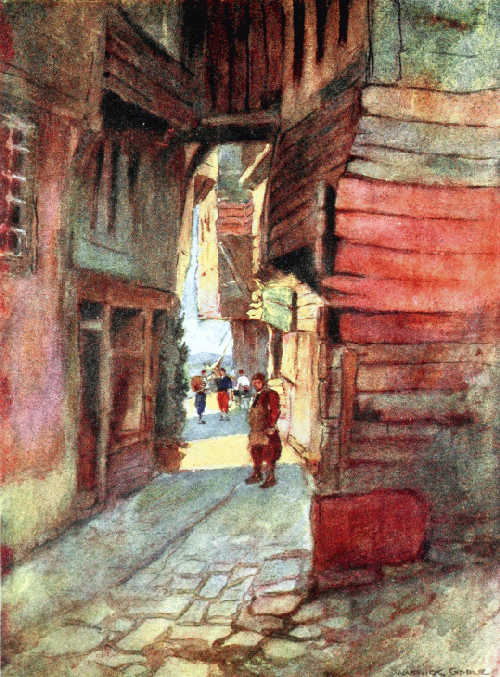
STREET SCENE, ROUMELI HISSAR
Roumeli Hissar is the most interesting of the many Turkish villages on the shores of the Bosporus.
The story of Athenaïs, and her marriage to Theodosius II., is well known, but it will always retain the attraction which belongs to a life in which romance and tragedy acted their opposite parts. A beautiful and talented girl, brought up as a pagan by her father Leontius, who cultivated philosophy in the schools of Athens, she came to Constantinople to seek redress for what she deemed a great wrong. Her father, at his death, had divided his fortune between his sons, and left her to struggle with the world almost penniless. This arrangement was a philosopher’s eccentric way of indicating his appreciation of his daughter’s loveliness and genius, and his confidence that they would win greater success for their possessor than any prosperity his72 money could ever secure. But either because of her modesty or her practical sense, Athenaïs differed from her father on that point, and wished his decision reversed. We can readily imagine how her story would circulate in the society of the capital, and make its heroine a topic of general conversation and interest. It raised so many questions to discuss, it appealed to the sympathy of so many feelings. Naturally, the charming girl was introduced to Pulcheria. She soon won the affection and admiration of the princess, under whose austerities a woman’s heart still beat, and it was not long before Pulcheria thought she could do more for Athenaïs than obtain for her a share in the fortune of Leontius. In fact she considered no one so fit to become the Emperor’s wife. The interest of Theodosius was readily excited by a description of the maiden’s charms: large eyes, the nose of Aphrodite, a fair complexion, golden hair, a slender figure, graceful manners, clever, accomplished, and “of wondrous virtues.” Accompanied by his friend Paulinus, he went to his sister’s apartments, and standing concealed behind a curtain, saw the fair form and was conquered. So Athenaïs received baptism, and under the name of Eudocia became the bride of the Emperor of the 73East. Like Portia, her father had scanted her and hedged her by his wit that she might reach the pinnacle of human joys. And with the spirit of Joseph in Egypt, she forgave the brothers who had injured her, summoned them to Constantinople, and secured for them high positions. Her talents appeared in her writings, and in her friendship with the most intelligent men of the day. But erelong clouds began to gather on this sunny sky. First came the natural rivalry between herself and Pulcheria as to whether a wife’s influence or a sister’s would be stronger over the mind of the Emperor; then estrangement, due to their different temperaments and education; then diversity of theological opinion, Eudocia taking the side opposite to Pulcheria in the controversy raised by Nestorius. But perhaps these clouds might have passed away, and the heavens grown radiant again, had not the friendship between the Empress and Paulinus aroused the jealousy of Theodosius, and excited his worst suspicions. According to a discredited tale the crisis was brought about under the following circumstances—“One day the Emperor was met by a peasant who presented him with a Phrygian apple of enormous size, so that the whole Court marvelled at it. And he gave the man a hundred74 and fifty gold pieces in reward, and sent the apple to the Empress Eudocia. But she sent it, as a present to Paulinus, the Master of the Offices, because he was a friend of the Emperor. But Paulinus, not knowing the history of the apple, took it and gave it to the Emperor as he reëntered the palace. And Theodosius having received it, recognised it and concealed it, and calling his wife asked her, “Where is the apple that I sent you?” She replied, “I have eaten it.” Then he bade her swear by his salvation the truth, whether she had eaten it or sent it to some one. And Eudocia swore that she had sent it to no man, but had herself eaten it. Then the Emperor showed her the apple, and was exceedingly angry, suspecting that she was enamoured of Paulinus, and had sent it to him as a love-gift; for he was a very handsome man.” But however idle this tale may be, the fact is that Paulinus was put to death, and the Empress was banished to Jerusalem. She spent the last sixteen years of her life there in retirement and abounding charities, and died protesting her innocence.
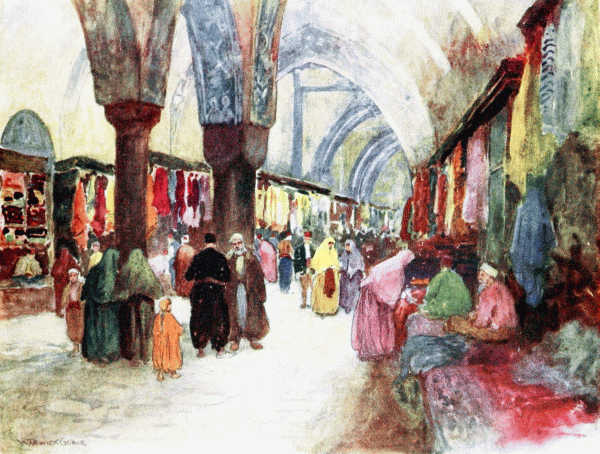
GRAND BAZAAR, STAMBOUL
One of its many vault-like passages in which the merchants are displaying their goods.
Before concluding this account of the making of Constantinople, we must note another of the characteristics which the city gradually manifested in the development of its life—the tendency to cease75 to be Roman and to become Greek. It is true, that in one sense Constantinople always remained Roman, and this character of the city should never be ignored. The people preferred to be known as Romans rather than by any other name. No title of the Eastern Emperors was so glorious in their view as to be styled the Great Emperor of the Romans. Roman law ruled in the Empire of which Constantinople was the head. The autocratic power inherited from strictly Roman days was maintained there to the last. Names of offices, epithets of officials, the denomination of taxes, legends upon the coinage of the realm, the terms in which Emperors were acclaimed by the army or the Factions were long preserved in their old Latin forms, but slightly, if at all, altered, and showed clearly the family connection that bound Rome upon the Bosporus to Rome upon the Tiber. Nevertheless, the daughter-city, though proud of her lineage, was also eager to declare her independence and to assert her individuality.
It could not be otherwise. A city exalted to be the capital of the part of the Empire under the sway of Greek traditions, and employing the Greek language as a vernacular speech, would inevitably consider itself called upon to embody and champion76 the peculiar properties of the society of which it was the constituted head. Nor could a community whose religious life was under the direction of a Church that worshipped in the Greek tongue, and was stirred by the eloquence of the Chrysostoms, the Gregories, and the Basils of the East retain a Roman complexion and character without serious modifications. So long, indeed, as the western division of the Empire existed, the political union between Rome and Constantinople proved a check upon the Greek bias of the latter city, owing to the necessity of using Latin, as the language whose writ could run equally in both parts of the Roman world. The Popes of Rome, with characteristic insight, recognised the value of a common official language as a bond of unity, and an instrument of maintaining universal rule. The use of the Latin in the services and administration of the Roman Church is a master-stroke of political genius. But when partly by the estrangement of the two portions of the Empire, and partly by the Fall of the Empire in the West, the need of a common speech ceased to exist, the stream of tendency in the East was left free to follow its natural bent.
Within the period under review we see, of 77course, only the early symptoms of the Greek bias to gain ascendency, but though these symptoms are comparatively slight, they are the proverbial straws that indicate the direction of the wind. While Latin alone glitters in the inscriptions upon the Golden Gate, Greek also is allowed a place in the legends which celebrate the elevation of the obelisk upon its pedestal in the Hippodrome. The pedestal adorned by the statue of the Empress Eudoxia likewise bore a bilingual inscription. The extraordinary energy displayed by the Prefect Constantine in the erection of the outer Theodosian Wall is lauded, on the Gate of Rhegium, in both languages. Probably the same was the case in the record of that splendid achievement put upon another gate of the fortifications—the Gate Xylokerkou—although the historian, owing doubtless to his ignorance of Latin, has preserved only the Greek version. But the balance inclines in favour of Greek, when, at the University of Constantinople, there are more professors attached to the studies in that language than to the studies in the tongue of the elder Rome. At the same time also, the Prefect Cyrus introduced the custom of publishing decrees in Greek instead of in Latin. And along with this preference for Greek in speech, there is a78 marked growth of what was Greek in spirit. Thus in the relations between the Empire and Persia, as well as in the relations between the Empire and the barbarians, the Government of Constantinople depends now for success rather upon the devices of diplomacy than upon the force of arms. The negotiations between the Court of Theodosius II. and Attila are a remarkable chapter in the history of the diplomatic art—not of the noblest character. When Marcian replied to the demand of Attila for an increase of the tribute paid to the chief of the Huns by the Government of Constantinople, in the haughty terms, “We give gold to our friends, and steel to our enemies,” words were spoken that had become somewhat unfamiliar, while the first Greek Emperor, as Theodosius II. has been styled, sat upon the throne.
Furthermore, it is the Greek spirit, not the Roman, that appears in the theological speculations of the Eastern Church, in the stress laid on correct thinking, and in the philosophical development of Christian dogma. After making every allowance for the vast difference between the splendid genius of Ancient Greece and the mental life that flourished in New Rome, it does not seem too much to say, that the old intellectual temperament of Hellas79 survived and prevailed in the capital of the East. There was undoubtedly, at all times, enough and to spare of ignorance, superstition, and narrow-mindedness in Constantinople, but no period in the history of the Byzantine world quite corresponds to the Dark Ages in Western Europe. As in the Parthenon on the Acropolis of the city with the violet crown, so, under the dome of S. Sophia, beside the blue waters of the Bosporus, men agreed that the highest attribute of the Divine, and the ideal of human attainment, is Wisdom.
CHAPTER IV
along the walls
For a person wishing to become acquainted with a great city, ready to admire beautiful scenery, and furnished with adequate information, nothing of the kind can be more interesting and memorable than to make the circuit of the old fortifications of Constantinople. It is a tour of thirteen miles, in the course of which, the city, set in the frame of its splendid natural surroundings, is seen from many different points of view, while at the same time the historical student travels through eleven long centuries, crowded with events not only of local interest but of world-wide importance.
Along the Walls beside the Sea of Marmora
The aspect which the city presents towards the Sea of Marmora and the Asiatic coast is by many persons considered to be the most beautiful view81 of Constantinople. It is certainly a very attractive view. Seated on ground rising with long and steep ascent to the ridge of the promontory, the city lies spread before you, from the Seraglio Point to the Seven Towers, over an area five miles in length. As from every other point so here also, Constantinople shows as much as possible of itself at a time. It always appears in large dimensions, lofty, spacious, far-reaching; never descending from its throne, never laying aside its majesty, but constantly maintaining an imperial mien. Along the sky-line is an array of domes and minarets that, in brilliant sunshine, gleam as though made of whitest alabaster. While at the feet of the city lies a sea of sapphire, lovely as a lake; not so broad as to place the city into dim distance, yet wide enough to give the great metropolis sufficient foreground to set off its size and dignity, to obliterate petty details, to render prominent its salient features, to soften any ruggedness, to silence its din, and make the quiet grey tones of its dwellings blend harmoniously with the overhanging heavens and with the surrounding waters. It is, if the expression is allowable, the most poetical view of the Queen of Cities. Sometimes, an early watcher on the Asiatic shore beholds a82 vision of extraordinary beauty. The silhouette of the slumbering capital is seen against a darker mass of clouds that gathered in the west during the hours of the night. Suddenly, in the hush of dawn, a delicate pink light gleams on a minaret here or a dome yonder. It tints minaret after minaret, dome after dome, house after house. It spreads downwards and athwart, transfiguring everything its rosy fingers touch, until the city, still set against a dark background, is radiant with indescribable grace. Very beautiful also is the scene towards sunset, when the slopes descending to the Marmora are in shade, and the glowing vault of heaven is a canopy of glory; when the windows in the dome of S. Sophia, as the last beams of day shine through them, sparkle like jewels in a coronet, and the sea beneath seems woven of crimson, gold, and purple. Nor can one fail to recall the soft tranquil beauty of the scene when the Sea of Marmora glitters in the moonlight, and the golden waters kiss the shadows of the broken towers and battlements that watched and guarded the city in the days of old.
There is a grave in the British cemetery at Haidar Pasha, which, contrary to the usual mode of interment, fronts westwards to be turned 83towards this side of the city. It is the grave of an Englishwoman, who, from her Asiatic home near Kadikeui, looked upon these views for many years, and felt their spell so strongly, that by her express order she was laid to rest in a position in which she might face their beauty even in death.
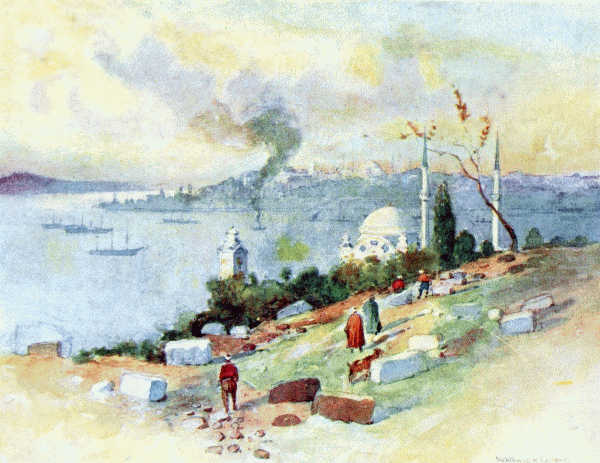
SERAGLIO POINT FROM “THE STONES”
On the Seraglio hill in the middle distance is the palace formerly occupied by the Sultans.
The fortifications beside the Sea of Marmora consisted of a wall that, for the most part, followed closely the sinuosities of the shore, and was flanked, if the account of a mediæval traveller may be trusted, by no less than 188 square towers. The works attained their full extent in three distinct stages, corresponding to the successive periods in the growth of the city. The portion from the Seraglio Point to the neighbourhood of Achour Kapoussi represented the bulwarks of old Byzantium. The portion from the latter point to the vicinity of Daoud Pasha Kapoussi, the ancient Gate of S. Æmilianus, was added by Constantine the Great, and possibly the wall bounding the vegetable gardens of Vlanga Bostan, formed part of the original defences erected by the founder of New Rome. The extension of the line from Daoud Pasha Kapoussi to the southern extremity of the landward walls was a consequence84 of the enlargement of the city in the reign of Theodosius II. For the protection of these ramparts against the waves of the Marmora in angry mood, boulders ranged in loose order were placed in the sea, at a short distance from the shore, to serve as a breakwater. Still, like Canute, the emperors of Constantinople often found that the sea scorned their control, and was the worst foe these bulwarks had cause to dread. For instance, a furious storm which occurred on the 12th February 1332 hurled the waves over the battlements, opened breaches, forced the gates, and poured devastation into every adjoining quarter. In the spring of 764 the walls near the Seraglio Point were damaged under most extraordinary circumstances. The preceding winter in the regions along the northern and the western coasts of the Black Sea had been so severe, that the sea itself was frozen hard to an immense distance from the shore. Upon the breaking up of the frost-bound waste, a long procession of ice-floes entered the Bosporus on their way to the south. They came in such numbers that for some time the channel at the Marmora end of the straits was blocked, and men crossed from Scutari to Galata and to S. Mamas (Beshiktash), and from Chalcedon 85(Kadikeui) to the city (Stamboul) with perfect safety. When at length the ice broke again and moved forward, two huge fragments were flung against the Seraglio Point by the swollen currents coursing in that direction. The strange assailants towered above the battlements, and made the city quake with fear before the weird enemy at whose cold touch strong bulwarks crumbled to pieces. How frequently these walls suffered from their exposure to storm and weather appears in the numerous inscriptions found upon them in honour of restorers of the works. The most extensive repairs were made in the reign of Theophilus (829-842), and large portions of the existing walls belong to his reign. But many other emperors were likewise concerned in maintaining these fortifications in proper order, as for example, Leo the Wise, Basil II., Manuel Comnenus, Michael Palæologus, Andronicus II., and Andronicus III. The legends commemorating repairs are usually formal, laconic records of the names and titles of the rebuilder of a tower or of the curtain of the wall. Three of the inscriptions, however, allow us to see more into the heart of the persons they celebrate, and bring us into touch with the spirit of the times. One of them, forming a line 6086 feet long, is found on the wall to the north of Deïrmen Kapoussi, and reads to the following effect:—“Possessing Thee, O Christ, as a wall that cannot be broken, Theophilus the pious sovereign and emperor, erected this wall upon new foundations; which (wall) Lord of All, guard with Thy might, and display to the end of time standing unshaken and unmoved.” The second inscription referred to speaks more directly of the injury sustained by the wall owing to the proximity of the sea:—“In the year 1024, Basil, the pious sovereign, erected from the foundations this tower, which the dashing of the sea, battering it for a long time with many and violent waves, compelled to fall.” The third inscription tells that in the year 1448, only five years before the fall of the city, George, the Despot of Servia, contributed funds towards the repair of these defences, thus showing clearly how well he understood that the fate of his kingdom was bound up with the fate of Constantinople.
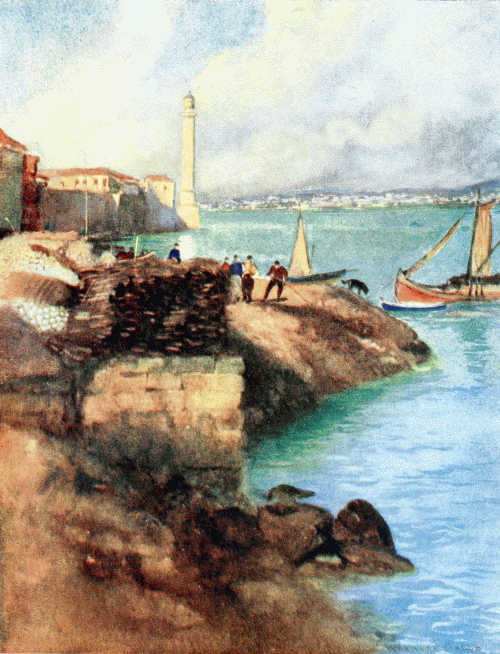
THE SERAGLIO LIGHTHOUSE AND SCUTARI
The lighthouse occupies a prominent position near the old palace of the Sultans overlooking the Sea of Marmora.
The fortifications beside the Sea of Marmora were not called to occupy a prominent place in the active defence of the city; that is to say, they were never the object of a serious hostile attack. This was only what might be expected so long87 as the Empire maintained its naval superiority to the enemies with whom it was called to contend. But the Empire was not always master of the sea. And the immunity of these fortifications from attack was then due to the difficulties which the currents that sweep along this shore place in the way of the approach of ships within striking distance. The fear that the currents would carry his ships out to sea was the reason why Dandolo refused to bring the fleet of the Fourth Crusade into action against this side of the capital. The nearest semblance of an attack upon these fortifications was when Heraclius, in 610, brought up a fleet from Carthage to depose the tyrant Phocas, and took up a position before the Harbour of Julian or Sophia, the remains of which are seen in the quarter of Kadriga Limani below the Hippodrome. But that was more in the nature of a hostile demonstration than an active assault, for the citizens welcomed Heraclius as a deliverer, and carried Phocas to him as a prisoner. Still the comparative security of these walls from attack did not warrant leaving them in a state to tempt an enemy to strike a blow, and accordingly, though sometimes neglected in time of peace, they were promptly put in order whenever a hostile fleet88 was expected. This was particularly the case during the period of the Palæologi, when Genoa and Venice and the Ottoman Turks ruled on the sea, and the naval strength of the Empire had fallen into utter decay. In the siege of 1453, the Turkish fleet blockaded this side of the city from the Seraglio Point to Vlanga.
In following the course of these walls to note the arrangements of the city, and to recall historical associations, only a very brief mention of what is most prominent and memorable is here possible. Beginning at the head of the promontory, we have first the eastern portion of the Seraglio Grounds, presenting to view the crags upon which stood the Acropolis of old Byzantium. To become the master of that hilltop, with its wonderful outlook and great strategic value was the ambition of Xenophon and “The Ten Thousand” on their famous retreat from Persia, of Philip of Macedon, of Severus Septimius, of Constantine the Great, not to mention other aspirants. After the foundation of Constantinople, until Turkish days, the site of the Acropolis formed an ordinary part of the city, the most conspicuous edifice on that position being the Church of S. Irene. There also was the hospital of Sampson, as well as that of Eubulus. 89Among the buildings on the level tract below the Acropolis were two theatres, inherited from Byzantium, one of which has left its stamp in the hollow ground now occupied by the vegetable gardens to the rear of Deïrmen Kapoussi. Scattered over the adjoining territory was a crowd of churches in which saints encamped to guard this exposed point of the city; a host led by S. Barbara, patroness of arms, S. George, the Slayer of the Dragon, S. Mary Hodegetria, with her icon ascribed to S. Luke, and regarded as a palladium. The Mangana or Arsenal, stored with military engines for the defence of the walls, also stood in this vicinity. The vaulted substructures near the ruins of Indjili Kiosk belonged to the Palace of the Mangana, to which the imperial household resorted to enjoy the cool breezes that winged their way down the Bosporus from the north. Here also was a public park, the Philopation, and an atrium built by Justinian the Great, crowded on summer afternoons, when this side of the city is in shade, by people who loved to look out upon the sparkling water, and the hills of the opposite Asiatic shore, resplendent in the mellow light of the setting sun. The fine building that formed the Thermæ of Arcadia was in this neighbourhood, and a portion90 of the polo grounds, Tzycanisterion, attached to the palace of the Byzantine emperors.
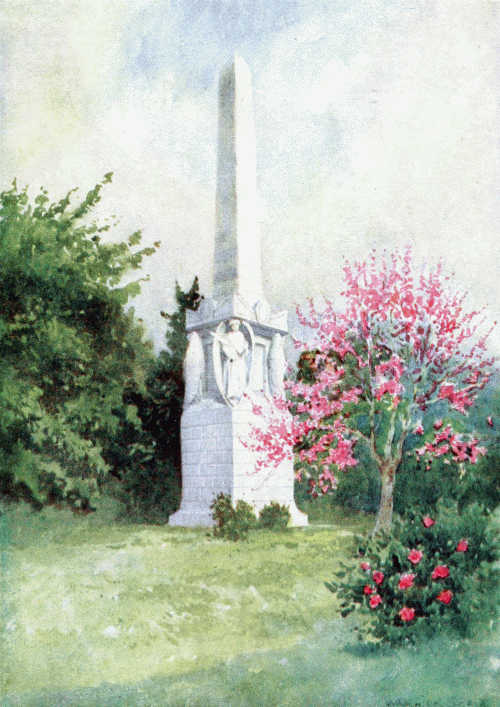
CRIMEAN MEMORIAL BRITISH CEMETERY, HAIDAR PASHA
Erected to the memory of the British soldiers and sailors who fell in the Crimean War.
Fifteen years after the Turkish occupation, Sultan Mehemet the Conqueror transferred his residence from his palace on the hill now surmounted by the War Office to this quarter of the city, and for the security of his new abode built the wall that, on its way across the promontory, from the Sea of Marmora to the Golden Horn, passes to the north of S. Sophia. In its general plan the Seraglio was a series of three courts, opening one into the other; and around and within them, embowered in groves of plane-trees and of cypresses, rose the numerous and picturesque edifices which served the convenience of the imperial household. But however inferior in the magnificence created by art, no royal abode has ever been invested by nature with the beauty and lordliness surrounding that in which the Ottoman Sultans sat enthroned from Mehemet the Conqueror to Abdul Medjid, with its grand outlook over Asia, Europe, and the great waterway between the lands on the north and on the south.
“It was at once a royal palace, a fortress, and a sanctuary; here was the brain and heart of Islam, a city within a city, inhabited by a people, and91 guarded by an army, embracing within its walls an infinite variety of edifices, places of pleasure or of horror; where the Sultans were born, ascended the throne, were deposed, imprisoned, strangled; where all conspiracies began and the cry of rebellion was first heard; where for three centuries the eyes of anxious Europe, timid Asia, and frightened Africa were fixed, as on a smoking volcano, threatening ruin on all sides.”
The slopes which descend from S. Sophia and the Hippodrome to the Sea of Marmora, immediately outside the Seraglio Enclosure, are also haunted by memories of splendour and power, for upon them stood the great palace of the Emperors of New Rome from the time of Constantine the Great to almost the end of the Byzantine Empire. The site did not command so extensive a view of the Bosporus as the Seraglio enjoyed, nor had it the outlook of the latter upon the Golden Horn and the busy life of the harbour. But its prospect over the Sea of Marmora and the hills and mountains of the Asiatic coast, rising to the snows of Mount Olympus or merged in the pale blue of the distant horizon, was wider. It had also the advantage of a sunnier and more temperate climate. The site was furthermore recommended by its92 proximity to the Hippodrome, as direct communication between the palace and that arena of the city’s public life, in serious or gay mood, was of paramount importance in Constantinople as at Rome. We must therefore imagine these slopes wooded with trees, and crowded with stately buildings, often domed, for the accommodation of a Court which sought, in pomp and luxury never surpassed, to find all that power and pleasure can do to satisfy the human heart. As in the case of Byzantine churches, so in the edifices forming the “Sacred Palace,” artistic effort was chiefly devoted to the decoration of the interior, and it was with similar means, marble revetments and mosaics, that artistic effects were produced.
The throne-room, for instance, was, as we shall find in the sequel, almost a facsimile of the Church of SS. Sergius and Bacchus. Like that church it was an octagonal hall enclosed in a square, and surmounted by a dome pierced by windows.
Each division of the octagon formed a bay under a semi-dome, and above the bays was a rich entablature, with a cornice that projected so as to constitute a gallery. The floor was paved with slabs of porphyry and variegated marbles, arranged to form beautiful designs and set in borders of93 silver, while walls and vaults gleamed with mosaics. The hall was entered from the west, and in the bay directly opposite stood the throne, with an icon of Christ in mosaic in the conch above it. The bay immediately to the south of the throne was the emperor’s robing-room, leading to a chapel in which his robes of state, his crowns and arms, and two enamelled gold shields, studded with pearls and precious stones, were kept under the guardianship of S. Theodore. The other state rooms of the palace were all varieties of the same type, displaying more or less skill and taste, according to the fluctuations of art in Constantinople. Of all the magnificence that once adorned these slopes, nothing remains but unshapely masses of brickwork, broken shafts, fallen capitals and empty sarcophagi! Slopes that vied with the Palatine as a seat of power, they are without a vestige of the grandeur that lingers around the ruined home of the Cæsars! The higher part of the site of the palace is now occupied by the Mosque of Sultan Achmed, the six minarets of which, combined with the four minarets of S. Sophia, make so striking a feature in the aspect of this part of the city. Upon the lower slopes lives a Turkish population that never dreams94 of the splendour buried beneath its humble dwellings.
Close to Tchalady Kapou, and at the water’s edge, are the ungainly ruins of the residence of Justinian the Great and Theodora, before their accession to the throne. Here began the romance of their lives. In course of time additional buildings were put up at this point, and the group thus formed became the Marine Residence attached to the Great Palace. Here was the little harbour at the service of the Court, with marble steps descending to the water from a quay paved with marble, and adorned with many marble figures of lions, bears, bulls, and ostriches. Here the Emperor embarked or disembarked when moving in his imperial barge from one part of the city to another by water. One of the pieces of statuary, representing a lion attacking a bull, bestowed upon this Marine Residence the name Bucoleon (The Bull and Lion), under which designation it is frequently mentioned in Byzantine history. There was enacted the tragedy of the assassination of the noble Nicephorus Phocas by John Zimisces, with the connivance of the Empress Theophano, the victim’s wife; a typical instance of the intrigues and crimes that often dishonoured 95the palace of the Byzantine emperors. The story has recently been told by the brilliant pen of Mr. Frederic Harrison, and therefore must not be repeated. But the visitor to the spot can recall the event with startling vividness, so well preserved is the stage on which the tragedy was acted. Directly opposite, on the Asiatic shore, is Chalcedon, where the conspirators joined Zimisces to proceed to the scene of their cruel work. The Sea of Marmora over which, on that fatal night, a snowstorm spread a veil to hide the boat which bore the conspirators across the sleeping waters, comes up to the very base of the palace. From one of the palace windows overhanging the sea, a basket, attached to a rope, was let down again and again to the boat, and again and again drawn up, with one conspirator in it at a time—Zimisces being the last—until the whole band stood within the imperial abode. And somewhere in the vaulted building we still find at the water’s edge, and whose ruins seem haunted by evil ghosts, was the chamber in which the doomed emperor lay slumbering on the floor, and was rudely awakened to know all the bitterness of ingratitude and the sharpness of a cruel death. Geography and topography are certainly the eyes of history.96
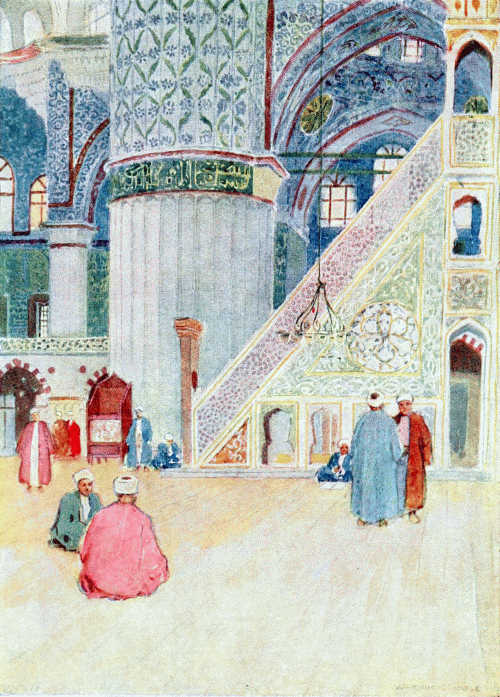
INTERIOR OF THE MOSQUE OF SULTAN AHMED I.
This mosque is beautifully decorated with blue and green tiles; on the right is the minber (pulpit) built of marble intricately carved and delicately tinted; behind it is one of the four great marble columns that support the roof.
To the west of the Bucoleon is the beautiful Church of SS. Sergius and Bacchus, erected by Justinian the Great; for some account of which the reader is referred to the chapters on the churches of the city. The district extending thence to the ancient Gate of S. Æmilianus (Daoud Pasha Kapoussi) is remarkable for having been occupied by the artificial harbours, constructed, from time to time, on the southern side of the city in the interest of commerce, or for the use of the imperial navy. They were four in number, and, notwithstanding the changes of centuries, they have left their impress upon the ground to a degree which allows their site and contour to be clearly identified. First in the order of position, though not of time, came the Harbour of the Emperor Julian, below the Hippodrome. It has already been noticed in the history of the making of Constantinople. It was used for some time even after the Turkish Conquest, but was ultimately abandoned for the deeper water found along the shores of the Golden Horn. The Harbour of the Kontoscalion followed; in the quarter which the Greek population still designates by that old name, but which is commonly known as Koum Kapoussi. It has been filled in, but the mole remains, as well as a considerable97 portion of the wall around the basin of the harbour. The entrance could be closed against an enemy by great gates of iron bars, and in bad weather three hundred galleys, of fifty or a hundred pairs of oars, might be seen taking refuge here, waiting for a favourable wind.
Next in order was the Harbour of Kaisarius, known also as the Neorion or Dockyard of the Heptascalon, which stood where the Turkish quarter of Tulbenkdji Djamissi is now situated. But few traces of it are left. Indeed its position had been forgotten, and its distinctness from the other harbours along this shore ignored, until 1819, when a great fire in the district revealed the fact that the quarter of Tulbenkdji Djamissi stood in the basin of an old harbour, enclosed by a wall built in three tiers of huge blocks. This agreed with other indications of the presence of a harbour at this point hitherto left unexplained—a mole in front of the shore of the quarter, and a gap in the mole forming an entrance to which corresponded an old opening in the city walls, now closed by masonry of Turkish construction. It harmonised also with the description which the historian Pachymeres gives of a harbour constructed or restored by the Emperor Michael Palæologus on this side of the98 city. Here Phocas placed troops to oppose the landing of Heraclius, and here also the Emperor Constantine Pogonatus, in 673, stationed his ships, armed with Greek fire, to await the fleet of the Saracens in the first siege of Constantinople by that formidable foe.
Last in order of position was the harbour on the site of the vegetable gardens of Vlanga Bostan, a work, as we have seen, belonging to the time of the founder of the city, and known first as the Harbour of Eleutherius, its original constructor, and later as the Harbour of Theodosius I., who improved it. Its mole and extensive portions of the walls around it remain, and carry thought back to the city’s earliest days.
These harbours are a monument to the great commercial activity of the city during the Middle Ages, and formed a feature in the life and aspect of the place which has disappeared. Occasionally, in the fruit-season, a considerable number of the ships and large caiques engaged in the coasting trade between the city and the ports of the Sea of Marmora anchor off the points once occupied by these harbours, and help the imagination to recall the animation, the busy crowds, the varied merchandise, the picturesque craft and 99strange crews that made what is now an almost silent shore one of the liveliest and most interesting quarters of New Rome. Owing to the sand thrown up against this coast, all these harbours demanded frequent cleaning and restoration, and had a hard struggle for existence. They were at length neglected, and, one after another, turned into dry land on which to plant market gardens, or build dwellings for the poor.
The tract of the city extending from Vlanga Bostan to the landward walls was noted for the number and importance of its churches and monasteries. Conspicuous among them was the Church and monastery of S. Mary Peribleptos in the district of Psamatia. It was destroyed by fire in 1782, and is represented by the modern Armenian Church of S. George, generally styled, after the cistern beneath the old edifice, Soulou Monastir.
The Church of S. John Studius, now a sad ruin, stood likewise in this part of the city. So did the Church and monastery of S. Diomed, upon whose steps one day, towards sunset, a way-worn youth in quest of fortune lay down to rest, after his long journey from Macedonia, and rose to become, in a capital where strange careers were possible, the Emperor Basil I. He founded a100 dynasty that occupied the throne of the Byzantine Empire for two centuries, and counted among its members such notable sovereigns as Basil II. the Slayer of the Bulgarians, Nicephorus Phocas the Conqueror of the Saracens, John Zimisces who drove the Russians out of Bulgaria across the Danube.
CHAPTER V
along the walls beside the golden horn
The fortifications which defended the side of the city along the Golden Horn consisted of a single line of wall placed, for the most part, close to the water’s edge and flanked, it is said, by one hundred and ten square towers. Like the bulwarks along the Sea of Marmora, they attained their full length gradually, according as the northern extremity of the landward walls, which they were to join, was carried farther to the west, when Byzantium expanded into the City of Constantine, when the City of Constantine grew into the City of Theodosius II., and, finally, when, in 627, the outlying level portion of the suburb of Blachernæ was brought within the bounds of the capital. The points along the shore of the Golden Horn thus reached were successively the Stamboul head of the Inner Bridge, the eastern border of the102 quarter of Aivan Serai, and the present point of junction with the landward walls on the west of that quarter. But the actual wall is, substantially, the work of the ninth century, when the Emperor Theophilus reconstructed the fortifications along both shores of the city, as the inscription, “Tower of Theophilus, Emperor in Christ,” found until recently upon almost every tower of the line, proclaimed to the world. In the course of the improvements made in the quarters along the Golden Horn, extensive portions of the fortifications have disappeared, leaving scant remains to interest the visitor. It should be added that the safety of this side of the city was further secured by a chain stretched across the entrance of the harbour, from a tower near Yali Kiosk Kapoussi, the Gate of Eugenius, to a tower known as the Tower of Galata, somewhere near Kiretch Kapoussi on the opposite shore.
The view of Constantinople from the Golden Horn, whether seen from the bridges that cross the harbour, or from Pera, is universally admitted to be as impressive and beautiful a spectacle as any city in the world can present. The visitor of a day recognises its wonderful attractions at the first glance, and long familiarity never allows103 one to feel satisfied that he has given to the scene all the admiration which it deserves. The dominant feature of the view is lordliness, although beauty is almost equally manifest. Men spoke truly when they conferred upon New Rome the title “The Queen of Cities,” for the aspect of the city is not only lovely, but carries in its aspect the unmistakable air of the majesty and authority that befit the capital of a great Empire. Here is an eye “to threaten and command.” The city spreads itself before you for some three miles on both sides of the Golden Horn, seated upon hills that rise steeply from the water’s edge, and lift the long and wide panorama high into view. The buildings are packed close together, and rise tier above tier from the shore to the summit of the hills. Great mosques, rectangular buildings surmounted by domes and flanked by graceful minarets, occupy the most commanding positions, and crown the city with a diadem of oriental splendour. The Golden Horn, one of the finest harbours in the world, where the war-ships of a nation may ride at ease, and great merchantmen can moor along the shore, is so inwoven with the city as to be its principal thoroughfare, its “Grand Canal,” alive with boats of every description,104 and spanned by bridges over which the population streams to and fro in great tides. The city is generally irradiated by an atmosphere of extraordinary clearness, brilliance, and warmth of colour. Sometimes the solid earth seems transfigured by the light into a glorious spiritual essence. Early in the morning, Constantinople is often shrouded in a thick veil of mist, and, as the sun gains strength, it is beautiful to see the veil gradually rent at different points, and the objects it covered emerge, piece by piece, one by one, now here now there, a dome, a minaret, a palace, a red-tiled roof, a group of cypresses, as though a magician was constructing the city anew in your presence, until the immense capital gleams before you in its mighty proportions and minute details. Nor is the vision less memorable towards sunset, when the lights and shadows paint this varied surface of hills and valleys, of land and water, while the long array of mosques and minarets upon the hills overhanging the Golden Horn rests against the deepening glory of the sky. It is the vision which Browning saw with a poet’s eye:—
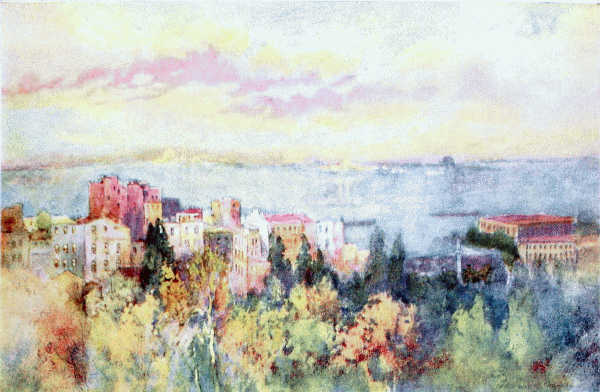
GOLDEN HORN, EARLY MORNING
Beyond the pile of buildings in the foreground a glimpse of the Golden Horn is seen with Stamboul partly shrouded in mist in the distance.
The portion of the Golden Horn to the east of the Galata Bridge is crowded with foreign steamships, among which those bearing the flags of Britain, France, Austria, Italy, Germany, Greece, and Roumania, are the most conspicuous. It may not be to the credit of the country, nor for its greatest advantage, that so much of the commerce of the place should be in foreign hands, but this gathering of the nations in the harbour of the city is imposing; it is an indication of the central position occupied by the city in the world’s affairs, and contributes largely to form the cosmopolitan character for which Constantinople is distinguished. Here the nations assemble to compete with one another as nowhere else in the world, at least in a way so manifest and decisive. This was a feature of the life of the city also before Turkish days. There was a time, indeed, during the Middle Ages when the commerce between the East and the West was exclusively in the hands of the subjects of the Byzantine Empire, when the merchants of Constantinople were the merchant princes of the civilised world. But not to speak of the interference of the Saracens with the trade of the city,106 the formidable competition of the Italian Maritime States began to make itself felt towards the close of the eleventh century, and from that time onwards became more and more serious until it well-nigh destroyed the business carried on by the native inhabitants. This was due partly to the enterprise of the Italian merchants, and partly to the policy which purchased the aid of the Western States against the foes of the Empire by means of commercial concessions which proved detrimental to domestic trade. It was thus that Alexius Comnenus secured the help of Venice against the Normans, and that Michael Palæologus obtained the support of the Genoese, when, in 1261, he undertook the task of recovering Constantinople from its Latin occupants. The attack upon Constantinople in 1203-1204 by the Fourth Crusade, at the instigation of the Doge Henrico Dandolo, was essentially a piratical expedition to capture the commerce of the East for the benefit of the merchants of Venice. In the course of time the foreign traders in Constantinople were allowed by the Byzantine emperors to occupy the territory extending along the southern shore of the Golden Horn from the Seraglio Point to Zindan Kapoussi. They were grouped according to their nationality, 107and placed beside one another in the following order, Saracens, Genoese, Pisans, traders from Amalfi, Venetians. After 1261, the Genoese were settled in Galata, where they have left a monument of their occupation in the strong and massive Tower of Galata, that formed their watch-tower and citadel, and where they established, at the very gates of the capital, so strong a rival, that, as Gibbon observes, “The Roman Empire might soon have sunk into a province of Genoa, if the Republic had not been checked by the ruin of her freedom and naval power.” These foreign communities were allowed to be self-governing, so far as the Byzantine Government was concerned. They had their own courts of justice, and their own places of worship, even the Saracens being allowed to possess a mosque. A certain number of houses, a certain extent of territory, and particular piers at which their ships could moor for discharging or receiving cargo, were assigned to them, and, as a rule, they paid lower duties than native merchants did. Sometimes, it seems they were liable to render military service, as though feudal vassals, but to all intents and purposes they enjoyed under the Byzantine emperors very much the position which108 foreigners in Turkey now occupy, in virtue of the Capitulations granted by Sultans to European residents. The original copies of several of the commercial treaties between the Empire and the Italian States are preserved in the archives of Venice, Genoa, and other cities of Italy, and furnish an interesting chapter in the history of diplomacy and commerce.
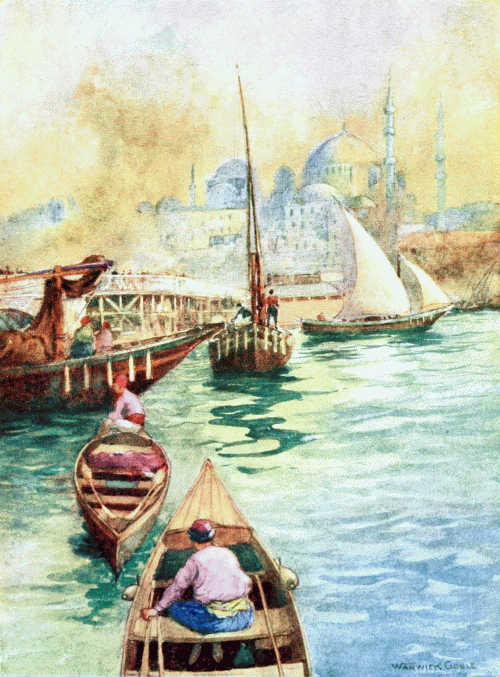
THE BRIDGE FROM GALATA
The sailing boats used in these waters are constructed so that the mast and sail can be lowered in a few seconds to shoot the arches of the bridge.
The most picturesque portion of the Golden Horn is that which lies between the two bridges. Along the Galata shore, a large flotilla of gaunt native barges, with short masts and long oblique yards, is generally moored, waiting to be employed in the transhipment of the cargoes that leave or reach the port. Here also a mass of native shipping is laid up for the winter, after the fashion of the early days of navigation. It is a dense forest of bare masts and poles involved in a network of cordage, with the steep hill, upon which the stone houses of Galata and Pera are built, as a rocky background. After a night of rain, the scene changes. Then from every yard and mast, heavy, damp sails are spread in the warm, misty, morning air, and you seem to look upon a flock of great sea-birds opening their wings to bask in the sunshine. Along the opposite shore, surmounted 109by the domes and minarets of the Mosque of Sultan Suleiman, the bank is fringed with native craft, laden with fruit or oil from the islands of the Ægean Sea, or bringing planks and beams to the timber-yards at Odoun Kapan from the lands beside the Danube. Timber has been stored at that point ever since the days of Justinian the Great, if not ever since the city was founded. Caiques flit to and fro, as if shuttles weaving the sundered parts of the city together. While companies of fearless sea-gulls spread grey wings and white breasts over the blue waters, and dance around in every graceful form that motion can assume. It is the portion of the harbour in which the world of the East is still most clearly reflected. The reach of the Golden Horn beyond the Inner Bridge is specially devoted to the service of the Turkish navy, and there may be seen such modern things as ironclads, torpedo boats, and torpedo destroyers. The time was when the Ottoman fleet which gathered here formed an imposing display of naval strength. The Admiralty, Naval Hospital, and Dockyard are situated on the northern bank. On the hill above the Dockyard is the Okmeidan, the field to which the Sultans whose strong arms built up the Ottoman Power came to exercise110 themselves in the use of the bow. It is studded with pillars commemorating the long shots made by the imperial archers.
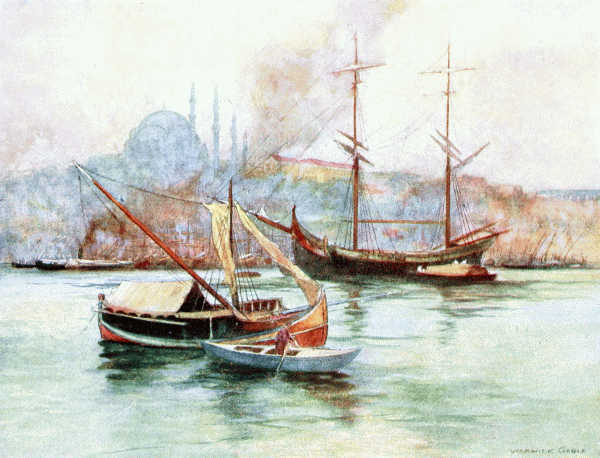
GOLDEN HORN
Seen from the water’s edge on a misty morning; crowning the distant heights is the Mosque of Suleiman the Magnificent.
The southern bank, with its steep slopes crowded with konaks, gardens, mosques, minarets, is noteworthy for the number of Byzantine churches still found beside the shore or upon the hill-sides, preserving the memory and something of the aspect of the ancient city. Among them are, S. Theodosia (Gul Djamissi), Pantocrator (Kilissé Djamissi), Pantepoptes (Eski Imaret Djamissi), Pammakeristos (Fetiyeh Djamissi), Chora (Kahriyeh Djamissi), SS. Peter and Mark (Atik Mustapha Pasha Djamissi). Close to the western extremity of the shore stood the Church of S. Mary of Blachernæ, once the object of profoundest reverence on account of the wonder-working power attributed to the reputed girdle and mantle of the Mother of the Lord, enshrined among its relics. The site is marked by the Holy Well formerly attached to the sanctuary. On the hill above the Well are the scanty remains of the famous Palace of Blachernæ, once the favourite residence of the Byzantine Court. In the quarter of Phanar the humble residence and the cathedral of the Patriarch of Constantinople are found. What a contrast to 111the days when the chiefs of the Eastern Church were enthroned under the dome of S. Sophia! In the quarter of Balat, and at Haskeui on the opposite shore, are large settlements of Jews, to whose lowly dwellings belongs the historical interest that they are the homes of the descendants of the Jews who were expelled from Spain by Ferdinand and Isabella, and found refuge here among Moslems from persecution by Christians. They still use the Spanish language, although not with the music of the speech of Castile. The suburb of Eyoub at the foot of the hills at the head of the Golden Horn, and the meadows beside the fresh-water streams which enter the harbour at that point (the Sweet Waters of Europe) are interesting to all who delight in Oriental scenes. No quarter in or around the city is so Turkish in its appearance and spirit as the suburb of Eyoub. It contains the reputed grave of Eyoub, the standard-bearer of Mahomet, who was present at the first siege of Constantinople (673-678) by the Saracens, and who died during its course. The grave was identified, so it is believed, in 1453, when the city fell at last into Turkish hands, and the mosque erected over the tomb is the sanctuary in which Sultans, upon their acces112sion to the throne, gird on the sword which constitutes them sovereigns of the Ottoman Empire, and standard-hearers of Islam. It is a ceremony which embodies the inmost idea of a Moslem State. No Christian is permitted to enter the mosque. On a recent occasion the veneration in which the edifice is held served a noble purpose. During the massacres of 1896, a crowd of Armenians took refuge in the court of the mosque, with the courage of despair. A wild mob followed, intent upon the death of the fugitives. A terrible scene seemed inevitable. When, at the critical moment, the imaum of the mosque appeared, and forbade the desecration of the holy ground by the shedding of blood upon it. The appeal was irresistible. The horde of murderers bowed to the command to be gone, and their intended victims were allowed to escape. The sacred associations of the suburb have made burial in its soil to be esteemed a great honour, and, accordingly, many distinguished Turkish personages have been laid to rest here from early times. The old turbaned tombstones, inscribed with Arabic letters, painted with floral designs, shaded by trees and overrun by climbing plants, form as picturesque a cemetery as one can wish to see. The influence of the suburb is not 113weakened by the fact that it enters into the life of Turkish children by being a great factory of their toys. The hill above Eyoub commands a magnificent view of the Golden Horn and the city. As to the scene in the valley of the Sweet Waters, where Turkish ladies gather on Fridays in early spring, it is no longer what it once was. The exchange of native vehicles for carriages such as may be seen in Paris or London, and the general use by Turkish ladies of quiet colours in their mantles and head-dress instead of bright hues, have robbed the spectacle of almost all its gaiety, originality, and decorative effect. The scene offers now rather a study in the transformation of the Turkish woman, than a presentation of her peculiar aspect and character. Still, as the change is not complete, a stranger may yet find pleasure in seeing what vestiges of former manners and customs have not disappeared.
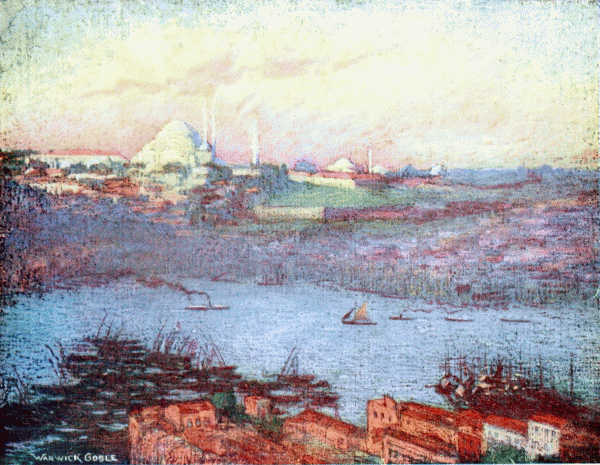
SULEIMANIYEH AT SUNRISE
The Mosque of Suleiman the Magnificent, occupying one of the finest sites in the city, is seen here at early sunrise emerging from the mist on the Golden Horn.
Of the historical events of which the Golden Horn has been the theatre, the most important are: first, the attack upon the walls along this side of the city, in 1203, and again in 1204, by the Venetian fleet which accompanied the Fourth Crusade; second, the transportation by Sultan Mehemet into its waters in 1453, of warships over the hill that separates the harbour from114 the Bosporus. The movements of the Venetian fleet and of the army which accompanied it can be followed step by step, so minute is the description of Ville-Hardouin and so unaltered the topography of the country. Upon approaching the city the invaders put in at San Stefano, now a favourite suburban resort upon the Sea of Marmora. A south wind carried them next to Scutari. From that point they crossed to the bay now occupied by the Palace of Dolma Bagtché, near Beshiktash. There the army landed, and advancing along the shore attacked the tower to which the northern end of the chain across the harbour’s mouth was fastened. Upon the capture of the tower after a feeble resistance, the chain was cut, and the fleet of Venice under the command of Dandolo, flying the ensign of S. Mark, rode into the Golden Horn and made for the head of the harbour. At the same time, the troops marched towards the same point, along the northern shore, where Cassim Pasha and Haskeui are now situated. At the latter suburb they crossed the stone bridge that led to Eyoub on the southern bank. Then turning eastwards, they seized the hill facing the portion of the city walls above which the windows and domes of the Palace of Blachernæ looked 115towards the west. While the army prepared to attack that point, the ships of Dandolo stood before the harbour walls, in a long line from Aivan Serai to the Phanar and the neighbourhood of the present Inner Bridge. A desperate assault followed, in which twenty-five towers were carried by the Venetians, and the day would have been won, but for the repulse of the land forces and the necessity to hasten to their relief. Soon a revolution within the city against the usurper whom the Crusaders had come to depose, and in favour of the restoration of Isaac Angelus, whose claim to the throne they supported, seemed to bring the struggle to an end. As a sign that amicable relations had been established, and to avoid the danger of angry collisions with the citizens, the invaders removed their forces to the northern side of the Golden Horn. But the conditions on which help had been rendered to Isaac Angelus were too hard to be fulfilled; and insistence upon them provoked the national feeling against the foreign intruders. The imperial protegés of the Crusaders were murdered, or died from fear, and the smouldering embers of the strife burst once more into flames. The army of the Crusade was therefore taken on board the fleet, and proceeded to make a116 joint attack upon the portion of the harbour walls which Dandolo had once before captured. Victory wavered from side to side. At length, on Easter Monday 1204, Venetian ships approached so near to the walls in the Phanar quarter that bridges attached to the masts settled upon the parapet of the fortifications. Brave knights rushed across, cut down the defenders, clambered down into the city, and threw open the nearest gates. The blind Doge, ninety years old, leaped upon the beach, with the banner of S. Mark in his hands, and summoned his men to follow. The Emperor Murtzuphlus, who watched these operations from the terrace of the Church of Pantepoptes, fled, and for the first time in its history, Constantinople became the prize of a foreign foe.
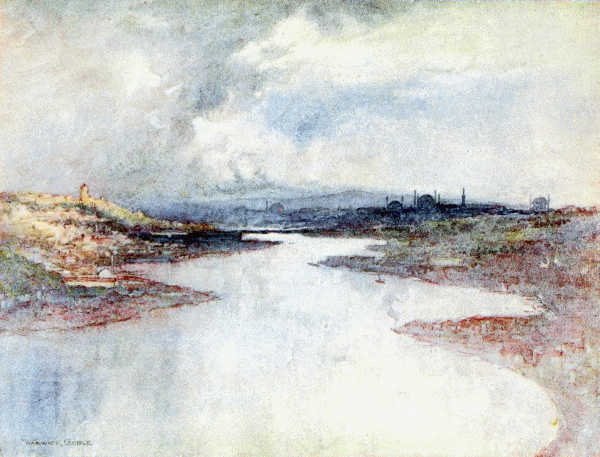
GALATA AND STAMBOUL FROM EYOUB
From the cemetery at Eyoub, overhanging the Golden Horn at the upper end, an attractive panorama is presented. On the right are the domes and minarets of Stamboul stretching away to Seraglio Point; in the distance is Mount Olympus on the Asiatic coast, while on the right are Galata, Pera, and the Arsenal.
The transportation of a fleet over the hill that rises some two hundred and fifty feet between the Bosporus and the Golden Horn was a skilful piece of strategy, and formed one of the most striking incidents in the siege of 1453. By compelling attention to the safety of the walls along the harbour, it extended the line of attack, and weakened the defence of the landward walls. To effect the passage, a road was made through the ravines leading from Beshiktash on the straits to Cassim 117Pasha on the Golden Horn. On that road well-greased logs were laid, like the sleepers on a railway, and then some seventy or eighty galleys, of fifteen, twenty, or twenty-two pairs of oars, were placed in ships’ cradles and dragged by men, oxen, and buffaloes, in the course of a single night, up one slope and down the other, from sea to sea. The incongruous form of navigation put everybody concerned in making the voyage into good humour. Drums beat, fifes sounded, and to add to the zest of the enterprise, the sails were unfurled, the oars were pulled, the rudders set, as if the vessels were proceeding over their native element. But the apparition of the enemy’s ships in the Golden Horn afforded no amusement to the besieged. It increased immensely their anxiety and the difficulties of their task. A brave attempt to burn the Turkish vessels failed, and though the flotilla actually did little in the way of direct attack, it remained a standing menace to the northern side of the city until the close of the siege, a thunder-cloud keeping men in constant dread of the bolts that might dart from its black bosom. Very appropriately, the Turkish Admiralty stands on the shore of the bay in which an Ottoman fleet first rode the waters of the Golden Horn.
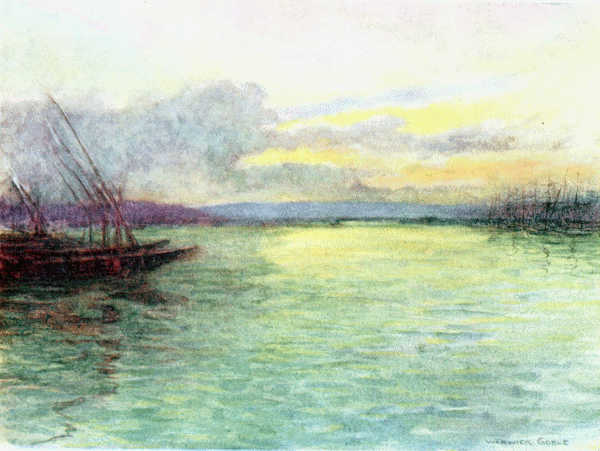
GOLDEN HORN AFTER SUNSET
When all traffic ceases, caïques, lighters, steamboats, and craft of all kinds are taken to their moorings and the waters are silent and deserted.
CHAPTER VI
along the landward walls
In the third chapter, occupied with the story of the making of Constantinople, some account has been given of the portion of the landward walls erected in the earlier half of the fifth century, when the city was enlarged under Theodosius II., viz, the portion extending from the Sea of Marmora, on the south, to the ruins of the Palace of the Porphyrogenitus (Tekfour Serai) on the north. That seemed the most appropriate place to speak of the origin and character of fortifications which were built as much for the growth and convenience of the city in its civic relations, as for its security as the citadel of the Empire. To that chapter the reader who desires to recall the information given on the subject, is referred. Here, after a brief account of the additions made to the Theodosian walls, in subsequent times, we119 shall consider the historical importance of the landward walls as a whole, and glance at some of the scenes enacted before them.
The post-Theodosian portions of the walls that guarded Constantinople on the side of the land extend from the courtyard of the Palace of the Porphyrogenitus to the shore of the Golden Horn at Aivan Serai. They replaced an older line of fortifications which ran, at a short distance to the rear, between the same points, and were constructed to strengthen the weak places which time revealed in this part of the city’s armour. First in the order of position, though not in the order of time, comes the wall erected by Manuel Comnenus (1142-1180), for the greater security of the Palace of Blachernæ, his favourite residence, which stood within the old bulwarks, just mentioned. It terminates at the foot of the steep hill on which the quarter of Egri Kapou is situated. With its nine noble towers it presents a striking likeness to the fortifications of a feudal baronial castle, and its solid masonry defied the Turkish cannon in 1453. Then follow walls, the original date of whose construction cannot be precisely determined, as they evidently underwent frequent repairs and alterations. Here is found120 the Tower of Isaac Angelus, and, in the body of the wall to the north of the tower, are three stories of large chambers, very much ruined, which some authorities regard as the cells of the State Prison of Anemas. More probably, they were either barracks or store-rooms attached to the imperial residence, and at the same time buttresses for the support of the terraced hill on which the palace was built. Beyond this chambered wall there is a double line of fortifications. The inner wall was erected in 627, under Heraclius, after the siege of the city by the Avars, to protect the quarter of Blachernæ and its celebrated Church of S. Mary of Blachernæ more effectively in the future than when assailed by that enemy.
The outer wall was built as an additional defence in 813, by Leo the Armenian (813-820), in view of an expected attack upon the city by the Bulgarians under Crum.
The territory outside the landward walls has indeed a charm of its own, in its quiet rural aspect, and in the glimpses it affords of distant blue water seen through dark groves of cypresses. But it cannot pretend to the splendid natural scenery which confronts the shores of the Sea of Marmora or of the Golden Horn, and makes the 121beauty of Constantinople famous throughout the world. This, however, is not altogether a disadvantage, for it allows the visitor to view without distraction the imposing line of bulwarks ranged across the promontory from sea to sea, and to appreciate calmly all their significance. On the other sides of the city, the fortifications which guarded the Queen of Cities are comparatively unimportant, and are easily lost sight of in the beauty of their surroundings. Here the walls and towers are everything. Here they attained their greatest strength; here they rendered their greatest service; here, like troops bearing the wounds and scars of a great campaign, they force the beholder to realise the immense debt which the civilised world owes to Constantinople for the strength, the valour, and the sacrifices devoted through long centuries to the defence of the highest life of mankind against terrible foes.
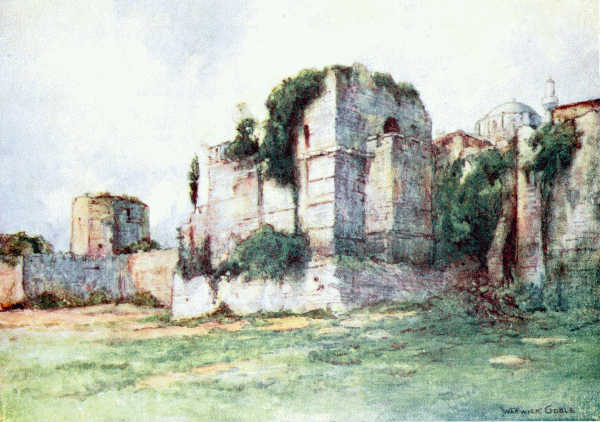
THE WALLS; THE TOWER OF ISAAC ANGELUS
Part of the old fortifications, now in ruins, stretching from the Marmora to the Golden Horn.
Nor does the scenery which the walls themselves present need to borrow attractions from any other source to render it the most picturesque and impressive spectacle of the kind in the world. The alternate courses of grey stone and red bricks in the structure of the fortifications; the long lines of wall ranged in ranks, and rising tier above tier to122 support one another in the terrible struggles they were called to maintain; the multitude of towers, marshalled to guard the city and Empire, great and small, of every shape, square, round, polygons looking in six, seven, or eight directions, some intact after all the storms of centuries, others bare, broken, fissured from head to foot, yet holding together; inscriptions recalling wars, earthquakes, names of men who have made history; towers crowned with ivy; trees interspersed between the walls or standing upon the summit, like banners; crenellated parapets affording glimpses of the blue sky behind, as though, in Oriental phrase, the ramparts rose to the very heavens; all this stretching for mile upon mile, from sea to sea, presents a scene of extraordinary beauty and grandeur, not less attractive because of the heroism and achievements of which it has been the theatre.
This is not the place for an extended history of the services which these walls, and the Empire of which they were the citadel, rendered as the shield of European civilisation. Enough to remember that the dread of them dissuaded Attila and his Huns from delivering an attack upon the city, although he approached as near to Constantinople as Athyras, now Buyuk Tchekmedjé, some twelve123 miles distant. Doubtless they often restrained the wrath also of other barbarous hordes. In vain did the Avars, in 627, beat against these walls between Top Kapou (Gate of S. Romanus) and the Gate of Adrianople (Charisius). In vain did the Arabs invest these bulwarks from the spring to the autumn of four successive years (673-677). As unsuccessful was the second siege of the city by the same foe for twelve months (717-718). These fortifications defied the Bulgarians both under Crum in 813 and under Symeon in 924. In 1203 they repelled the valour of the knights and barons engaged in the Fourth Crusade. They mocked the assaults of Sultan Murad, in 1422. And when they succumbed, at length, to the artillery of Sultan Mehemet in 1453, it was because their defenders were few and divided, and their assailants were armed with weapons before which ramparts of stone, alike in the West and in the East, crumbled to pieces, and old systems of society were swept away.
The battles fought directly before the walls of New Rome do not, indeed, give us the complete story of her warfare “per benefitio de la Christiantade et per honor del mundo.” On eight occasions, at least, the armies of the East Roman124 Empire were drawn up on the plain outside the Golden Gate to celebrate victories won on distant battlefields, and to enter the triumphal Gate of the capital with prisoners, standards, and spoils captured on hostile territory. To the shouts “Glory to God, who has restored to us our sovereign crowned with victory! Glory to God who has magnified you Emperor of the Romans! Glory to Thee All-Holy Trinity, for we behold our Emperor victorious! Welcome Victor! most valiant sovereign!” the triumphal car of Heraclius drove into the city, after his splendid campaign of seven years against the Persians; the campaign which brought the long struggle between Europe and Persia since 492 B.C. to an end. The same shouts rent the air, when Constantine Copronymus returned from the defeat of the Bulgarians, and twice again, when Basil II., by two murderous wars with that people, earned the title, the Slayer of Bulgarians, Bulgaroktonos. Theophilus, on two occasions, and Basil I. passed through the Golden Gate as victors over the Saracens. And Zimisces received the same honour for beating back the Russians under Swiatoslaf. These were great days in the history of the city, nay, of mankind, for they125 stayed the waves of barbarism that threatened to overwhelm the civilised world. But after all, it is when the enemy stands arrayed before the very capital of the Empire, and delivers assault after assault upon the citadel which guarded its fate and the destiny of Europe, that the struggle waged between civilisation and barbarism during the history of New Rome is fully recognised to have been, indeed, a struggle for life, and that we learn to appreciate what we owe to the Warden of the Gates to the Western World. To these walls may be applied the words in which Mr. Gladstone appraised the value of the services rendered by the Christian populations of the Balkan Peninsula, in a similar connection. “They are like a shelving beach that restrained the ocean. That beach, it is true, is beaten by the waves; it is laid desolate; it produces nothing; it becomes perhaps nothing save a mass of shingle, of rock, of almost useless sea-weed. But it is a fence behind which the cultivated earth can spread and escape the incoming tide.... It was that resistance which left Europe to claim the enjoyment of her own religion, and to develop her institutions and her laws.”
Although inferior as military works to the other portions of the landward walls, great historical126 interest is associated with the fortifications between the Wall of Manuel and the Golden Horn, for they guarded the Palace of Blachernæ, the favourite residence of the Byzantine Court from the time of Alexius Comnenus (1081-1118) until the fall of the Empire. As already intimated, the palace stood on the terrace buttressed by the Tower of Isaac Angelus and the chambered wall to the north of the tower, where the Mosque of Aivas Effendi is now found. The terrace was almost level with the parapet-walk of the fortifications, commanding fine views of the Golden Horn, and of the hills at the head of the harbour; and there the most splendid Court of the Middle Ages long displayed its wealth and pomp. What with the Crusades, and what with the relations, hostile and friendly, between the Italian Republics and the Government of Constantinople during the period of the Palæologi, it was in that palace that Western and Eastern Europe came into closest contact for good or for evil. On the hills and in the valleys seen from the western windows of the palace, the armies of the First Crusade encamped. To that residence came Peter the Hermit, Godfrey of Bouillon, Robert of Normandy, Bohemond, Tancred, “the mirror of knighthood,” Count Robert of Paris, to127 wonder at the marvels of Byzantine Art, and to attempt the co-operation of the East and the West, in the great political and religious undertaking of the times. On the hill immediately in front of the walls the soldiers of the Fourth Crusade pitched their tents, and thence Baldwin of Flanders and Hainaut, Henry his brother, Louis of Blois and Chartres, and Hugo of Saint Paul, led four divisions of the army against the wall erected by Leo the Armenian. The wall was held by Varangian troops, the imperial body-guard, recruited from England, Denmark, Norway, and Russia. “The assailants,” to quote the words of Ville-Hardouin, a witness of the combat, and the historian of the Crusade, “placed two scaling-ladders against an outer wall near the sea; the wall was furnished with Englishmen and Danes, and the attack was strong, and good, and hard. And by sheer force some knights and two sergeants mounted the ladders, and became masters of the wall. Fully fifteen reached the wall, and they fought hand to hand with axes and swords. And the men within returned to the charge and drove them (the assailants) out, right rudely, even taking two of them prisoners. And those of our men who were captured were led to the Emperor Alexis, and he was very highly128 delighted. So ended the attack by the French. And there was a considerable number of men wounded and of maimed; and the barons were very angry about it.”
The recovery of Constantinople from the Latins in 1261 did not diminish Italian influence over the life of the city. On the contrary, from that time to the close of Byzantine history that influence, modified indeed by the rival force of Ottoman power, grew stronger and stronger. Commercial interests, political necessities, schemes of ecclesiastical union, literary sympathies, possibilities of aggrandisement at the expense of an Empire hastening to ruin, made Italy, especially Genoa and Venice, take a most active part in the affairs of New Rome. A Western atmosphere, so to speak, then enveloped Constantinople, very much like that which surrounds the City of the Sultans to-day.
But the portion of the walls about which the greatest and most pathetic interest gathers is where Sultan Mehemet delivered his fatal blow upon the Byzantine Empire, and won the title of “the Conqueror.” It is the portion which stretches from Top Kapoussi (Gate of S. Romanus) to Edirné Kapoussi (Gate of129 Charisius), across the ravine through which the little stream of the Lycus, on its way to the Sea of Marmora, enters the city. Owing to the depression of the ground and the impossibility of constructing a deep moat there, this was the weakest point in the Theodosian fortifications, and here the bravest of the defenders, under Giustiniani of Genoa and the Emperor Constantine, manned the walls to oppose the best troops under the command of the Sultan. Against this part of the walls the enemy pointed his heaviest cannon, and here the contest raged for more than seven weeks. Both the besieged and the besiegers fought with the determination and the valour worthy of the issues at stake. When the Turkish artillery broke down the Outer Wall, Giustiniani and his Genoese and Greek comrades held their ground, and replaced the fallen ramparts by a stockade built of stones, barrels full of earth, beams, branches of trees—of anything within reach that would hold together. Against that barricade wave after wave of Turkish troops dashed and beat furiously and long. There were moments when the defenders seemed to have gained the day. But like gleams of sunshine that pierce storm clouds, they only served to make the impending130 catastrophe more tragic. Giustiniani was wounded and left the field. A band of bold Turks entered the city through the postern of the Kerkoporta, thoughtlessly left open, and, mounting the walls, planted their banners upon the parapet. Anon, the cry “The city is taken” burst upon the air and reverberated from tower to tower. A panic seized the besieged. The Sultan, grasping his opportunity, roused his janissaries to a supreme effort, and hurled them against the battered and half-deserted barricade. The Emperor Constantine did everything in his power to rally his followers and repel the terrible onset. It was hopeless. He then sought and found a soldier’s death, rather than survive the fall of his Empire. “All was lost save honour.” And over his dead body the tide of conquest poured into the city.
Thus ended the history of more than a thousand years. Then Asia dealt its worst blow upon Europe. Then the last vestige of the State, ruled first by Rome from the seven hills beside the Tiber, and afterwards by New Rome enthroned on the seven hills beside the Bosporus, disappeared. Then the Crescent gained its greatest triumph over the Cross. Not many spots in the world have been the scene of such momentous events as took place 131in the little valley of the Lycus on the 29th of May, 1453. There an Empire died, and a long and great epoch closed.
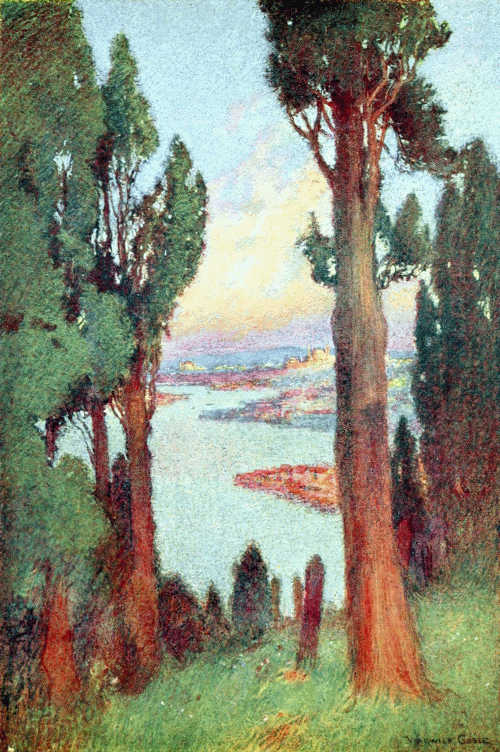
CONSTANTINOPLE AND GOLDEN HORN FROM THE CEMETERY AT EYOUB
Many a charming vista may be seen through the cypress trees in the cemetery at Eyoub.
It is very natural, when thoughtful men tread the road which skirts these ancient fortifications, that the mind should be profoundly impressed by the vanity of earthly might and greatness. On the one hand, the way is strewn with the wreck and ruin of ramparts once deemed impregnable:
O’er each mouldering tower, Dim with the mist of years, grey flits the shade of power.
On the other hand, stretch great silent cemeteries, beneath whose dark cypresses lies the dust of a dead multitude more than can be numbered. As one has expressed the feeling awakened by this spectacle of wreckage and mortality, “It is walking through the valley of the Shadow of Death.” And yet, seeing there must be an end to all things, is it not wiser and more just to dwell rather upon the glory that crowns these bulwarks for their long defence of the civilised life of the world?
For a full account of the Turkish Conquest, see E. Pears’ The Destruction of the Greek Empire.
CHAPTER VII
among the churches of the city
Constantinople was a city of churches. Clavijo, the Spanish envoy, who visited the city in 1403, was assured that it was hallowed by the presence of no less than 3000 sanctuaries, counting large and small. This was obviously an exaggeration, intended to impress the stranger’s mind with a due sense of the city’s grandeur and sacredness. Ducange in his great work, Constantinopolis Christiana, gives the names of some 400 churches mentioned by the Byzantine authors whose works he had examined. But a wider acquaintance with Byzantine literature since the time of that great student of the antiquities of Constantinople has discovered the names of many churches not upon his list. It is therefore impossible to reach exact figures here, and we must be content with the vague statement that the number was so large as133 to form a striking feature of the city’s aspect. This was only what might be expected in a city where the number of churches would be determined not only by the ordinary religious needs of a devout population, but also by the demands of the many monasteries which sought security from violence behind the bulwarks of the capital, notwithstanding the temptations of the world, the flesh, and the devil, encountered there. What does cause surprise, however, is that so few of the numerous churches which once adorned the city, and embodied the piety of its people, have left one stone standing upon another to recall their existence. At most, thirty-five remain, and of these several of them are so dilapidated that they only serve for the identification of an interesting site, or to emphasise the vanity of earthly things.
Of course all the churches of the city were never contemporaneous. In a city which had a life of more then eleven centuries, the list of almost any class of edifices erected in the course of that period would necessarily be a long one, without implying the existence of numerous edifices of that class at one and the same time. According to the description of Constantinople which dates from the first quarter of the fifth century, the number of churches134 then in the city is given as only fourteen. Churches appeared and disappeared, and while some of them were, for special reasons, maintained throughout the whole course of the city’s history, many came to flourish for a while and then decayed in the ordinary course of things, bequeathing as their memorial only the withered leaves of their names. Then we must remember the frequent and disastrous earthquakes which shook the soil of Constantinople during the Middle Ages, and the terrible conflagrations which again and again reduced the wealth and glory and beauty of extensive tracts of the city to dust and ashes. For example: the three fires associated with the capture of the city by the Latins in 1203-1204 inflicted a blow from which the city never recovered. One of those fires raged for a night and a day; another for two days and two nights, with the result that almost all the territory along the Golden Horn, as well as the territory extending thence to the Hippodrome and the Sea of Marmora, as far away as Vlanga, were turned into a wilderness of smoking ruins. “The fire,” says Ville-Hardouin, a spectator of the awful scene, “was so great and so terrible that no man could extinguish or check it. It was a sad and pitiful spectacle for the barons of the 135army encamped on the other side of the harbour to see those beautiful churches and those rich palaces fall in and be destroyed, and great business streets burned by the scorching flames; but they could do nothing. The fire spread beyond the harbour across to the densest part of the city, quite close to S. Sophia, and as far as the sea on the other side. It lasted two days and two nights, without being ever touched by the hand of man, and the front of the fire was fully half a league long. Of the damage done, or of the property and wealth thus lost and consumed no estimate can be made, nor of the number of men, women, or children who perished.” It is true that churches injured by the hand of time were often restored. There were even periods when such renovation was carried out on an extensive scale, as for instance under Justinian the Great and under Basil I. (867-886). But not less frequently the old fabric was so weakened by age or shaken by earthquake that to repair it was out of the question, and the only thing to be done was to use its stones and bricks and marbles as materials in the construction of other buildings. Much of the material, for instance, employed in the erection of the Tower of Isaac Angelus, in front of the Palace of Blachernæ,136 was taken from the ruins of old churches. While for the construction of the citadel which John VI. Palæologus (1341-1391) built near the Golden Gate, material was taken from the remains of churches so noted in their day as the Church of All Saints, the Church of the Forty Martyrs, and the Church of S. Mokius.
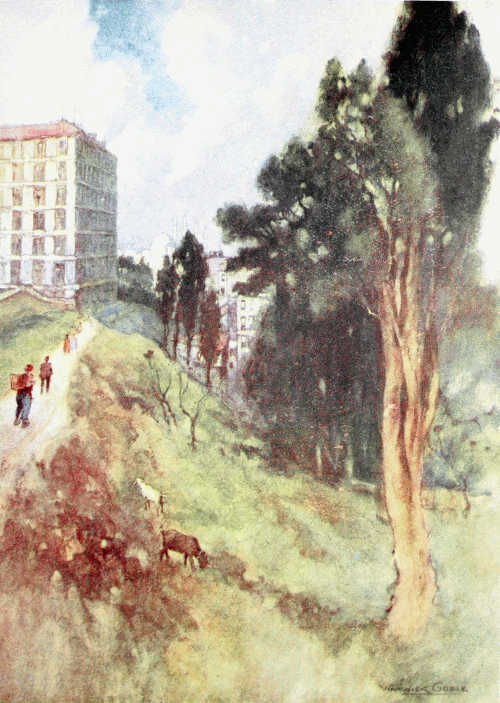
VIEW FROM AN OLD CEMETERY
Close to the busy thoroughfare of Pera large tracts of land lie unoccupied save for a few mouldering old tombstones; they are the remains of old Turkish burying-grounds.
Upon the recovery of Constantinople from the Latins in 1261, something indeed was done to repair the damage due to the occupation of the city, for some fifty-seven years, by barbarous and covetous strangers. But the last two centuries of the Empire were years of wars and civil broils, years of decline and poverty, and at length of despair, so that comparatively little could be undertaken to rebuild the sad ruins inherited from the past, or to arrest the decay whose withering touch was laid on the monuments that still survived more or less intact. Even the Imperial Palace beside the Hippodrome was allowed to fall into such neglect and desolation, that when the Turkish conqueror visited its empty halls they echoed to his ear the couplet of the Persian poet: “The spider has become the watchman of the royal abode, and has spread his curtain over its doorway.” The decay which had smitten the city impressed every visitor137 during the half-century preceding the Turkish Conquest. “Although the city is large,” says the Spanish envoy already cited, “and has a wide circuit, it is not thickly populated everywhere for it contains many hills and valleys occupied by cultivated fields and gardens, and where one sees houses such as are found in an outlying suburb and all this in the heart of the city.... There are still many very large buildings in the city, houses, churches, monasteries, but most of them are in ruins.” The great disproportion between the size of the city and the number of the population made a similar impression on Bondelmontius who came here from Florence in 1422. He speaks of vineyards flourishing within the city bounds, and adds, “There are innumerable churches and cisterns throughout the city, remarkably large and constructed with much labour, and found in ruin.” La Broquière, to cite one witness more, who was here in 1433, observes that the open spaces in the city were more extensive than the territory occupied by buildings. Times had indeed changed since the days of Themistius and Anthemius.
Constantinople was therefore far from being a rich and splendid city when it fell into the hands of its Turkish conquerors in 1453, and the scarcity138 of the monuments of its former wealth and grandeur must not be ascribed wholly to the action of its new masters. The ravages of time, and the vandalism of the Latin Crusaders, had left little for other rude hands to destroy.
In his dealing with the religious rights of the Christian community the Ottoman lord of Constantinople proved conciliatory. While appropriating S. Sophia and several other churches for Moslem use, he allowed the Greeks to retain a sufficient number of their former places of worship.
He, moreover, ordered the free election of a new patriarch, who should enjoy, as far as possible under altered circumstances, the privileges which the chief prelate of the Great Orthodox Church had formerly possessed. Upon the election of Gennadius to the vacant post, the Sultan received him graciously at the palace, and presented him with a valuable pastoral cross, saying “Be patriarch and be at peace. Depend upon my friendship so long as thou desirest it, and thou shalt enjoy all the privileges of thy predecessors.” The Church of the Holy Apostles, only second in repute to S. Sophia, was assigned to the patriarch as a cathedral, and he was not only allowed free access to the 139Seraglio, but was even visited by the Sultan at the patriarchate. The loss of S. Sophia was, indeed, a terrible humiliation, one from which the Greek Church has never recovered; a humiliation which all Christendom feels to this hour. But the preservation of the fabric is doubtless due to the fact that it passed into the hands of the conquerors. It is difficult to see how the Greek community could have maintained that glorious pile, even “shorn of its beams,” after 1453. At the time of the fatal siege, the population of the city counted at most one hundred thousand souls. When the city fell, upwards of fifty thousand of its inhabitants were sold into captivity. Nor did the subsequent efforts of the Sultan to attract Christians to the city meet with great success. Hence extensive portions of the city were abandoned by the Christian population, on account of paucity of numbers, and the dread inspired by Turkish neighbours. Even the Patriarch Gennadius soon begged to be transferred from the Church of the Holy Apostles to the Church of S. Mary Pammacaristos, in a district where Greeks were more numerous. This request was made because the dead body of a Turk had been discovered, one morning, in the court of the Church of the Holy Apostles, and there was reason140 to fear that the Turkish inhabitants of the quarter would avenge the murder of a Moslem, by reprisals upon the few Christians in the vicinity. Naturally, churches situated in districts abandoned by the Christian population passed into Turkish hands, and were disposed of as the new proprietors might find most convenient. It was thus that the Church of the Holy Apostles itself was lost to the Greek communion, and made way for the erection of the mosque named after the Conqueror. Other old churches shared a similar fate, either immediately upon the fall of the city, or later under succeeding Sultans. For, as might be expected, extensive building operations were carried on in the early days of Turkish rule, and every ancient edifice which could not be turned to better account was brought into requisition to provide ready-made material for the new structures. During the reign of the Conqueror not less than sixty mosques rose within the city bounds. The Fortress of the Seven Towers, built in 1457, at the Golden Gate, was largely constructed with materials taken from old buildings, as an examination of its walls will prove. The first palace of the Sultan, on the site now occupied by the War Office, must have played havoc among the Byzantine buildings, secular and141 sacred, in that neighbourhood. While the palace which was erected later, in the unrivalled situation at the head of the promontory of Stamboul, encroached upon a territory crowded with such churches as S. Demetrius, S. George Mangana, S. Mary Hodegetria, and S. Irene. All were swept away, with the exception of the last, which was converted from a temple of peace into an arsenal of war.
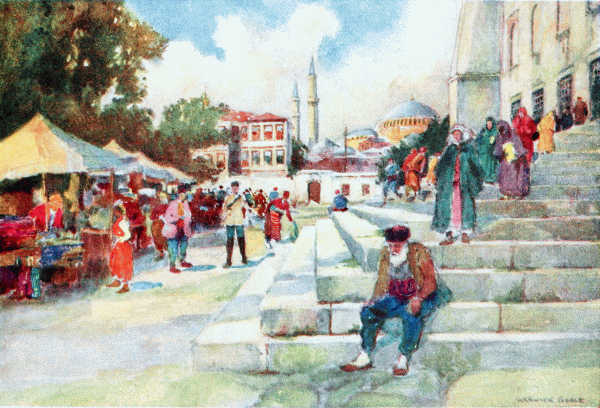
MARKET IN THE COURT OF THE MOSQUE OF SULTAN AHMED I.
The courts of the mosques are often used for market-places.
The Turkish occupation is therefore accountable for the destruction of many ancient churches of the city. Indeed, if we may believe the historian of the Greek Patriarchate from 1453 to 1578, there was a moment when the Christian community was threatened with the loss of every church, old or new, in its possession. The graphic story is too long to be told here in all its details, but it is so characteristic of the parties concerned, and of the prevalent method (not yet quite obsolete), of creating and turning a difficult situation, that a summary account of the affair may be permitted. The scene is laid either in the reign of Selim I. or of his son Suleiman the Magnificent, when the Patriarch Jeremiah occupied the patriarchal throne for the second time. And the play opens with the determination of a fanatical Turkish party to insist upon142 the law that the inhabitants of a city captured by force of arms should be denied the right of worship, and should have their churches either confiscated or levelled to the ground. The Sheik-ul-Islam of the day had issued his fetva to that effect, and in five days the sentence was to be carried into execution. A high Turkish official, who was in the secret, informed a Greek notable of the storm at hand, and the latter reported the matter immediately to his ecclesiastical chief. After much weeping and many prayers, the patriarch mounted his mule and hastened to the residence of the Grand Vizier, with whom, happily, he was on the best of terms. The result of a long interview was that the patriarch was dismissed with an invitation to attend the Council of Ministers, and inform them that, while it was true that Sultan Mehemet attacked the city and destroyed a portion of the fortifications, the Greek Emperor had not carried matters to the bitter end, but went betimes to the Sultan, surrendered the keys of the city, and, after a friendly reception, brought him into Constantinople in a peaceable manner. Whereupon, the patriarch, somewhat relieved, paid a round of visits to the various Ministers of State and to other influential personages, not forgetting to leave in each case a 143suitable parting gift. An extraordinary Council of Ministers was then summoned to consider the question, and before that assembly the patriarch duly appeared. Meantime the news of the impending catastrophe had spread, causing great excitement, so that an immense crowd of Greeks, Armenians, and even Jews, collected outside the Council Chamber, to learn as early as possible the result of the deliberations within. The terrible fetva was solemnly read, accompanied by the announcement that not only would it be applied to the case of Constantinople, but to every town captured by the sword throughout the Empire. “O my lord,” cried the patriarch in a loud voice, addressing the Grand Vizier, “as to other cities I am not sufficiently informed, but as regards this city I can vouch that when Sultan Mehemet came to fight against it, Constantine, with the consent of his nobles and people, did homage to him and surrendered the place voluntarily.” “Have you,” inquired the Grand Vizier, “any Moslem witnesses who were in the army of Sultan Mehemet when he took the city, and who can tell us how he took it?” “I have, O my lord,” was the prompt reply. “Then come to-morrow to the Council, and meantime we shall take the Sultan’s pleasure144 on the subject,” said the Grand Vizier. Followed through the streets by the whole Christian population of Stamboul and Galata, the patriarch stood next day before the Council once more, and was informed that His Majesty would be pleased to accept Moslem testimony to the correctness of the statement that Constantinople had capitulated and was not taken by force. “But O my lord, the witnesses you demand are not here; they are at Adrianople; and to send for them and to bring them will involve a delay of twenty days,” pleaded the patriarch. The delay was granted; messengers, provided with a large sum of money and other gifts, were forthwith despatched to Adrianople; the witnesses sought were found; and soon they were welcomed with raptures of joy at the gates of the patriarchate. After resting for two days, they were received in private audience by the Grand Vizier, and were assured that they could safely affirm whatever the patriarch might desire them to say. Accordingly, at another meeting of the Council, the patriarch was asked to produce his witnesses, failing which the fetva would be carried out. “They are standing outside,” he answered. Two aged men were then introduced, their eyes running with rheum and145 red as raw flesh, their hands and feet trembling beneath the burden of years, their beards white as driven snow. Never before had the assembly beheld men so venerable with age.
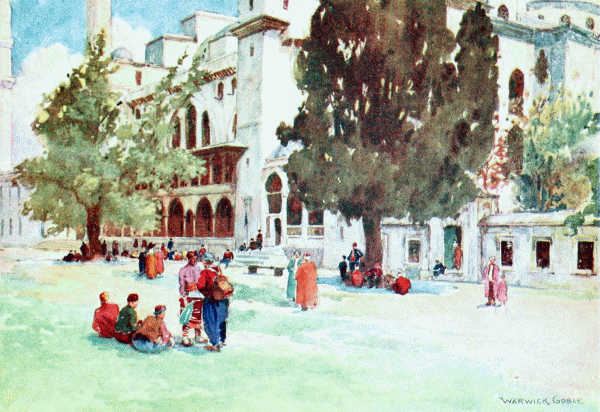
COURT OF THE SULEIMANIYEH
Along the low wall to the left are a number of water taps for the Moslems to perform their ablutions before going to prayer.
“What is your name?” the first witness was asked. “Mustapha.” “What was your father’s name?” “Genouze.” “And (to second witness) what may your name be?” “Pirez.” “And your father’s name?” “Rustem.” “How long is it since Sultan Mehemet took this city?” “Eighty-four years, to a day.” “How old were you then?” “Eighteen.” “How old are you now?” “One hundred and two years old.” “Mashallah, Mashallah” (God protect you), exclaimed the members of the Council, and stroked their long beards. “In what capacity did you serve under Sultan Mehemet?” “As janissaries.” “How was the city taken, by fighting or by surrender?” “By surrender.” Then followed a long garrulous narrative of the circumstances of the capitulation of the city, all of which went to prove the historical trustworthiness of everything the patriarch had stated on that subject. Finally, a report of these proceedings was drawn up and presented to the Sultan, who, after expressing his surprise, natural or feigned, ordered that the patriarch should have no further146 anxiety about the churches of his communion “so long as the world standeth.”
Notwithstanding that order, however, the Greek community subsequently lost several churches in its possession at that time, including S. Mary Pammacaristos, then the patriarchal cathedral, with the result that it can now boast of only some six insignificant sanctuaries which were founded in the period of the Byzantine Empire. But excepting certain portions of S. Mary Mouchliotissa in the Phanar quarter, none of them can claim to be ancient fabrics. There are in Turkish hands about twenty-five Byzantine churches, and, though sadly altered, most of them retain enough of their original features to be interesting objects of study.
CHAPTER VIII
among the churches
As historical landmarks, these churches are of very great value, and if Byzantine history were more generally studied they would enjoy wider fame. They enable the historian to fix a date, to give a local habitation to many events and scenes, to grasp a solid fragment of a form assumed by the life of humanity, and to feel how thoroughly real that life was. In them one touches hands that have vanished, and hears the echoes of voices that are still. The Church of S. Irene, which, under Turkish control, has been employed both as an arsenal and as a museum, carries the mind back to the foundation of the city. Indeed, there is reason to think that it was one of the Christian sanctuaries of Byzantium before the town was transformed into the capital of the East, for two early authorities assert that Constantine only148 enlarged and beautified the church in order to make it match its new surroundings. But be that as it may, it is certain that, since the destruction of the Church of the Holy Apostles to make room for the Mosque of Sultan Mehemet, S. Irene has been the only sanctuary in the city that can claim connection with Constantine. Within its walls, it is said, the General Council summoned by Theodosius I. to restore the orthodoxy of the Church and Empire in 381 held its meetings. Occasionally, when S. Sophia for any reason was not available, S. Irene served as the patriarchal church, and is therefore sometimes designated the Patriarchate, and the Metropolitan Church. It was burned to the ground during the Nika riot, but was included by Justinian in the splendid restoration of the buildings destroyed on that occasion. It was ruined again by the earthquake of 740, and once more restored by Leo III. the Isaurian. To it, therefore, is attached the memory of the hero who defended Constantinople in the second siege of the city by the Saracens, a service to the world as important as the defeat of the same foe on the field of Tours by Charles Martel fourteen years later. “At this time,” to quote Professor Bury, “New Rome, not Old149 Rome, was the great bulwark of Christian Europe, and if New Rome had fallen it might have gone hard with the civilised world. The year 718 a.d. is really an ecumenical date, of far greater importance than such a date as 338 b.c. when Greece succumbed to Macedon on the field of Chæronea, and of equal importance with such dates as 332 b.c., when an oriental empire (Persia) fell, or of 451 a.d. which marked the repulse of the Huns.”
Another church of historical interest is S. Saviour-in-the-Chora (country), now Kahriyeh Djamissi, and popularly known as the Mosaic Mosque, on account of the remarkable mosaics it still contains. It was clearly in existence previous to the year 413, as thereafter it stood within the line of the Wall of Anthemius, and could not then acquire the distinction of being situated “in the country.” Accordingly, it is a topographical landmark as regards the original extent of the city, only second in importance to Isa Kapou Mesdjidi, which we have seen indicates the line of the Constantinian Wall, the position of the first Golden Gate, and the situation of the Exokionion. Like every church with so long a life, S. Saviour-in-the-Chora has known many changes. It saw its best150 days in the fourteenth century, when it was thoroughly renovated by Theodore Metochites, and invested with the splendour which still glows upon its walls, and makes it one of the most beautiful of the old churches of the Byzantine world.
Not less interesting historically is the Church of S. John the Baptist (Mir-Akhor Djamissi), situated in the quarter of Psamatia. It was founded about 463 by Studius, a Roman patrician who, like many other persons, when old Rome was tottering to its fall, fled from the West to the East, as when New Rome neared its end, some thousand years later, men escaped from the East to the West. The church was attached to a large monastery belonging to the order of the Acœmetæ or Sleepless Monks, who were so named because they celebrated Divine service in their churches day and night without intermission. According to the original constitution of the society the members of the order represented various nationalities, Greek, Latin, Syrian, and were divided into companies which passed from hand to hand, in unbroken succession, the censer of perpetual prayer and praise. They sought thus to make the worship of God’s saints on earth resemble that of the assembly gathered from all nations and peoples151 and tongues that serves Him without ceasing in heaven.
As might be expected from the number and zeal of its inmates, the monastery of Studius was highly venerated, and wielded immense influence. Its abbot ranked first among the abbots of the capital, and to it the Emperor was bound to pay an annual State visit on the 29th August, one of the Baptist’s festival days. On that occasion the Emperor usually came by water in the imperial barge from the Palace beside the Hippodrome, and landed at the Gate (Narli Kapoussi) on the shore below the monastery, where the abbot and his monks waited to receive the sovereign. In this monastery the Emperor Isaac Comnenus in 1059, and the Emperor Michael VII. in 1078, assumed the monk’s cowl. The former even served as porter at the monastery gate, and so152 happy was he in his retirement from the pomps and vanities of the world, that when his wife, who had taken the veil at the time of his abdication, visited him, he said to her, “Acknowledge that when I gave you a crown I made you a slave, and that I give you freedom when I took it away.” His wife’s last command was “that her body should be buried in the cemetery of the Studion as a simple nun, with no sign to indicate that she was born a Bulgarian princess and had been a Roman empress.”
No monks in the history of Constantinople showed themselves so independent of ecclesiastical and State control as the monks of the Studion. Enough to recall the fact that in the controversy which agitated Constantinople and the Church at large for over a century (725-842), as to the lawfulness of using pictures and statues in religious worship, the monks of this monastery were the boldest and most determined opponents of the Iconoclast emperors. The abbot Theodore, who for many years led the opposition to the imperial authority in that matter, is one of the great figures of the Eastern Church. Eight occupants of the Byzantine throne found him a man who for conscience sake defied all their authority,153 rejected all their favours, and endured any suffering they chose to inflict. When the Synod, held in 815, ordered icons to be banished from the churches, Theodore and his monks carried the sacred pictures in procession through the streets, and gave them an asylum in his monastery. Nor was he only stern. He caused the rejection of the treaty of peace with Crum, the King of Bulgaria, because of the demand it contained to surrender the fugitives from that monarch’s hard rule, many of whom had become Christians. To do so, Theodore argued, would be to make void the gracious words, “Him that cometh unto me I will in no wise cast out.” He held the view that no monk should keep slaves, and condemned the persecution of the Paulicians, urging that they who are ignorant and out of the way should be instructed, not persecuted. There is a prevalent impression that the pages of Byzantine history contain nothing but the recital of the life of a servile and ignoble community, of a race of men who trembled at the nod of any despot and were void of all independence of thought and action. That such a spirit often prevailed is undoubted. But if the Byzantines had the faults of our human nature, they were not altogether without some of its154 virtues. And whatever our opinions on the questions, political or ecclesiastical, that divided parties in Constantinople, may be; although we may think that good men in that city did not always take the wisest course; it is but common justice and fair play to recognise that there also was found, in the face of great difficulties, what we admire elsewhere—a sense of the rights of conscience, some demand for freedom of thought, the feeling that right and truth are the supreme authorities over human life, and that rulers, like other men, should do justly and love mercy. There, as well as elsewhere, men and women were found who preferred to suffer and to die rather than prove faithless to their convictions.
The monastery of Studius is, moreover, celebrated for its attention to hymnology, counting its great abbot Theodore, his brother Joseph, and two monks, both named Simon, among the writers of sacred poetry. It had also a scriptorium in which the Scriptures and other religious works were copied. It was, moreover, famed as an “illustrious and glorious school of virtue,” and thither youths of the higher classes of society went for a part of their education. One of the attractions offered by the school was the facility155 with which students in an institution so near the fortifications could get out of the city to hunt in the open country. The relics preserved in the church drew devout pilgrims to its shrine from far and near. Many Russians visited the monastery on that account, and even entered the order of the Acœmetæ to live and die beside the sacred remains. The humble tombstone of one of these Russian monks is built in the base of the modern wall enclosing the ground behind the apse. It bears the inscription, “In the month of September of the year 1387, fell asleep the servant of God, Dionysius a Russian; on the sixth day.” The honour of burial in the cemetery in which the Sleepless were at last laid to rest was accorded also to men distinguished for their public services, as in the case of the patrician Bonus, who bravely defended Constantinople in 627 against the Avars and the Persians, while the Emperor Heraclius carried on his daring campaigns far away in Persia itself.
SS. Sergius and Bacchus (Kutchuk Aya Sofia) and S. Sophia still reflect the splendour of the spacious days of Justinian the Great; days in which men still dreamed of the restoration of the Roman Empire to its ancient bounds; days in156 which the justice which Rome had developed was codified and enthroned to be the eternal rule of all nations that seek to establish righteousness between man and man. The former sanctuary was built by Justinian, probably in 527, as a thank-offering to the martyrs to whom the church was dedicated, for having saved him from the death to which he had been sentenced, on account of his implication in a plot against the Emperor Anastasius. No wonder that, when the lustre of the imperial diadem shed light upon the full meaning of his deliverance, his saviours became the objects of his special gratitude and veneration. The erection of the church was one of the first acts of his reign; he placed it in the immediate vicinity of his residence while heir-apparent, and at the gates of his palace when Emperor; to it he attached a large monastery, endowed with his private fortune. There cleaves therefore to the building the personal interest that belongs to anything done in a man’s most earnest mood. Among the historical associations that gather around the edifice is the fact that it was the church assigned to the Papal Legates at the Court of Constantinople, for the celebration of Divine service in the Latin form. Originally, indeed, that distinction belonged157 to the basilica of SS. Peter and Paul which stood beside SS. Sergius and Bacchus. The special regard cherished for the two great apostles in the West would naturally make a church dedicated to them in Constantinople the most acceptable religious home for the Roman clergy on a visit to the city. But the basilica of SS. Peter and Paul soon disappeared, under circumstances of which we have no record, and then SS. Sergius and Bacchus, virtually a part of it, was placed at the disposal of Latin priests. This fraternal custom was often interrupted by the quarrels which, from time to time, rent Eastern and Western Christendom even before their final separation, but it was restored whenever the two parties were reconciled. Pope John VIII., for instance, thanks Basil I. (867-886) for granting the use of the church again to the Roman See, in conformity with ancient rights. Among the Papal representatives in Constantinople was Pope Gregory the Great (590-614), while still a deacon, and at a time when the ecclesiastical rivalry between the Sees of Old Rome and New Rome was keen. It must have been with something of the feeling that sprang from personal acquaintance with scenes and men in the rival metropolis that he protested, when Pontiff, against158 the assumption of the title “œcumenical bishop” by the Patriarch John the Faster in 587, and that he adopted in contra-distinction the well-known style of the Popes “the servant of the servants of God.” Pope Vigilius spent several unhappy years (547-554) in Constantinople, in controversy with Justinian and the patriarch of the day, and in the course of the dispute had occasion to flee to the Church of SS. Peter and Paul, for refuge from the Emperor’s displeasure. Notwithstanding the right of sanctuary, Justinian gave orders for the arrest of the Pope in his place of retreat. But when the officers sent for that purpose appeared, Vigilius, a man of uncommon size and strength, clutched the pillars of the altar, and refused to obey the imperial summons. Thereupon, the officers pulled him by his feet and hair and beard, to force him to let go his hold. But the bishop held fast, and could not be moved until the pillars to which he clung gave way, and threw him and the altar to the ground. This was too much for the indignation and sympathy of the spectators who crowded the church. Coming to the rescue, they put the assailants to flight, and left the Pope master of the situation. It was only after a distinguished deputation, led by Belisarius, waited upon him next 159day, warning him that resistance to the Emperor’s authority would be vain, and assuring him that submission would prevent further ill-treatment, that Vigilius came forth from the church. This was in 551. The church was attached to a large and rich monastery known as the monastery of Hormisdas, after the name of the district in which it stood. Like the members of other monasteries in the city, the monks of this House took their full share in the theological controversies of their day.
Among the crowd of events witnessed under the dome of S. Sophia, there are three scenes of paramount importance in the religious history of the world that lend to the Great Church an extraordinary interest. The first occurred on the day on which the envoys of Vladimir attended service in the cathedral, and were so overwhelmed by the splendours of the worship, that they hastened back to Russia to tell their sovereign that they had seen the glory of the true God. “We know not,” they are reported to have said, “whether we were not in heaven; in truth, it would be impossible on earth to find such riches and magnificence. We cannot describe to you all that we have seen. We can only believe that there in all likelihood one is in the presence of God, and that the worship of160 other countries is there entirely eclipsed. We shall never forget such grandeur. Whosoever has seen so sweet a spectacle will be pleased with nothing elsewhere.” The conversion of the Slavic peoples to the Christian faith, a work commenced in the ninth century by the mission of Cyril and Methodius to the Slavs of Bulgaria and Moravia, is one of the most important services rendered by the Church of the Byzantine Empire to the cause of European civilisation. So far as its political significance is concerned, it can stand comparison with the conversion of the Teutons by the Western Church. It accomplished what the victories of Zimisces failed to achieve.
It was the moral conquest of Russia, and the source of her upward life, until that country was opened also to the influence of Western civilisation. It probably saved Russia from becoming a Mohammedan State. The Slavic peoples rightly cherish a regard for Byzantine Constantinople, similar to that which Western Europe feels for Athens and Rome.
The second scene, to which we refer, took place on the 15th July 1054. On the morning of that day, as Divine worship in the cathedral was about to commence, three papal legates, Cardinal Hum161bert, Cardinal Frederic, and the Archbishop of Amalfi, made their way through the crowd of worshippers to the steps of the altar. Having denounced the Patriarch Michael Keroularius for insubordination to the Holy See, the legates placed upon the altar a bull of excommunication against him and his adherents. They left the church, shaking its dust off their feet, and exclaiming, “Videat Deus et judicet.” In due time the patriarch hurled back a counter-anathema; and, thenceforth, the Christian world was divided in two bitterly hostile camps. It was the wave precipitated against the shore by waves that had tossed the ocean’s expanse, for league upon league. It was the consummation of a long process of disruption between the West and the East, the course of which is marked by such events as the foundation of Constantinople, the jealousy between Old Rome and New Rome, the invasion of the Teutons, the establishment of the Holy Roman Empire, race antipathies, and wrangles over the phrase Filioque, the use of images, the celibacy of the clergy, and the employment of unleavened bread in the Eucharist. Behind all this discord, we may be able to detect men groping for the truth, and resisting absolutism in Church and State. But it has left Christendom162 weakened both as a political and a religious power to this day.
On the 29th or 30th of May 1453, Sultan Mehemet the Conqueror alighted from his horse at the gate of S. Sophia. It was most probably at the “Beautiful Gate,” at the southern end of the noble inner narthex of the church, the entrance through which the Emperors of Constantinople usually proceeded to the cathedral. According to one account, the Sultan stooped down at the threshold, took some earth, and scattered it on his head in token of humiliation before God. Entering, he saw a Moslem breaking the marble pavement. He struck at the vandal with a scimitar? for daring to injure a building that belonged of right to the sovereign. Then, in what to the Eastern world was the Holy of Holies of Christendom, an imaum ascended the pulpit and cried aloud, “There is no God but God, and Mahomet is His prophet.” And so it has been ever since.
The Church of S. Saviour Pantepoptes, the All-Seeing (Eski Imaret Djamissi), the Church of S. Saviour Pantocrator, the All-Powerful (Zeirek Kilissé Djamissi), and the interior of S. Saviour-in-the-Chora (Kahriyeh Djamissi), recall the period of the Comneni and the Angeli (1081-1204).163
In their erection ladies of considerable importance in the history of Constantinople had a part. The first was built by Anna Dalassena, the mother of Alexius I. Comnenus; the last was restored by his mother-in-law, Mary Ducæna, a Bulgarian princess famous for her beauty; the second was an erection of the Empress of John I. Comnenus, the daughter of Geysa I., King of Hungary. These churches represent the age when Constantinople was stirred by the march of the earlier Crusades through the territory of the Empire, when Peter the Hermit and Godfrey de Bouillon encamped their followers within sight of the city walls, to be dazzled by the splendours of the Palace of Blachernæ, and cajoled by the diplomacy of Alexius I. Comnenus. They also recall the time when Henrico Dandolo, the Doge of Venice, brought his fleet and the troops of the Fourth Crusade to the Golden Horn, and founded the short-lived Latin Empire of Constantinople. It was on the terraced ground beside the Church of Pantepoptes that the Emperor Alexius Murtzuplus pitched his vermilion tents and drew up his reserve forces. There he stood to see the walls on the shore below attacked by the Venetian ships and carried by Frankish knights. From that position he fled at the approach of a164 body of the enemy’s horsemen, and under his unstricken vermilion tent Count Baldwin of Flanders and Hainaut, soon to succeed him as Latin Emperor of Constantinople, spent the night of that memorable day.
The monastery of the Church of the Pantocrator became the headquarters of the Venetians during the Latin occupation of the city. In the relations of Western and Eastern Christians to each other during the period of the Crusades there is nothing of which we can feel proud. The former were barbarous, the latter were decadent; neither of them worthy to recover the San Graal in search of which so much heroism and devotion were displayed for two centuries. But it is well to remember that the encounter of the East and the West during those expeditions contributed not a little to the “infiltration,” as it has happily been phrased, “of ideas, knowledge, and art from the Grecised Empire into Western Europe.” It brought the influence of an older and riper civilisation to bear upon the younger life that had come into the world, and aided that life to evolve a new and better order of things.
The Venetian occupants of the monastery of Pantocrator, for instance, could learn much from the admirable organisation of the hospital main165tained by that House for the benefit of the poor. The hospital contained fifty beds, of which ten formed a ward for surgical cases, eight a ward for acute diseases, ten for ordinary maladies, and twelve a ward for women. A fifth ward contained ten beds for the reception of applicants for admittance into the other wards of the hospital, until the physicians should decide upon the gravity of the cases. Each ward was in charge of two doctors, three medical assistants, and four servitors.
To the women’s ward were attached a lady-physician, six assistant lady-surgeons, and two female nurses. All patients were treated gratuitously. Upon arrival at the hospital a patient’s clothes were laid aside, and replaced by a white dress provided by the institution. There was a liberal allowance of bread, beans, onions, olive oil, and wine, for all able to partake of such food, while from time to time gifts of money were distributed. The beds were kept clean, and a house-doctor went through the wards every day to inquire of the patients, whether they were satisfied with their treatment, and to examine their diet. In addition to the hospital, the monastery maintained, on the same liberal scale, a Home for Old Men, accommodating twenty-four persons.166
The inhabitants of Constantinople were sinners, though not sinners above all men, as they are often represented. But in their hospitals, orphanages, asylums for the aged, free caravanseries, asylums for lepers, and other institutions “to give rest to those whom trouble had distressed,” which humanised the city with compassion, they were distinguished also for that charity which covereth a multitude of sins.
The Churches of S. Mary Pammacaristos (Fethiyeh Djamissi), the Church of S. Theodosia (Gul Djamissi), and portions of S. Saviour-in-the-Chora, carry us to the times of the Palæologi, the dynasty that occupied the throne of Constantinople during the last one hundred and ninety years of the city’s history as New Rome. It is the period of the long struggle with the Ottoman Turks, and the culmination of the conflict between the Mohammedan world and Christendom which had filled more than eight centuries with its hate and din; when the sign in which the Empire had conquered yielded to the sign of the crescent, and the benediction of the prophet of Islam—“Whoso taketh the city of Constantine, his sins are forgiven”—found at length a man upon whose head it could settle. It is a sad period of Byzantine history; yet one noble167 idea, at least, appealed to its mind—the Reunion of Christendom—which, if realised, would have changed the history of Europe. But it was not to be.
Like all the churches of the city situated near the fortifications, the Church of S. Saviour-in-the-Chora was regarded with special veneration as a guardian of the safety of “the God-defended capital,” and there, during the siege of 1453, was placed, as an additional pledge of security, the icon of S. Mary Hodegetria, attributed to S. Luke. But the church was the first sanctuary into which Turkish troops broke on the fatal 29th May for pillage. They spurned to take the icon as a part of their plunder, and in mockery of its vaunted power hacked it to pieces. The Latin Church of S. Peter in Galata claims to possess one of the fragments.
With S. Theodosia is connected the pathetic association that the festival day of the church coincided with the day on which the city fell in 1453. The area and galleries of the building were packed by a large and earnest congregation that kept vigil through the night-watches, praying for the safety of the Queen of Cities, when suddenly, soon after the sun had risen, the wild rush of soldiers168 and shouts of victory in strange accents told that the enemy had triumphed, and that the day of vengeance was at the door. No massacre ensued, but the whole congregation was doomed to slavery.
The Church of the Pammacaristos served as the cathedral of the patriarchs of Constantinople for one hundred and thirty-five years after 1456, when deprived of the Church of the Holy Apostles.
These churches put the period of the Palæologi before us in also a pleasing aspect. The mosaics which adorn the narthex and exo-narthex of the Church of S. Saviour-in-the-Chora imply, that love for the beautiful and skill to express it had not fled the city which reared S. Sophia. The proportions of S. Theodosia are exceedingly fine, and the chapel attached to the Pammacaristos is, at least externally, remarkably attractive. Nor had intellectual life and scholarship altogether ceased. The historian Nicephorus Gregoras was a monk in the monastery of S. Saviour-in-the-Chora, and wrote his work in the retirement of his cell. The historians Pachymeres, Cantacuzene, Phrantzes, Ducas, were not the products of an ignorant age. The Greek scholars who took refuge in the West, and contributed to its intellectual revival, represented a society which, with all its faults, had169 not lost its interest in the literature of ancient Hellas, or in general knowledge. Indeed, in studying the period of the Palæologi, one continually meets a spirit akin to that which produced the Renaissance in Western Europe. And, notwithstanding the vanity of indulging in dreams of what might have been but never has been, the mind obstinately asks, What if that upward movement had not been checked by a great political catastrophe? What if it had been accompanied by moral reform and military prowess?
CHAPTER IX
among the churches
But however interesting the old churches of the city are as historical landmarks, however useful as a clue to guide us through the labyrinth of the life of New Rome, their supreme value after all consists in the fact that they are monuments, one of them the finest monument, of what is styled Byzantine Art—the art which blended artistic elements derived from Greece and Rome with artistic elements borrowed from Nineveh, Persia, Syria, and unfolded a new type of beauty. It was the flower developed by that fusion of Western and Oriental æsthetic ideals and tastes resulting from the long intercourse maintained between Europe and Asia, sometimes at the point of the sword, and sometimes by the peaceful ministries of commerce. Nowhere could that Art find a more congenial atmosphere in which to171 flourish than in the city which binds the West and the East together. Like all else in the world, Byzantine Art was not a sudden creation, independent of all antecedents, unheralded by previous analogous forms. The dome was reflected in the waters of the Tigris and of the Tiber before it was mirrored in the Bosporus. Columns were bound together by arches instead of by a horizontal entablature, in the Palace of Diocletian at Spalato, before they were so united in the Sacred Palace beside the Hippodrome of Constantinople. Walls glistening with variegated marbles, marble floors glowing with colours that vied with meadows in flower, mosaics radiant with the hues of the rainbow, had adorned homes and made palaces beautiful before the witchery of such coloration cast a spell over the courtiers of Justinian, or suffused the light in S. Sophia. Even the pendentive that fills the triangular space between two contiguous arches at right angles to each other, so characteristic of Byzantine architecture, is claimed to be an earlier device in domical construction. Be it so. In one sense, there is nothing new under the sun. The new grows out of the old, the present is the product of the past. And yet, while a new order of things must spring from an old order, it is not the bare172 repetition of what has been; while it must employ materials shaped originally for the use of other days, it is not the mechanical combination of those materials. It employs them in another spirit, under the control of ideas different or more mature than have yet been known, as the utterance of feelings acting with peculiar force at particular moments in history, with more skill, on a larger scale, with happier effect, and the result is that something appears with an individual entity perfectly distinguishable from all that ever was before, or that will ever come after. Byzantine Art is its own very self, however many adumbrations prophesied its advent.
The oldest ecclesiastical edifice in the city—the Church of S. John the Baptist, attached to the monastery of Studius—does not, however, represent Byzantine architecture. Built in 463, it is a basilica, and accordingly is a specimen—the only specimen in Constantinople—of the earliest type of a Christian sanctuary. It was well-nigh destroyed in a conflagration that devastated the district of Psamatia in 1782, and its roof was crushed in by a heavy fall of snow some three winters ago. But, though only the shadow of its former self, its primitive character can be clearly recognised. The173 old atrium before the church is still here, with a phiale or fountain in its centre for the purification of the gathering worshippers. Of the colonnaded cloister along the four sides of the atrium, the western portion, borne by four columns and forming the narthex of the church, still stands. There catechumens and penitents, unworthy to tread the holy ground within the sanctuary, stood outside and afar off. Beautiful trees now spread their branches over the court, and the shaded light falls upon turbaned Moslem tombs, as of yore it fell upon the graves of Christian monks, from the trees growing in the Paradise of the monastery. It is the most peaceful spot in all Constantinople, and as fair as it is calm and quiet. The narthex belongs, undoubtedly, to the original fabric. Its marble pillars crowned by Corinthian capitals of a late type bear a horizontal entablature, and the egg and dart ornament, the dentils, the strings of pearls, familiar in the friezes of Greek and Roman temples mingle with foliage, birds, and crosses, expressive of new ideas and tastes. Within, the interior was a hall 89 feet by 83, divided by a double row of seven columns of verde antique marble, into a nave and two aisles. The proportion of length to breadth is greater than is usual in174 basilicas of the West, and an indication of the tendency to assume the square plan which Byzantine architecture so strongly manifests. The long lessening vistas so impressive in Western churches are rarely, if ever, found in an Eastern sanctuary. In the latter the structure is more compact, and the worshipper stands before a Presence that compasses him about alike on every side. At the eastern end of the nave is the usual apse, semicircular within, a polygon of three sides on the exterior. Triforium galleries, now gone, divided the aisles in two stories, the upper storey bearing also columns of verde antique. The columns of the lower tier were bound by a horizontal entablature, while their fellows above were united by arches, a mingling of old and new forms. The roof was of wood, as in similar basilicas elsewhere. The church recalls the Church of S. Agnes at Rome. Its disappearance will be a matter of deep regret, not only as an ancient landmark, but as an edifice which preserved the surroundings of early Christian congregations, and reflected, however faintly, the light of classic days, through all the changes of the city’s tastes and fortunes.
The Church of S. Irene, notwithstanding the serious restorations it underwent in the sixth175 century and again in the eighth, retains so much of its early basilican type that it can claim a place among the churches of the older style. In spite of the two domes placed longitudinally upon its roof, it is basilican in the proportion of its length to its breadth, in the retention of lines of piers and columns to divide its nave and aisles, in its single apse, and the galleries on three sides. The apse has the interest of still preserving the tiers of marble seats for the clergy, as in the Cathedral of Torcello. Its conch is adorned with the mosaic of a large black cross on gold ground, and on the face of the triumphal arch may be read the invocation calling upon the Hope of all on the earth or upon the sea to enter His temple, and pour His Spirit upon His people.
SS. Sergius and Bacchus, styled by the Turks little S. Sophia (Kutchuk Aya Sofia), on account of the resemblance it bears to the greater church of that name, is interesting from more than one point of view. It deserves attention as a thing of beauty. Imagine an octagonal building constructed of eight lofty piers united by arches. Cover that structure with a dome furrowed by sixteen flutings. Let the sides in the diagonals be curved and the sides in the axes be straight, to176 secure more room, to avoid monotony of contour, stiffness, angularity, and to introduce the variety, freedom, softness, which give wings to fancy. Within each archway, except the one at the east, where the semicircular apse recedes to make room for the altar and the seats of the clergy, place four columns in two tiers, now green mottled with black spots, now cream-coloured marked with red veins, now white marked with veins of dark blue. Crown the lower columns with capitals, whose lobed form has been compared to a melon partly cut open, but which might, more gracefully, be likened to a tulip bud breaking into flower. Bind these columns, after the old fashion, with a horizontal entablature, where acanthus, egg and dart, reeds and reel, dentils, strands of rope and the ornamental letters of an inscription, in honour of S. Sergius and of the founders of the church, Justinian and Theodora, combine to make a splendid frieze. Join the upper columns, according to the new taste, with arches supporting conchs, and resting on long, flattened capitals covered with marble lace. Revet all surfaces up to the cornice with variegated marbles, and above the cornice spread mosaics. Then put this octagonal fabric, with its undulated interior surface, thus carved and coloured and gemmed,177 into a square edifice, like a jewel into a casket; so that the apse may protrude beyond the square’s eastern side, and the aisle, between the octagon and the square, may be divided into two stories by galleries, and the round dome may soar aloft visible to all without, and you have some idea of the plan and beauty of this gem of Art.
Another consideration that lends interest to SS. Sergius and Bacchus is its striking resemblance to the Church of S. Vitale at Ravenna. The latter was commenced in 526, a year earlier than the former, while Theodoric the Great ruled his Ostrogoths in the fair city beside the Adriatic. It was not completed, however, until 547, after the arms of Justinian had restored Ravenna to the Roman Empire. A comparison between the kindred buildings would be invidious. Let it suffice to say, speaking broadly, that the exterior arrangements of SS. Sergius and Bacchus are superior to those of its western companion, while the interior of S. Vitale is more beautiful than the interior of the church on the shore of the Sea of Marmora. But, leaving comparisons between two beautiful objects alone, it is pertinent to recognise the artistic influence of Constantinople over Art in the West here manifested. For,178 although the churches are too different for the one to have been copied from the other, they are so similar as to prove the existence of a common school of Art; a school which had its chief seat in the studios and workshops beside the Bosporus. Even some of the materials of S. Vitale were imported from the East; among them, “melon-capitals” like those which adorn the columns on the ground-floor of SS. Sergius and Bacchus.
The similarity of the two churches has yet another interest. Their likeness constitutes them symbols of Justinian’s great policy—the reunion of the East and the West, a reunion maintained for some two hundred years after its consummation. Since that unity was impaired, they have stood, one beside the Adriatic, the other beside the Marmora, like hills which erewhile formed sides of the same mountain, and rose to the same peak, but which a cruel tide has torn apart and holds separate, in spite of their kinship.
But, perhaps, the chief interest attaching to SS. Sergius and Bacchus is the fact that it represents a stage in the solution of the problem how to crown a square building with a dome, the characteristic mark of Byzantine architecture.
To cover a round building, round from summit179 to base like the Pantheon, with a dome is comparatively an easy matter, for in that case two circular structures meet and fit together along the whole circuit of their circumferences. On the other hand, to set the round rim of a dome upon a square substructure seems an attempt to join figures which from the nature of things can never coalesce.
Such a union is conceivable, only if, by some device, the different figures can, at least at some point, be cut to the same shape. The problem to be solved may therefore be stated as the question, whether the summit of a square structure can be converted into a circle corresponding to the rim of the dome it is to support. In SS. Sergius and Bacchus we have the type of a building in which a step was taken in that direction. There, as we have seen, the base upon which the dome rests is formed by a substructure consisting of eight arches arranged in the figure of an octagon; the gaps at the angles, where arch bends away from arch, being filled with masonry to the level of the heads of the arches. Such a base, it is true, does not match the dome as accurately as a round substructure like the Pantheon. Still, an octagon approximates to a circle more closely than a square does. Its contour offers more points of contact180 to the orbed canopy set upon it, and the gaps at its angles, being comparatively small, can readily be filled up to afford the dome a continuous support. If the fit is not perfect, it is sufficient to secure a decided advance beyond the simpler art, which knew only how to put one round thing upon another round thing. And what beautiful results could be gained by this advance, SS. Sergius and Bacchus in Constantinople and San Vitale at Ravenna are there to prove. But the end was not thus reached. Circular buildings and octagonal buildings are exceedingly beautiful; they should always stay with us. But they are not the most convenient, and cannot become the buildings in general use. For the practical purposes of life, square or oblong halls are in greater demand; such as the basilica, which could serve as a court of justice, a church, a school, a market, or a throne-room. Hence the question still remained, Can the summit of a square structure be turned into a circular base for a dome?
And it is the merit of the architects of S. Sophia, Anthemius of Tralles and Isidorus of Miletus, his nephew, to have applied the method which solves that problem, with such ability, such splendid success, and to have made it so conspicuous 181 and famous, that they seem the discoverers of the method, and not only its most illustrious exponents. The object which these men set themselves to accomplish was to combine the advantages of a basilican edifice with the advantages of a domical building. For, in S. Sophia, the lineaments and beauty of a basilica are still retained—the threefold division of a stately hall into nave and aisles, the recess of the apse at the east end, the galleries dividing the other sides into two stories, long lines of columns, the lustre of marble and the glow of mosaics all are here. But the ceiling of a basilica, whether flat, pointed, or vaulted, was an insignificant feature. It cramped the upward view; it vexed the eye as heavy. In a church, it seemed to fling back to earth the aspirations which sought the heavens. It was dark; through it the Light of the world could not stream into the soul.
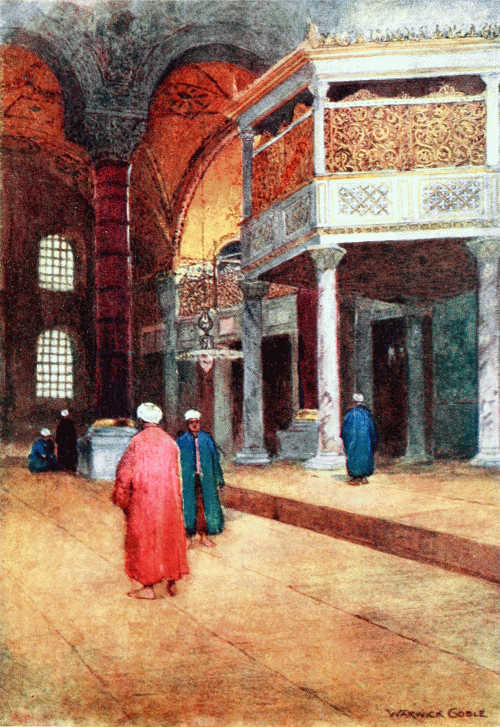
INTERIOR OF S. SOPHIA, THE SULTAN’S GALLERY
This gallery, built of marble and screened with gilt fretwork, is for the exclusive use of the Sultan; it is approached by a separate entrance.
Whereas a dome was something bold and striking; its construction evinced great architectural skill; and rewarded the labour bestowed upon it, by the dignity and the grace it gave to the building whose brow it crowned. It also appealed to the spiritual mind; it lifted the heart on high, it was kindred to the skies; it was a cloud through which the glory beyond the earth could come, in the subdued182 light that permits mortal eyes to behold the vision of God. For, most assuredly, the architects of S. Sophia were not content to rear only a marvel of mechanical skill. Like true artists they intended to compose “a poem in stone,” nay, to build a “gate of heaven.” But first that which is natural, afterwards that which is spiritual. And we must therefore glance at the method they employed to cover a basilica with a domed canopy.
In the central area, let us say, of a rectangular building, 235 feet N. and S. by 250 feet E. and W., erect a square structure of four arches. Where arch bends away from arch, there are triangular empty spaces breaking the continuity of the lines of the square summit. Such a base is not round, and it is broken. Can it be made continuous and circular—that is the question? It can. Fill the yawning triangular spaces with masonry to the level of the heads of the arches; only let that masonry be made concave, as though portions of the proposed dome were inserted between the arches, to dovetail with them. And to your surprise, perhaps, but inevitably, the square summit is transformed into a circle, capable of becoming the bed on which a dome may rest as accurately and securely, as though the square of arches was round183 and solid to the very floor. It is all very simple, after you have seen it done; but the device which introduced into those triangular gaps at the upper corners of the square the pendentives which, when they mounted to the height of the arches, converted a square into a circle was a master-stroke of genius, whoever conceived it first, and an epoch in the history of architecture. But how is this domed square structure to be connected with the walls of the rectangular area within which it is enclosed? How, especially, is it to be held in position, lest it be split open by the thrust of the dome and hurled to the ground? The double-storied aisles to the north and the south furnish the required support in those directions. But it was in the means devised to sustain the dome on the east and the west, that Anthemius and Isidorus displayed all their daring, and secured an effect that has never been matched for grandeur and beauty.
They placed two comparatively small piers to the east of the dome-crowned fabric and two to the west of it; arched the piers, and connected them to the right and the left, still with arches, with the great piers to the rear of which they respectively stood. Filling up the triangular void spaces between these arches, they thus gained a184 semi-circular base upon which to rear, at either extremity, a semi-dome, climbing with gentle curve to the feet of the great dome, to support it in its lordly place, and (if the expression may be pardoned) to stretch it from one end of the nave to the other. It is as though the octagon of SS. Sergius and Bacchus had been cut in twain and set east and west of a square surmounted by a dome, converting the central area of the church into an elliptical or oval figure.
For elasticity of spring, for the grace and majesty of its upward flight, for amplitude, for the lightness with which it hangs in air, there is no canopy like the arched roof spread over the nave extending from the Royal Gates to the altar of S. Sophia.
Poised on arches and columns, soaring from triple bays to semi-dome, and from semi-dome to dome, bolder and bolder, higher and higher, more and more convergent, culminating above a circle of forty lights, through which the radiant heavens appear, it is not strange that it has seemed a canopy merged in the sky, and that for more than thirteen centuries men have worshipped beneath it with the feeling “This is none other than the House of God!”
Only one thing more was needed to make the fabric artistically complete—to spread over it what Ruskin terms, “that most subtle, variable, inexpressible colour in the world—the colour of glass, of transparent alabaster, of polished marble, and lustrous gold.” Accordingly, all that porphyry, verde antique, white marble, marbles of variegated hues, in the form of pillar, slab, capital, inlaid patterns, could contribute, all that delicate carving, with its lights and shadows, all that mosaics bright and soft as sunset tints could lend, was brought into requisition, until every part of the interior surface was suffused in a splendid coloration, and the solid fabric stood transfigured into a pavilion of some iridescent tissue, overwrought with gorgeous embroidery, and held up on shafts of prophyry and emerald.
Many persons are, it is said, disappointed with the first view of even the interior of S. Sophia. Of course the church is not in the state which made Justinian exclaim, when he first crossed its threshold, “O Solomon, I have surpassed thee.” But, after making every allowance for the effect of what detracts from the original glory of the church, those disappointed with S. Sophia must be reminded that, as some one has remarked, “it costs186 an expensive education to admire a sunset”; and, furthermore, that it is the mark of what is truly great to transcend our immediate grasp, and to reveal its majesty only to prolonged and reverent contemplation.
S. John Studius, SS. Sergius and Bacchus, S. Sophia, and S. Irene, notwithstanding their great differences, agree in following, to an extent that can be recognised, traditions of ancient art. The light of a day, that is past and over, is still reflected from them; or, to change the figure, in them the foliage of a bygone summer mingles sparse and faded forms with the leaves of a new spring. In the other churches left in the city, old features disappear, and what is new reigns supreme. The influence of S. Sophia upon the history of Art has, it is said, been greater than that of any other single building. And yet S. Sophia has never been repeated.
Nor is this strange. A masterpiece cannot be reproduced. But we must seek farther for a complete explanation of the fact. While S. Sophia is, from one point of view, a culmination, it is, from another point of view, a stage in a process of development. The combination of basilican and domical features which it displays is a tribute at187 once to the influence of old tastes and to the influence of a new fashion. The result of the cross, so to speak, of the two influences was superb, and might well have arrested further change. But considerations, practical and theoretical, were at work urging movement onwards. Although the dome of S. Sophia was a great triumph, it was not a complete success. It rested squat upon the building, when viewed from without. And what was more serious, its thrust against the walls of the church was so strong as to demand external buttressing to prevent a fall. Furthermore, while to stand in a forest of pillars was impressive, it was a pleasure that interfered with the duty of following readily the services at the altar, and broke the unity of the congregation of worshippers. Then, men had grown somewhat weary of the basilica, and were enamoured with the dome. Accordingly, a logical necessity urged the mind to draw all the conclusions involved in the premises which had won the faith of the world of Art. Henceforth, the architectural ideal would be a domed rectangular edifice as free from pier or pillar, and as wide open to view, if that were possible, as the area beneath the dome of the Pantheon.188
Consequently, the columns or piers bordering the nave decrease in number until they are reduced to the four necessary to carry the arches upon which the dome rests. Lateral aisles become narrow; galleries disappear, or are represented by a gallery only over the narthex. Indeed, in such churches as S. Saviour-in-the-Chora, the piers that bear the dome are not free-standing supports, but narrow projections from the walls of the edifice; so that the interior is practically open to view in all its length and breadth, having neither aisles nor gallery. In dealing with the dome, the thrust was reduced, by carrying a cylindrical or polygonal turret (drum) to a moderate height above the roof, and surmounting the structure with a cupola. That the fundamental idea inspiring this movement, from the basilica to the perfect development of a domical building, was legitimate, and capable of producing magnificent results, cannot be disputed. But, for some reason, Byzantine architects in Constantinople did not realise their ideal to the extent we might expect. At least, no large church constructed on this plan is found in the city. Then a dome set upon a turret lacks mass and dignity, when viewed from without, and fails to dominate the interior, or lift eye and heart upwards, the moment the189 worshipper crosses the threshold. To look into such a dome and admire its mosaics is also difficult; sometimes, even painful.
In order to obtain a church of considerable size, the device was adopted of building several small churches side by side, furnished with a continuous narthex, and communicating with one another through their common wall or walls. The Church of S. Mary Panachrantes, situated in the Lycus valley, is an example of twin churches, while the Church of the Pantocrator offers an example of an agglomeration of three churches. At other times the same result was obtained by adding to an older church a small chapel, as in S. Saviour-in-the-Chora, and the Pammacaristos.
To overcome the lack of grandeur in a dome placed on a drum, recourse was had to the system of adorning a church with several domes, in the hope that multiplicity would compensate for the absence of mass. This employment of several domes appears already in the reign of Justinian, who crowned the Church of the Holy Apostles with five domes. When a church is small, this arrangement produces a graceful and pleasing effect, as may be seen in the domes of S. Saviour190in-the-Chora, S. Mary Pammacaristos, and the charming Church of S. Theodore Tyrone (Kilissé Djamissi, near Vefa Meidan). It is seen at its best in the domes of S. Mark’s of Venice. But after all, this multiplication of domes does not harmonize with lofty sites and broad spaces. Under the wide sky, and on the hilltops of Constantinople, it looks a petty thing. It can never attain the grandeur and sublimity essential to the highest achievements of artistic architecture. Strangely enough, the ideal of Byzantine architects is realised better in the imperial mosques that crown the summits of Stamboul, and rise above the hills on which they stand, as naturally and proudly as a peak lifts its head into the sky. How puny are the domes of the Pantocrator or those of the Pantepoptes compared with the dome of the Mosque of the Conqueror, or the dome over the Mosque of Suleiman the Magnificent, or the dome of the Mosque Shahzade, or even the dome of the Mosque of Sultan Selim! Nor is it only in their exterior aspect that the great mosques fulfil the Byzantine ideal. They do so likewise within. The long pillared lines of the basilica have vanished. In the Mosque of Suleiman the Magnificent, only four piers and four columns, the latter from Byzantine buildings,191 break the interior view. In the Mosque of Sultan Achmed, only four piers uphold the roof. And at the same time, what spaciousness! What loftiness and grandeur! If in these mosques one misses the warmth of feeling awakened in S. Sophia, one finds the same sense of the majesty of Heaven, the same suggestion of the littleness of man.
But, if we must not look for grandeur in the churches of Constantinople outside S. Sophia, we meet with much that is exceedingly attractive. This would be more evident were it not for the neglect, the wilful destruction, the inane attempts at decoration, to which the buildings have been subjected. The groined ceiling, edged with a broad band of marble lace, in the lateral apses of the Pantepoptes is very graceful. As a general rule, considerable fancy and taste are displayed in the ornamentation of capitals. The exterior of apses is sometimes rendered pleasing by tiers of blind arches, or of niches and pilasters. The portico of S. Theodore Tyrone, with its columns, melon-capitals, sculptured balustrade, retains, even in its decay and neglect, traces of remarkable beauty. There is fine work to be seen likewise in the Pantocrator. While in S. Saviour-in-the-Chora, one can spend days in admiration of its mosaics,192 frescoes, marbles, carvings, cornices, and borders. The undercut foliage, upon a dark background, which crowns the mosaic figure of the Virgin on the south-eastern pier of the church, is exquisite. Very fine also are the faces and the robes of some of the archangels in the dome of the side-chapel of the church. The mosaics on the vaulted ceiling of the inner narthex, representing traditional scenes in the life of the Virgin, are among the finest to be found anywhere. They are wonderfully rich and brilliant in colour. The marble revetment of the narthex is a splendid specimen of that style of decoration. There must have been excellent artists in Constantinople in the reign of Andronicus II., when the narthexes and the side-chapel of this church were so beautifully embellished.
Yet the visitor to the churches of Constantinople must be armed with such enthusiasm for what is historically great and artistically beautiful, that he will be stirred to pursue his way by even the minutest fragments of objects invested with these attributes. For it cannot be said of these old sanctuaries, that they have—
They have stood where no general appreciation for such things exists. They have been in the keeping of those who have no pride in their preservation, no reverence for their associations, no admiration for certain features of their beauty. They are covered not only with the dust of ages, but of neglect, ignorance, and depreciation. In visiting these churches, diverted from their original destination, and shorn of their glory, one is sometimes reminded of Gibbon sitting on the Capitoline hill of Old Rome, and listening to the barefooted monks who chanted vespers in the ruined temple of Jupiter. To his mind the spectacle suggested the Decline and Fall of the Roman Empire. So, as one hears the muezzin’s call sounding above the decayed sanctuaries of New Rome, one may feel disposed to muse on the destruction of the Roman Empire in the East. That is a natural, a legitimate, a profitable, line of thought. But it should not be the only direction our thoughts follow. The Past comes before us not only with its faults, and weaknesses, and failures. It had its virtues, its strength, its achievements. The landmarks which it has left behind are not here to recall only the vanity of human things. They are with us to carry our minds and hearts back to great examples194 and to glorious deeds. Sometimes the visitor to these “church-mosques” is offered pieces of mosaic that have fallen from the dome under which he stands. They tell of decay, it is true. But with those radiant little cubes in his hand, an artist may reconstruct the forms of saints, the figures of apostles and martyrs, the faces of angels, the majesty of the Pantocrator. So these churches, even in their humiliation, recall the great community of our fellowmen who lived their lives, and wrought their deeds, in this city for more than a thousand years, and they aid us to think the noble thoughts, to catch the love for beauty, to cherish the high aspirations, and to emulate the services which glorified that community—that these things may never pass away.
CHAPTER X
impressions of the city to-day
So much has been written about Constantinople in its Turkish character, that to say anything entirely fresh and new upon the subject is impossible. The reader must, therefore, look to the illustrations which adorn this work for the impression which the Oriental aspect of the city makes upon an artistic eye. If the writer of the text ventures to repeat some parts of a well-known tale, it is only because different ways of telling an old story vary the points of view from which the matter is regarded, bring different features into relief, and set them in another atmosphere and colour; as the appearance of the same landscape changes, according as it is seen at dawn, or at noon, or by the light of the setting sun.
Speaking of the bridge that spans the Golden Horn from Galata to Stamboul, De Amicis196 remarks that; “where every day a hundred thousand people pass, not one idea passes in ten years.” The slowness with which the East changes is, perhaps, the impression which the spectacle of life in Constantinople naturally makes upon the mind of a stranger. His attention is arrested by the differences between the scenes he observes for the first time and the scenes with which he is familiar. A fresh eye is quick to detect distinctions and peculiarities. On the other hand, “an old resident,” on the same principle, is more deeply impressed by the changes which have been wrought in the life and aspect of the city of his abode, since the days of his early recollections. To the visitor the old is new, and the new is old; while to the resident the old is familiar, and the new is strange. If the former observer has the advantage of seeing things from a more striking and picturesque point of view, the latter is closer to fact and truth. Colonel White, writing in 1844, in his interesting book, Three Years in Constantinople, which such a competent authority as Sir Henry Layard pronounced to be the best work on Turkish life, said, that if a certain policy were pursued, “fifty years cannot elapse ere travellers will flock to Constantinople in search for 197relics of Moslem institutions with as much eagerness as they now seek for vestiges of Christian or Pagan antiquities. “It would be an exaggeration to say that this prophecy has been literally fulfilled. But events have verified its forecast to such an extent, that one is tempted to assume the prophet’s mantle, and predict that Colonel White’s words will come to pass in the next half-century. At any rate, if the world here has moved slowly, it has moved very far. The descriptions of Constantinople in such works as Miss Pardoe’s City of the Sultan, and Colonel White’s Three Years in Constantinople, seem to-day descriptions of another city.
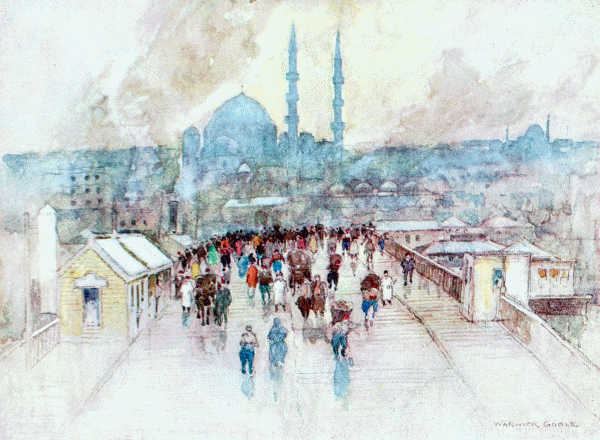
A WET DAY ON THE GALATA BRIDGE
The men in long, white pocketless coats stationed at either end of the bridge collect the toll levied on every man, beast, and vehicle using the bridge—professional beggars alone being exempt.
In the political situation, in the matter of education both among the Turks and the Christian populations, the changes are simply enormous. This is, however, not the place to expatiate upon these serious topics, although it is only by their consideration that the greatness and far-reaching consequences of the new state of things can be properly appreciated. But look at the change in the matter of dress. Where is now the variety of costume, where the brightness of colour that made the movement of the population at all times a procession in gala dress? So far as her garb is concerned, a Turkish woman to-day is a sere and198 withered leaf. She is almost a European lady, thinly disguised. And where are the men who moved about, crowned with turbans, and attired in long, coloured, flowing robes? You meet them occasionally on the street, or see them gathered about the mosques, weary and tattered stragglers of generations of men, whose mien and gait were the look and motion of princes. Some one has said that the Turks committed a great mistake when they adopted the European dress; for the change makes you suppose that they have ceased to be Orientals, and are to be judged by European standards in all respects. Too much is therefore expected of them. Certainly the change has not improved their appearance. It has robbed them of that quiet dignity and commanding air which imposed immediate respect. The eagle is shorn of his plumes.
The Turkish pasha, for instance, is now a shadow of his former self. What a master of men he looked when seated on a fine Arab horse and glittering saddle-cloth, he rode slowly through the streets, accompanied by a retinue of servants on foot, the crowd making way for him to pass as though a king went by. What an incarnation of dignity he was when he floated on the Bosporus 199in a caïque of five pairs of oars, two servants squatting in front of him, with folded hands, in the bottom of the boat; his pipe-bearer, behind on the poop, ready to present him with a long-stemmed pipe of cherry or jasmine wood, surmounted by an amber mouthpiece, adorned with diamonds. With the disappearance of such things, there has been a sensible weakening of the awe which the ruling race excited in the rest of the population. If any one wishes to experience the fall, so to speak, in the temperature of the feeling of awe produced by the change from an Oriental to a European garb let him visit the Museum of the Janissary Costumes. What terror those costumes must have inspired! Or let him visit the Imperial Treasury in the Seraglio, and walk down the line of lay-figures attired in the costumes worn by successive Sultans. The eye pays instant homage to every master of the Ottoman Empire clad in native apparel. But when the figure of Mahomet the Reformer, who swept away the janissaries and other old institutions, is seen dressed in European clothes (except for the red fez), one reads there the sign that the glory of the House of Othman was on the wane. The dread and majesty by which the Turk was formerly hedged round have vanished.200 Within the memory of men still living, eunuchs carried swords to chastise indiscreet admirers of Oriental beauties, and did not hesitate to slash a European guilty of casting long, lingering looks upon the fair faces. It was forbidden, within days that one recalls, to pass the imperial palace on horseback or with an umbrella opened. So strictly was the rule enforced, that even the “Great Elchi,” Sir Stratford Canning, riding by the palace, was once compelled to dismount from his horse. This proved too much for the great man. Furious at the indignity, he sent instantly for his dragoman, demanded an immediate audience of the Sultan, and obtained the order which put an end to the humiliating custom.
It is not, however, among the Turkish population alone that a marked change in dress has occurred. Within the memory of living persons, Armenian and Jewish women appeared in public wearing distinctive veils. Baggy trousers, head-kerchiefs, striking colours, embroidered jackets, turbans, were in vogue among the non-Moslem inhabitants, making the scenes in the streets kaleidoscopic, and furnishing also a ready means whereby to identify the nationalities that seemed inextricably mingled together. It is surprising how a resident 201of Constantinople can recognise the nationality of the peoples he meets, even since a common style of dress has come into fashion. But in days not very remote, every native wore his country upon his sleeve. His costume was the badge of his race and people. Now, the order of the day is “à la Franca.”
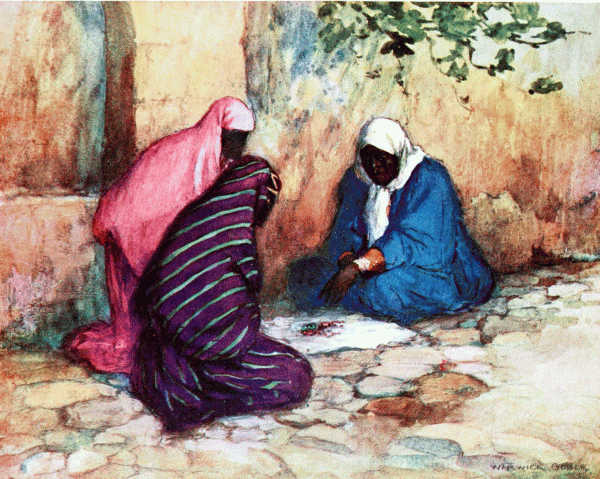
A FORTUNE-TELLER
In Stamboul, on the way to the Sublime Porte, an old negress may often be seen telling fortunes by means of coloured beads and shells.
Again, what a change has come over the style of building in the place. The palaces of the Sultan are on European models.
The day has vanished, when to go up or down the Bosporus was to move through a scene in which the charms of nature were heightened by the fascinating primitiveness and fancifulness of the Orient. The large old-fashioned Turkish house, almost nothing but stories of windows, painted deep red, or left to assume the natural grey of the wood, with broad eaves under which small attic windows, filled with little diamond-shaped panes of glass nestled, have disappeared, or are fast falling into decay. Venetian shutters are replacing the latticed screens, which invested a Turkish home with so much mystery; conservatories have taken the room of the old green-houses of orange-trees and lemon-trees. And, worst of all, boats of European form are supplanting the caïque, so light, so graceful,202 floating upon the water like a seabird, and making the Bosporus seem a stream in fairyland.
Nowhere, perhaps, is the mark of change more evident than in respect to the means of communication, whether in the city or on the straits. Long lines of tramways run from the Galata Bridge to the Golden Gate and the Gate of S. Romanus, from one end of Stamboul to the other. Along the railway that forms the highway to Europe, there are five stations within the city limits for the accommodation of the districts beside the track. The sedan chairs in which ladies were usually carried, in making calls, are now occasionally employed to convey them to and from evening parties. The groups of horses standing at convenient points in the great thoroughfares to carry you up a street of steps or to a distant quarter, with the surudji, switch in hand, running beside you to urge the animal onward and to take it back at the close of your ride, have given way to cabstands, and to a tunnel that pierces the hill of Galata. A tramway carries one through Galata and Pera as far out as the suburb of Chichli, while another line runs close to the shore from the Inner Bridge to Ortakeui. There are persons still living who remember the first steamer that plied on the Bosporus, in 203the forties of last century. Its main occupation was to tug ships up or down the straits; but once a day, in summer, it conveyed passengers between the city and the villages of Therapia and Buyukderé. A second steamer soon followed, and charged eleven piasters for the trip each way. Owing, however, to the opposition of the caïquedjis, the steamer could not moor at the quay, so that passengers were obliged to embark and disembark at both ends of the journey in caïques, at the rate of one piaster each way. Thus a return trip, which now costs one shilling and eight pence, involved an expense of four shillings and four pence.
No one, of course, undervalues the advantages of steam navigation, or suggests a return to sailing ships. At the same time it remains true, that never again will men see the Bosporus so beautiful as it looked in days when its waters were untroubled by steam. Owing to the prevalence of northerly winds in these regions, ships bound for the Black Sea were liable to long detention on their way up from the Mediterranean. Great fleets of merchantmen were accordingly apt to collect in the Dardanelles and in the Golden Horn, waiting for a favourable breeze. They had sometimes to wait six weeks ere they could stir. When at204 length the south wind did come, every stitch of canvas the ships could carry was unfurled, and an immense procession of winged sea-coursers and chariots rode through the Bosporus day after day so long as the south wind blew. In an hour, a hundred, two hundred, vessels might pass a given point, all panting to reach the open sea before the wind failed, and racing one another to get there first. Ships of all sizes and of every form, European and Oriental, sails and rigging of every style; huge three-masted merchantmen, “signiors and rich burghers on the flood,” schooners, brigs, barges, caïques, “petty traffickers,” with their white wings stretched over the blue waters, from one green bank across to the other, flew before the wind, and formed a spectacle solemn and stately as a royal or religious ceremonial. It was a magnificent scene of colour, motion, and variety of form; of eagerness and achievement.
When we think of the means of communication with the outer world, the change is extraordinary. For the voyage from England to Constantinople a sailing vessel took usually thirty to sixty days. It might be even three months, as an Englishman still living in the city found, in 1845, in his own case. To-day one travels by rail to London in three and205 a half days. Letters from England took ten days. There was a weekly European mail viâ Trieste, and three times a month viâ Marseilles. Now, a European mail arrives daily. The postage on a letter was 1s. 4d. where now it is 2½d. It is impossible to exaggerate the influence upon the life of the place due to this close connection by steamship and by rail with the Western world. The Ottoman authorities were not altogether mistaken, from their point of view, when they looked with disfavour upon the junction of the railroads in Turkey with the European railway system. That junction, it was thought, would facilitate the military invasion of the country. But ideas travel by rail, as well as soldiers. And the invasion of a country by new ideas may have consequences as formidable and far-reaching as any that arms can introduce. The completion of the railroad between Constantinople and Vienna in 1888 may be regarded as the conquest of the city by foreign thought and enterprise. Little, perhaps, did the crowds, that gathered at the Stamboul railway station on the 14th of August in that year to witness the arrival of the first train from the Austrian capital, appreciate the significance of that event. But it was the annexation of Con206stantinople to the Western world. New ideas, new fashions now rule, for better and for worse. And soon the defects and the charms of the old Oriental city will be a dream of the past.
Owing to the narrowness and steepness of the streets of Constantinople, the transportation of heavy loads through the city by means of wheeled vehicles has always been a difficult, and often an impossible, undertaking. Much has been done in recent years to widen and grade the chief thoroughfares. The authorities are even accused of having occasionally secured that improvement, by setting fire to the houses along an old narrow but picturesque lane in order to take advantage of the law, that when a house is rebuilt the municipality has the right to appropriate a part of the old site to broaden the public way, without giving compensation to the owner of the ground. Moreover, during the Russo-Turkish War of 1876-77, the Moslem refugees from Bulgaria introduced the use of a rough four-wheeled cart drawn by one horse, and that conveyance is now extensively employed. The old-fashioned, long, narrow, wagon drawn by a pair of oxen or buffaloes, so primitive that it might be a wagon which the Huns left behind in their march through the land, still crawls 207and creaks under a pile of the household furniture of a family removing from one house to another, or from town to country, or from country to town. But the means of transportation most characteristic of the place are the backs of animals and of men. To an extent seen nowhere else, at all events, in Europe, the streets are obstructed by long trains of donkeys and horses carrying planks, or stones, or lime, or bricks, to some building in course of erection, or hurrying back from it for fresh loads. It is, however, in the employment of human beings as beasts of burden that Constantinople excels.
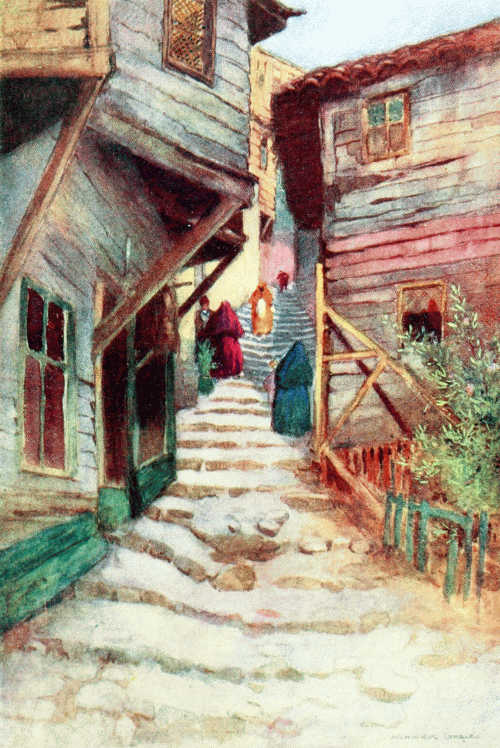
A STEP STREET
A typical street in the old Turkish quarter; the houses are built almost entirely of wood, brilliantly painted, and hardly two in the street are on the same level; the lattice work at the windows indicates the women’s quarters.
The traveller soon makes the acquaintance of these hamals, as they are called, upon his arrival, whether by sea or by land, and beholds with surprise that, while he drives to his destination in a cab and pair, his luggage is perched on the broad back of a fellowman, and proceeds thither, so to speak, on foot. And the surprise grows into wonder at the number of articles and the weight which can be put on that stooping figure. In the affairs of residents, hamals occupy an important place. No business at the Custom House can be done without their assistance. They carry the merchant’s goods to and fro. They bring your charcoal, your coal, your wood, your stoves, your piano, your chest208 of drawers, every heavy piece of your furniture. They chop your wood, and store it in your cellar. They will even carry a child in their arms up a hill or to a distant house, as tenderly as any nurse. Sometimes a poor sick man is taken on a hamal’s back to the hospital. To relieve the pressure of his loads, a hamal wears a thick pad on his back, suspended from the shoulders by straps through which he passes his arms, and curved upwards at the lower end to furnish a hollow in which his burden may lodge. Thus equipped, he stoops low, as a camel does, for friendly hands to load him; a cord, by which he may steady himself and keep what he carries in position, is then passed round his burden and given him to hold, and thereupon he rises slowly and moves off. When a street is unusually steep, it is customary to place, at convenient intervals, a series of large stones or small platforms, upon which a hamal may rest his load without removing it, and take breath for a few moments. To provide stones of rest for these burden-bearers is considered a pious act. When the load is too heavy for one man, it is slung upon a long ashen pole and given to a couple of hamals to carry, by placing the ends of the pole upon their shoulders. In the case of still heavier weights, 209four, six, or eight hamals perform the task in a similar way. The load is then attached to as many poles as are required; the men, ranged both in front and in the rear in an oblique line, put the ends of the poles on the left shoulder, and the right hand, where possible, upon the shoulder of the comrade to the right; and thus bound and locked together the band swings forward, shouting Varda. Many a person turns round to watch the fine stalwart figures bearing off their burden, like a trophy in a triumphal march.
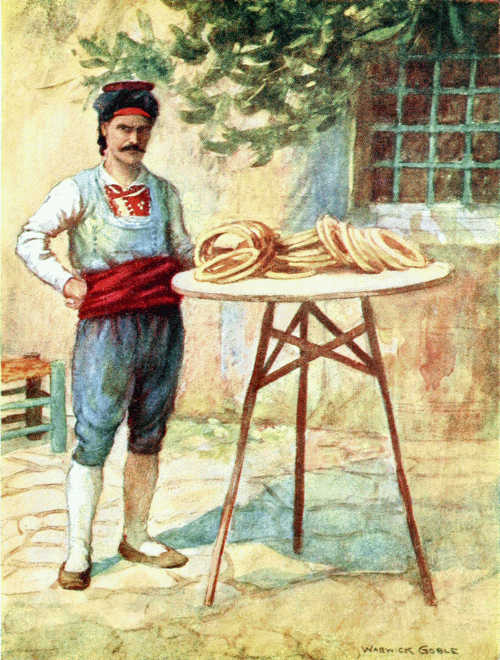
SIMIT-SELLER
When moving about he carries on his head his tray, balanced on the red pad resting on his turban.
The hamals are not natives of the city, but come from various districts of Asia Minor. They form part of that numerous body of men in Constantinople who have left their homes and families in the interior of the country to find work in the capital for a term of years, in order to support their parents, or their wives and children. It is a practice due to the scarcity of work in the interior, and a considerable portion of the money thus earned is sent home to pay the taxes for which the relatives there are a security. At intervals of five, or even ten years, these men make a long visit to their homes, and then return to their work, until they become too old for it, or have earned enough upon which to retire. They generally own210 a cottage and a field, property sufficient to afford the family the bare means of existence, and to furnish a convenient retreat at last for the weary bread-winner at his final home-coming. An ignorant, stubborn lot of men they may be, but their simple lives, their hard labour, and the frequency and fidelity with which they serve you, give them a place among the kind memories of a resident in Constantinople.
A company of hamals, generally natives of the same district or village, acquire the monopoly of carrying loads in a particular quarter or suburb of the town. One of their number acts as their chief, and it is through him that arrangements with them for work are made. All earnings are put into a common fund, and divided fairly between the members of the society. The various companies of hamals are as jealous of their claims upon a particular locality as are the dogs of the quarter. They may carry a load in a district not their own, only if the load is taken up first in their own quarter. Any attempt to commence work in another company’s territory results in a fierce fight between the parties concerned, and exposes the articles in dispute to serious damage. The Moslem hamals are very attentive to their religious duties.211 It is often impossible to get them to attend to your wants at the hours of prayer.
At one time, by far the larger number of hamals employed in the city were Armenians. Those of them who were attached to merchants’ offices, as caretakers and confidential messengers, were renowned for their fidelity and honesty. Any sum of money could be entrusted to their keeping with absolute safety. Since the massacres of 1896, when this class of the Armenian population was the object of special attack, and was almost exterminated, the hamals of the city are chiefly Kurds. It took some time for the newcomers to learn their duties, and merchants were seriously inconvenienced by the consequent accumulation of their goods at the Custom House, and the slowness of delivery. But, to all complaints on the subject, the authorities, as though the injured parties, returned the characteristic reply, “Why do you bring so many goods?” Armenian hamals used to have one great holiday in the year—Easter Monday—which they spent in dancing together, in their best garb, on a great mound of rubbish beside the military parade ground at Taxim. On their return, through the Grand Rue of Pera, “it was not uncommon to see a band of them,212 carrying their long, massive poles, heaving with every appearance of intense strain and fatigue; the burden hung in the centre—an egg!” With the growth of a higher sense of human dignity this species of a beast of burden will become extinct.
To omit all reference to the dogs of a city which has been styled a “dog-kennel” is impossible, however well worn the theme may be. They are one of the prominent features in the street-scenery of the city, and attract the attention of all travellers. Along with other “improvements” their number has been greatly diminished during recent years, but they are still in evidence in every thoroughfare of the place. Tawny in colour, with a furry coat, bushy tail, and pointed ears, they betray their relationship to the wolf and the fox, although the hardships of their lot, and still more the indulgence with which they are treated by a large part of the population, have taken almost all their ferocity out of them, except in their treatment of one another. They are the assistant-scavengers of the city, eating the pieces of food found in the rubbish, which, after an old custom not yet obsolete, is still too often dumped into the street by the inhabitants at night, for the official scavenger to remove in the morning. 213To some extent they act also as watchmen, making night hideous with their barking.
For these purposes they divide the city between them; so that the different quarters of Constantinople are respectively the special domains of different companies of dogs, who guard their boundaries as jealously and fiercely as any frontiers between rival nations. No sooner does a strange dog enter a canine ward than his arrival is signalled by a peculiar bark from a faithful defender of the rights of the invaded district. The bark is echoed from member to member of the injured community, until the whole pack is roused, and rushes upon the intruder like a horde of savages, biting and worrying him beyond the bounds he transgressed in an evil hour. Hence it is extremely difficult to take your own dog out for a walk in the streets of the city. A deafening uproar greets you from every community of dogs through which your road passes. You must hold your companion in leash; you must be on the alert, whip or cane in hand, to strike at the infuriated beasts that spring with flashing teeth at him from all directions; and if you are fortunate enough to get your dog safely through the fight, it will probably be owing to the courtesy of some sympathetic onlookers who214 came to the rescue in your extremity. When such an encounter occurs on an open road with wilder dogs, the scene may prove a battle royal. In that case the most effective way of driving your assailants off is to throw stones at them, of which they are more afraid than of any stick in your hand. Sometimes even the gesture of stooping to pick up a stone will suffice to put the enemy to flight, yelping with imaginary pain. In view of this state of things among the dogs of the city, a Turk, wishing to say that a certain person is not of his “sort,” puts the case in the clearest and most scathing light by the simple remark, “He is not a dog of my quarter.”
The dogs are treated very kindly by the Moslem population. Large companies of them encamp near barracks and guard-houses, certain to find friends among the soldiers, and to share their rations. They will gather about the shop of a baker or of a butcher, or wander like beggars from one such place of entertainment to another in their district, sure they will not be left to starve. There is a racy Turkish proverb based upon this habit of dogs to sit in a row before a butcher’s shop, expecting scraps of meat. It is pointed against idlers who are waiting for something to turn up, and runs to the following effect, “If looking on were enough 215to get on, dogs would become butchers.” It is not rare to see Turks purchasing a loaf and distributing it among a company of dogs. Sometimes a dog will take his stand near a baker’s shop, and at your approach will place himself at your feet, and with beseeching eyes appeal to your generosity to buy him some bread, wagging his tail in gratitude for the anticipated favour. There are dogs who come to an understanding with a family of their acquaintance as to the most convenient time to call for food, and who, at the appointed hour, tap at the door of their host’s house for the promised meal. It is common to see at the door of a Turkish house an earthen jar, or an old petroleum can, half sunk in the ground, and kept filled with water for the dogs; and there is a low drinking-trough, for the benefit of the poor creatures, at many of the public fountains in the city. Frequently also, one sees a bed of straw provided for the comfort of a mother dog and her litter of puppies.
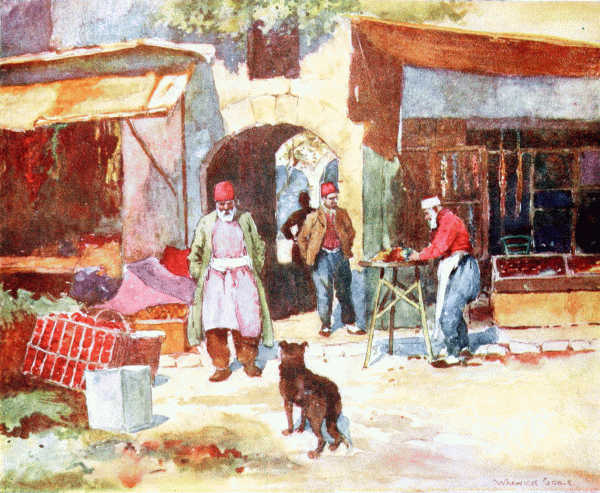
ENTRANCE TO A TURKISH KHAN
The Khans formerly used by travelling merchants with their laden camels are now almost entirely used for offices and warehouses.
The idea of killing a dog is shocking to a Turk’s mind. In his opinion, it is sinful to do so. At one time, a dog in the village of Roumeli Hissar upon the Bosporus became exceedingly dangerous. Not content with keeping stray members of his216 own race off his ground, he snarled and showed his teeth at every decent person who crossed his path, until at length a European resident, losing patience, drew a pistol and fired upon the obnoxious animal. The shot missed, but the gentleman who had fired it was guilty of a double offence. He had broken the law forbidding the carrying of firearms, and he had attempted the life of a dog. The culprit was instantly surrounded by a fierce mob, arrested by the police, and taken to the village prison. As strong influence could be secured for his protection, his case was easily settled. But the question how to deal with the dog was a more difficult matter to arrange. Neither arguments nor backsish could persuade the police to kill the dog. The utmost the guardians of the public safety would do was to transport him to the opposite side of the Bosporus, and consign him to the tender mercies of the inhabitants of that shore; and this would be done, only if the aggrieved party would defray the expense involved in executing the decree of banishment. A change of domicile from Europe to Asia, or from Asia to Europe, is the most usual remedy applied, when dogs show bad temper or become too numerous for the happiness of a particular locality. It is a remedy, however, that provokes a policy of retalia217tion, and induces a return of the evil in some analogous form.
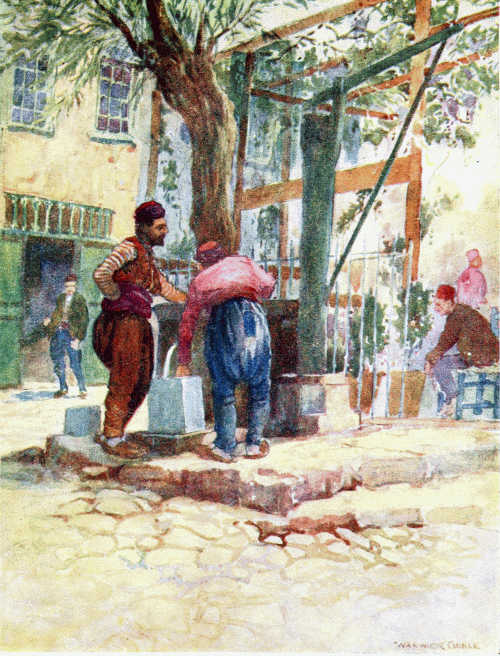
TURKISH WELL, STAMBOUL
The water supply is obtained by means of the primitive pump at the side of the stone tank; the rod attached to the crossbeam is pulled downwards to work the pump.
Notwithstanding all this kindness, dogs are held in great contempt. They do look a disreputable lot. There are not many grosser insults in Turkey than to call a man “a dog” (kiopek), or to dismiss him with the ejaculation, “ousht,” the term employed in driving a dog away.
Among the objects which attract attention, as one moves through the streets, are the public fountains scattered over the city. They are found everywhere, and are often remarkable for their architectural beauty. Their number is explained by the fact that the old system of water-supply did not bring water into the houses, but only to the different quarters of the city, thus making it necessary to have, at convenient points, outlets from which the inhabitants could obtain water, either by coming to draw it for themselves, or by engaging the services of water-carriers. However inconvenient this arrangement may seem, it was always a pleasing sight to see groups of women and children gathered towards evening about the fountain (Tchesmè) of their district to fill graceful, bright-coloured pitchers at the gushing faucets, and then to wend homewards. It took one far back218 in the ways of the world, and was a bit of the country in the town. Nor are the faithful water-carriers (sakka) forgotten, who brought water in great leathern vessels, shaped like a blunderbuss, hung horizontally by a strap from the left shoulder, and who poured the contents into a large earthenware vessel within your house. The aqueducts of Valens, Justinian, and other Byzantine Emperors, as well as the Basilica Cistern (Yeri Batan Serai) still act their part in furnishing the city with water. Until recently, the only other source of water-supply was either rain-water led from the roof into a cistern built under the house, or water brought in barrels from springs in the surrounding country. The introduction of water from the Lake of Derkos, which lies close to the Black Sea, to the west of the Bosporus, has been a great boon to the city, but it is not in favour for drinking purposes.
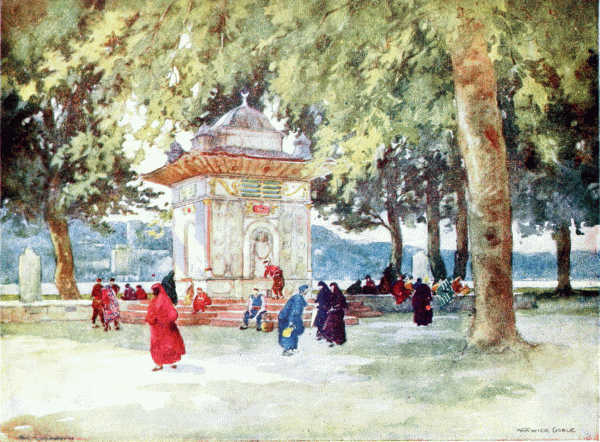
A FOUNTAIN BY THE BOSPORUS
In this form of fountain the tank is enclosed within four marble walls and roofed over.
The most interesting fountains are those known as Sebil, generally pious foundations, and next to the mosques and turbehs, the best specimens of Oriental Art in the city. The finest example of this form of fountain is the well-known Fountain of Sultan Achmed III. (1703-1730), which stands to the east of S. Sophia, near the 219Grand Entrance to the Seraglio, and which was designed by that Sultan himself. The fountains are polygonal chambers; with broad, brightly-painted, wooden eaves; with sides of gilded open iron work, or of marble slabs, over which carved flowers and fruits are spread in profusion; and, often, surmounted by fantastic little domes. Within, is found a tank from which a man keeps full of water a number of metal cups, attached by chains to the iron work, but accessible, through the openings in it, to every thirsty wayfarer, without money and without price. The living, personal, human element in this mode of distributing water is as impressive as the fairy form of the monument. Furthermore, water-carriers, paid from the funds which endow a fountain, go about the streets to give “the water of life” freely to any person who asks for it.
To erect a public fountain is a very usual form of public benefaction among Moslems, and is regarded as highly meritorious. It is common to find, in the garden wall of Turkish mansions along the Bosporus, a fountain opening on the side of the quay for the relief of any passer-by, and especially of boatmen, who come on shore to tow their craft against the current. To repair a fountain is also a work of merit; an idea that, on one220 occasion, gave rise to a curious incident. The fountain in a certain Turkish district, although very much the worse for use, was for some reason left neglected by the community. Whereupon a Christian neighbour proposed to put the fountain in order at his own expense. The offer was welcome, but it raised a difficult question. Would the original Moslem builder of the fountain not lose the merit of having constructed it, if his work were restored by a Christian? Would the Moslem community in the district not lose merit, for allowing the fountain to be repaired by an alien in creed? And so the matter was laid aside for consideration. At last it was settled to the satisfaction of all parties on the following understanding. The Christian might be allowed to execute the necessary repairs, if he renounced any merit for doing so, and agreed that all the merit of the good deed should belong to the original Moslem builder of the fountain. To this way out of the difficulty, the Christian had no objection, and, after signing a legal document to that effect, he was permitted to carry out his kind intention.
Turks are extremely particular in regard to the quality of the water they drink, and are willing to be at much trouble and expense to obtain water221 of the kind they prefer. To be a perfect beverage, water must issue from a rock, fall from a height, be of medium temperature, flow rapidly and copiously, taste sweet, spring in high and lonely around, and run from south to north, or from east to west. The excellence of any water is accordingly determined by the number of these conditions it fulfils. It is remarkable how much pleasure Turks find in visiting a famous spring in the country, to spend the whole day beside it, under the shade of trees, doing little else but drink carafe after carafe of the water, as the elixir of life. Resorts of this description abound on the shores and in the valleys of the Upper Bosporus, under such names as “The Water of Life,” “The Silver Water,” “The Water under the Chestnut Trees,” “The Water beside the Hazels.” The spectacle of the great gatherings there, on Fridays, arrayed in bright colours, seated tier above tier on the terraced platforms built against the green slope of a hill, the women above, the men below, all in the deep shade of branches meeting overhead, forms a picture beyond a painter’s power to reproduce.
In this connection may be mentioned also the attractive little scenes upon which one comes frequently in walking through the city—quiet222 nooks, a little off the great thoroughfares, with a vine or westeria spread on a trellis across the street for an awning, and a group of humble workmen, seated on low stools at the door of a cafeneh, sipping tiny cups of coffee, drinking water, smoking the narghileh, too happy to speak much. Occasionally, the court of a small khan, or a portion of a large court, is thus canopied by a trellised vine, making an oasis in the desert of lowly toil.
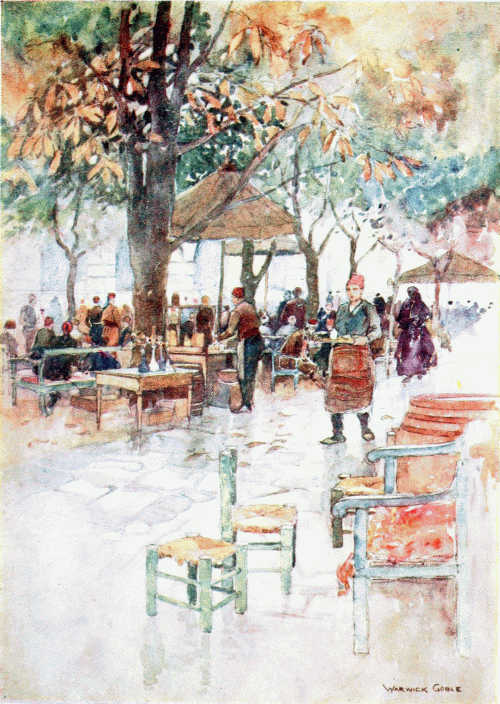
OPEN-AIR CAFÉ, STAMBOUL
Smoking the narghileh and drinking coffee occupy a large part of the Turk’s time.
CHAPTER XI
religious colouring
Another striking feature in the life of Constantinople is the extent to which life here has a religious colouring. The Turkish State is a theocracy. Its supreme law is a code reputed to be Divine. Citizenship is secured by the profession of a particular religion. Obedience to the law of the land is obedience to the will of God. The defence of the State is the defence of a faith. Patriotism is piety. To die in battle is to belong to the noble army of martyrs. The cemetery on the hill above Roumeli Hissar is known as “The Field of the Witnesses” (Martyrs), because the resting-place of soldiers who died while Mehemet the Conqueror was building, in 1452, the castle which should command the passage of the straits, and cut the communications of the city with the lands around the Black Sea during the forth224coming siege, “when the bud would open into flower.” The picturesque cemetery, shaded by oaks, on the hill above the Genoese Castle, overlooking the entrance to the Black Sea, a view that Darius I. and Herodotus came to admire, is also named “The Field of Witnesses,” because there, it is supposed, Saracen soldiers who fell in an attack upon the castle were buried. Such cemeteries are holy ground, and sepulture in them is regarded as a great honour. The attendance of the Sultan at the midday public prayers on Fridays is the official act of the Caliph of the Mohammedan world. He ascends the throne after girding his sword at the grave of the first standard-bearer of the Prophet, in the Mosque of Eyoub. The mantle of the Prophet, his green standard, his staff, sword, bow, are enshrined in the Seraglio as the sovereign’s regalia, and are annually visited by the Sultan as a great State function. Around that standard all true Moslems must rally when Islam is in peril. No great act of Government may be performed until the chief doctor of the Sacred Law, the Sheik-ul-Islam, has been consulted, and sanctions the act, as in accordance with the supreme authority of faith and righteousness. Sultan Abdul Azis and his nephew, Sultan Murad, 225were deposed only after such sanction had been obtained.
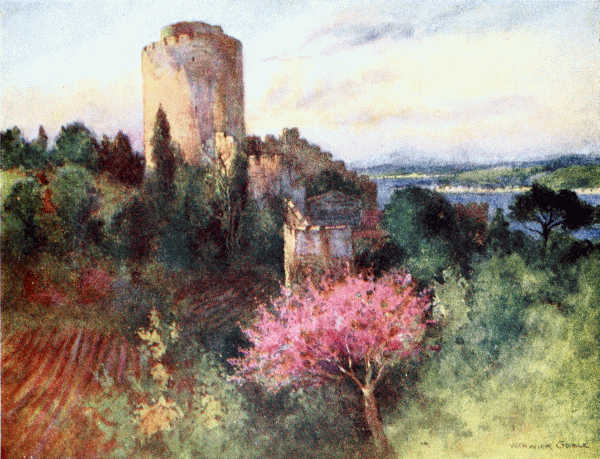
ROUMELI HISSAR
One of the towers of the old Turkish castle built by Mehemet II. (“The Conqueror”). The distant hills seen across the Bosporus are on the Asiatic coast. The Judas tree in full bloom is a prominent feature in the spring.
Upon this theocratic conception of the State, the exclusion of the Christian subjects of the Empire from the army is based. For, how can aliens in religion be enlisted under the banner of the Faith? Hence the institution of the janissaries in the early history of the Ottoman Power, whereby children of Christian parentage were taken from their homes and brought up as Moslems, to furnish recruits for the army. It was an ingenious device to maintain the religious character of the military force of the Empire, and yet to prevent the burden of filling the ranks from resting exclusively upon the faithful. The abolition of the child-tax, however fortunate to others, proved a great injury to Turkey. It not only deprived the Sultans of their finest troops, but has been one of the principal causes of the great decrease in the Moslem population of the country; as that class of the community alone has since been called to sustain the losses involved in military service. The mortality among the soldiers of the Turkish army from disease and war is so great that the Moslem population is rapidly dying out, and well-informed medical experts are heard to say, “The Eastern Question will226 be solved by the disappearance of the Turks in the natural course of things.”
The theocratic character of a Moslem State facilitates, indeed, the incorporation of different races in the same social and political system, seeing that all distinctions between men are obliterated by community in the faith of Islam. And it is impressive to see how closely the Mohammedan world, though not free from sects, is knit together by religious principle, and how strongly it cherishes the brotherhood of believers. In it, not in theory only but also in practice, the black man and the white man are fellow-citizens and of the same household. But on the other hand, because of its theocratic constitution, it is impossible for a Moslem State to accept reforms which seek to secure equality of rights among its subjects, on the ground of a common humanity. Nothing is more opposed to the deepest convictions of a genuine Moslem than the idea that men of a different faith from his own can be his equals. There is no one who can be more polite than a Turk; no one who can treat you in a more friendly and flattering manner than he. Yet persons who have known him well, nay, who have loved him, testify that even in the relation of private friendship they have227 never felt that a Turk had given them his whole self, but was a friend with reservations that might lead him to act toward you in the most unfriendly manner. His religion confers on him an inaccessible superiority, from which he cannot descend without becoming a faithless son of Islam. His interests are superior to those of an infidel. He is a religious aristocrat, and no patrician of old or of modern days has resisted the demands of plebeians or commoners for equality more obstinately or strenuously than a Moslem opposes the pretensions of unbelievers to be placed on a parity with him. In the case of the patrician, it was a matter of pride; with the Moslem, it is a case of conscience. Though it may seem a small matter, it is a significant fact that a Turk can wish the salutation of peace only to a fellow-Moslem, and that in the exchange of courtesies with persons not of his faith he expects to be saluted first. Rather than admit equality in any real and absolute sense, it would seem as if the wreck of the Empire were preferred—“faithful unto death.”
The outward forms of Mohammedanism are exceedingly impressive. The muezzin’s call to prayer—at dawn, at noon, in the afternoon, at sunset, and three hours later at night—floats through the air228 like a voice from the upper world. No music of bells evokes such a sense of the Divine Majesty as his proclamation, “God is Great, there is no God but God.” However grand or however humble a mosque may be, whether frequented by the most intelligent or the most ignorant of the people, it contains nothing that tells of superstition, nothing that belittles or lowers the conception of the Most High. One can understand why, when Islam and Christianity confronted each other in the Byzantine Empire, there were emperors who, for upwards of a century, strove to banish pictures and statues from the worship of the Church. And where is the reverence of the human soul before God expressed so utterly, as when the Moslem worshipper, washed clean, with shoes off his feet, stands, bows, kneels, prostrates himself before his Maker, in silent prayer? There is no more impressive religious service in the world than that celebrated, under the dome of S. Sophia, on “The Night of Power,” in the season of Ramazan. Under the dim light of hundreds of small, hanging lamps, fed with oil, as in days past, ten thousand men are then gathered upon the floor of the mosque for evening worship, their hearts stirred by the associations of the sacred season. It is essentially a service of silent prayer. 229The silence is made only the more impressive by the brief chant or vehement ejaculation that occasionally breaks the stillness, to afford pent feelings some relief. But though dumb with awe, the multitude cannot rest. The emotion is too strong for complete suppression, and the vast congregation heaves to and fro, rises and falls. It stands upon its feet, bends low, sinks to the floor, kneels, prostrates the head to the very earth, filling the great church with a sound as of distant thunder, or the sea breaking upon the shore. It is a scene of intense humility and veneration. And yet it is so grave, so quiet, so controlled, that the dignity of the worshippers is never lost. It is the homage of the great to the Greatest. It is a remarkable combination of reverence and of self-respect. Except in the practices of certain orders of dervishes, the Howling Dervishes for instance, nothing in the attitude of a Moslem at his devotions betrays an overpowering feeling due to the weakness of human nature. The consciousness of belonging to the élite of the religious world, the sense that the worship is paid to the One, True, Great Allah, beside whom there is no other God, and that it is offered in a form worthy of the Divine nature, inspire an elevation of soul like the pride of great230 nobles in the presence of a mighty over-lord. A devout Moslem is an aristocrat to the tips of his fingers.
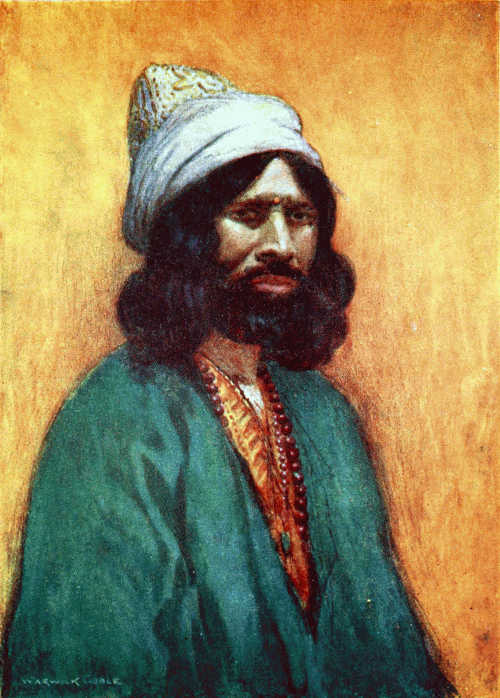
A HOWLING DERVISH (“LA ILÂH ILLA ’LLAH”)
The howling dervishes perform their devotions by standing in a row and repeating the confession of faith, “La ilâh illa ’llah,” rocking themselves backwards and forwards meantime; beginning slowly, they gradually quicken the time and work themselves into a frenzy of religious excitement.
Partly because of the natural reserve of Moslems in speaking with Christians on religious matters, and partly on account of the influence of the social institutions, which Moslems have inherited from an inferior stage of civilisation, it is exceedingly difficult to determine the ethical power of Islam in the inner life of its adherents. Perhaps the following remark, made by an intelligent Mohammedan to a Christian friend, gives a glimpse into the spirit of the system. “Christianity is perhaps the best religion, but it is too high for frail human beings. Therefore God, in His mercy, has given us another religion, Islam, which, if not so lofty as yours, is more easy of attainment and practice.” Certainly, the distinction of Islam is the force with which it insists upon the unity, spirituality, and greatness of God. A dogma, not a moral ideal, is its chief concern. Nevertheless, although the system does not develop the loftiest character, it does secure a demeanour that commands respect. The submission to the Divine will, which it inculcates, may have its defects; but it has likewise its merits. If it saps energy, it fosters seriousness, calmness of spirit amid 231life’s vicissitudes, and a dignified acceptance of the inevitable. If Islam fails to inculcate disinterested virtue, or to inspire goodness on a grand scale, it urges the performance of many beautiful deeds of kindness.
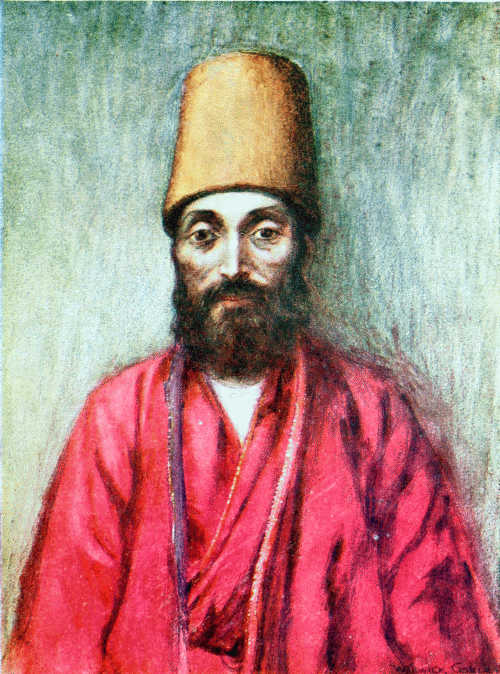
WHIRLING DERVISH
Member of a religious order whose particular act of devotion consists in whirling round on the toes until completely exhausted, the object being to produce a trance-like condition, during which the mind is entirely withdrawn from material surroundings.
Almsgiving is one of the great duties incumbent upon a Moslem. During Ramazan and the two festival seasons of Bairam, tables are set in the houses of the wealthy classes, to which poor neighbours are made welcome. Groups of beggars gather then about the houses of the rich to receive liberal portions of pilaf, and meat stewed with vegetables, besides a present of money or some article of dress. Connected with the principal mosques of the city, there are endowed soup-kitchens (Imarets), at which, along with the softas and imaums of the mosque, the poor of the district can obtain soup every morning, and once a week pilaf and zerdé (sweetened rice, coloured yellow with saffron). During Ramazan, pilaf and zerdé are supplied every evening. The lame, the blind, the halt, are usually allowed to cross the bridges over the Golden Horn without paying toll, and to travel by the steamers on the Bosporus free of charge. The regard of Turks for animals is well known. If, again, the legal and ascetic prohibition of the use232 of intoxicants by Mahomet is not the noblest method of educating free agents in self-control, the sober habits of a Moslem community and the rarity of violent crimes in it, when uncontaminated by foreign influence, are advantages not to be despised. A distinctive feature of a Turkish quarter in town or village is the absence of a wine-shop. On the other hand, the segregation of the sexes, while it diminishes the “social evil,” fosters a sensual tone of thought and feeling in Mohammedan society, that contrast most unfavourably with the chivalrous sentiments entertained towards womanhood in Western civilisation. The martial spirit congenial to Islam has its admirable side, but, by the unfortunate sanction of the use of the sword for the suppression of unbelievers, unspeakable atrocities have been committed under the mantle of religion; as, indeed, wherever a similar sanction has been allowed. Opinions differ as to the lengths to which this spirit would go, if Turkish Power were, under certain circumstances, driven to despair and brought to bay. Will the part of Samson Agonistes be repeated then?—“The edifice, where all were met to see him, upon their heads and on his own he pulled.” There are some who think so. But much may be said in favour of the contrary opinion.233 The Turk is a brave man, but he can be cowed by superior strength, firmly applied. A Turkish maxim says: “The hand you cannot cut, kiss, and press to your forehead.” This is not like Samson.
It is not, however, only the Turkish community that presents a religious colour. The same is true of the other communities of the country. With them, also, the nation has come to be the Church. This is due, in part, to circumstances anterior to the Turkish Conquest. The theological disputes between Christians in the earlier centuries of the history of the Church, even if purely religious and philosophical at first, erelong assumed a national character, and became respectively the banners around which racial distinctions and political antagonisms rallied, and acquired a consistence which endures to this day. How deeply ingrained in the Christian population of the country, to-day, is the spirit to see things under a religious colour appears, sometimes, in small but significant ways. A poor Greek woman, anxious to find a husband for her daughter, who was neither young nor beautiful, was informed that a worthy boatman was prepared to marry the girl. He had everything to recommend him, but he was an Armenian. “What!” exclaimed the mother, turning indignantly234 to the friend who recommended the man; “What! do you wish me to give my daughter to an Arian? No; let her rather die.” Evidently the woman was not an expert in the use of theological terms, for the Armenians are not Arians. But her reply shows that old theological disputes, which one might suppose had been forgotten, have left their impress upon the popular mind, and are associated with national distinctions. The division between Eastern and Western Christendom is not merely a religious schism. The organisations known as the Coptic Church, the Nestorian Church, the Armenian Church, are not simply different ecclesiastical denominations, or various schools of thought. They are as much, if not more, the assertion of national peculiarities. They have maintained, so far as the times allowed, a people’s independence; preserved the ties which bound a people to its past; and continued the use of its ancestral speech at home, in the affairs of social life, and in the worship of God. With the Turkish Conquest, this fusion of national and religious sentiments became, if possible, more complete. The new rule, involving the loss of political freedom, and the ascendency of an alien faith, made the Church dearer, and left her to be the only sphere of anything approaching national235 life and independence. The distinction between Church and Nationality consequently passed out of sight. And nowhere is the idea that to change one’s religious profession is to be false to one’s people, and that to be a faithful churchman is to be a patriot, more strongly entrenched than among the adherents of the Christian communities in Turkey. On the other hand, the new rulers could not hope, and did not desire, to assimilate the Christian populations of the country, or to incorporate them in one political body. What with the differences of race, creed, language, civilisation, a gulf was fixed between the conquerors and the conquered. The two parties could be nothing else but distinct and alien communities. Under these circumstances, policy and necessity led the conquerors to maintain the different organisations in which they found the subjugated peoples already arranged. To divide and conquer may not be the highest statesmanship, but it was a principle that, in the condition of the country, could be quickly applied. For one thing, by that process the power of the conquered to rise would be crushed. Furthermore, to leave the different churches of the land to their own ways was, after all, the only solution of the problem how to govern people236 who, because of their religious beliefs, and their social institutions, could not be brought under the operation of the Sacred Code of Islam. It would, so far, please the conquered. It would accord with that regard for use and wont, for what he calls Adet, which the Turk cherishes. It was practical, and in harmony with the theocratic conception of society familiar to the Moslem mind. Hence the Turkish Government has been accustomed to classify the various peoples of the Empire according to their respective creeds, and has granted them a considerable measure of self-government, in such matters as marriage, inheritance, education, the management of charitable institutions, and jurisdiction over the clergy. As these bodies were ecclesiastical corporations, their ecclesiastical chiefs became at once their rulers, both in religious and in civil affairs, and their representatives in all transactions with the Ottoman authorities. In fact, these communities have enjoyed privileges that give them, in some respects, a status similar to that conferred upon foreigners by the Capitulations. On the principle of religious classification, Greeks, Roumanians, Bulgarians, Servians, were considered members of the same civil community, because members of the same Church.237 And, on the same principle, if an Armenian left his National Church to join the Roman Catholic or the Protestant communion, he passed beyond the authority of his former ecclesiastical superiors not only in matters spiritual but also in matters secular, acquiring with his new beliefs a new legal standing, as a “Latin” or an “Evangelical.” In this new character, he came under the protection of another chief, was placed under new regulations, and made amenable to a different court. It is because of this intimate union of the religious and the civil, that converts from the National Churches in the Empire have been compelled to form themselves into distinct civil communities, and to incur the odium of, apparently, deserting their own people. But only thus could they escape the pains which their original ecclesiastical authorities had the power to inflict upon dissident subjects; only thus could the Turkish Government grant the converts a legal independent status in religious life.
This method of dealing with the Christian subjects of the Empire worked, on the whole, smoothly, until the idea of nationality, which has been such a powerful factor in the recent history of Europe, spread also among the various peoples of Turkey, inspiring them to assert their distinct238ness from one another, and to seek liberation from the rule of the dominant race. Then great searching of hearts arose. For the new idea was subversive of a system based upon the principle that the fundamental bond of unity between men is community of faith. Hence, when the Bulgarians demanded to be organised into a community distinct from the Greek community, though one in doctrine with it, and to have bishops and an ecclesiastical head of their own nationality, the request proved a source of considerable difficulty. The chiefs of the Greek Church, under whose authority the Bulgarians had been placed since 1767, as fellow-believers, naturally opposed the demand, taking ground upon the principle that, “In Jesus Christ there is neither Greek nor Jew, circumcision nor uncircumcision, Barbarian, Scythian, bond nor free”; a principle which Moslems could appreciate. Turkish statesmen opposed the demand as unconstitutional, and contrary to custom; at the same time, suspecting it to be a step towards ultimate political independence.
Under these circumstances various expedients were suggested, whereby the desired result might be secured in harmony with the law of the land. 239By some of their friends, the Bulgarians were advised to separate from the Greek Church on some unimportant point of doctrine or ritual, and so acquire the right before Turkish law to form a distinct community. Another proposal was to declare themselves Protestants, and thus not only escape from the jurisdiction of the Patriarch of Constantinople, but gain the support of Protestant nations. Yet another plan was to join the Roman Catholic Church, with the advantage of receiving the protection of France. The movement in favour of the last course went so far that a Bulgarian priest was consecrated a Roman Catholic bishop; but the scheme was abruptly terminated by the spiriting away of that personage to Odessa, with all the paraphernalia of his office. Eventually, under Russian pressure, the demand was granted, and the Bulgarians became a distinct civil and religious community on the ground of difference of nationality. They were, however, a religious corporation before the eye of the law, and in view of the large Bulgarian population still under Turkish rule, especially in Macedonia, the Exarch of the Bulgarian Church must reside in Constantinople to have his authority over that class of the community recognised by the240 Turkish Government. As though to add more religious colour to the arrangement, the Patriarch of Constantinople, in 1872, laid the Bulgarian Church under the sentence of excommunication as schismatic.
The form in which the Bulgarian question was settled has furnished a precedent which other nationalities, in furtherance of their political aims, have not been slow to appeal to, and which the Turkish Government, with the object of weakening their Christian subjects by sub-divisions, has been, of late, disposed to follow. In the province of Macedonia the system is carried out to perfection. There Bulgarians, Greeks, Servians, and Kutzo-Wlachs, all adherents of the Greek Orthodox Church, have had the fires of their national rivalries fanned into fiercer flame by being organised into different religious communities, under different ecclesiastical superiors, with the result that a situation exists in that province than which nothing more complicated can be imagined.
Before leaving the subject, it is only just to remark that, perhaps, the world has not sufficiently admired the tenacity with which the various Christian peoples of the Near East have adhered to their faith and nationality, in the face of hardships241 and temptations to which some of their members succumbed. If their life has been stagnant, it is not altogether their fault. Their circumstances have been exceedingly adverse to growth. But they have kept the treasure, although the vessel which has contained it may be earthen. However much the identification, or confusion, of political and religious issues has wrought mischief among these peoples, however much it has quenched their spirit of brotherly love, it is to their churches that they are mainly indebted for the preservation of their national consciousness and aspirations. Amid the darkness, the churches kept the lamp of hope ever burning. They consecrated patriotism by associating it with loyalty to God. They made faith firmer by uniting it with the love of fatherland. And their peoples have lived to see the light of a new day. There is something pathetic in the fact that all this was rendered possible by the degree of self-government in civil and religious matters granted them by their conqueror. There is something tragic in seeing the policy which a conqueror adopted as the only method to establish his rule—nurse the life of his foes, and forge the instruments of his ruin. But men are not always masters of their fate.
CHAPTER XII
turkish women
In the appearance and lot of Turkish women we see, perhaps, more distinctly than in any other feature of life in Constantinople the perpetuation of the ideas and usages which give to Turkish society its peculiar character and physiognomy. The assertion is often made that, according to the Moslem creed, woman has no soul. This is a mistake. While man, indeed, is considered to be woman’s superior on the ground of his higher natural endowments and of his services as bread-winner, the Koran, at the same time, recognises her spiritual nature and religious capacity. “Verily,” says that authority, “the resigned men and the resigned women, the believing men and the believing women, the devout men and the devout women, the truthful men and the truthful women, the patient men and the patient women, the humble243 men and the humble women, the charitable men and the charitable women, the fasting men and the fasting women, the chaste men and the chaste women, and the men and women who oft remember God, for them hath God prepared forgiveness and a mighty recompense.” Although the female companionship which forms one of the delights of the Mohammedan Paradise will be furnished by the houris, still earth-born women are also present in the abodes of bliss. Hence a Turkish mother, mourning the loss of her little girl, can find comfort in putting over the child’s grave this epitaph:—“The bird of my heart has flown from its cage to find a place in the gardens of Paradise.” If Moslem women do not attend public worship in the mosques, the reason is not any spiritual disqualification, but the idea that the sexes should associate as little as possible. Yet elderly women may be seen at their devotions in a mosque out of the hours of public worship, while during the religious season of Ramazan special services for women are held in some of the great mosques of the city, as well as in the imperial harem and in the harems of wealthy personages, such services being conducted by popular preachers. But after all is said that can be said to prove that honour244able views concerning woman are cherished in a society constituted by Moslem thought, it remains true that the fundamental conception underlying the organisation of that society and forming its dominant spirit is of an opposite character. That conception, we should in justice remember, is not peculiar to Islam. On the contrary, it has prevailed outside the Mohammedan world; it has contaminated even the life of Christendom. Nevertheless, the view that man and woman are not equals, that the latter is chiefly made to minister to the pleasure of the former, and that they are morally dangerous to each other, has nowhere been applied so consistently, on so large a scale, and for so long a period in the very presence of a higher civilisation, as in Moslem society. Such a view demands naturally and necessarily that men and women should be kept apart as much as the conditions of human existence permit. Where polygamy, concubinage, and easy divorce are lawful social arrangements, woman must be put behind the shelter of a jealous protection. She must be placed out of sight, secluded, guarded, and, when she appears in public, veiled and forbidden to display her ornaments. Men, on the other hand, must avoid looking at a woman they meet abroad,245 remembering that “God will reward the Muslim who, having beheld the beauties of a woman, shuts his eyes,” and that, though the first look is excusable, because often unavoidable, the next is unlawful. The outward manifestations of these ideas are seen on every hand in the Turkish life of Constantinople. Hence the division of a Turkish home into apartments for men (selamlik) and apartments for women (harem), into the former of which no Turkish lady enters, and into the latter of which only the nearest male relatives are admitted. Hence also the two doors leading from the street respectively to these divisions of the house; hence the latticed screens outside the windows of the harem to conceal the inmates from even the hurried glance of passers-by. If you have occasion to call upon a Turk who keeps no man-servant, and a woman comes to answer the door, she will, before opening it, inquire who has knocked. If the caller is a man, and the master of the house is out, she will refuse admittance in a tone which makes you feel happy to depart; if the master is in, she will open the door ajar, leaving you to open it wide, after you have given her time to announce your visit, and retire from view. There is no such thing in Turkish life as a mixed246 social gathering of ladies and gentlemen. For husband and wife to walk, or drive, or boat together was unknown until quite recent times, and when such proceedings occur they are regarded with disfavour. In tramway cars, in trains, on steamers, in waiting-rooms, men and women occupy different compartments. Should the ladies’ cabin on the steamers which ply between the city and the suburbs on the Bosporus or the Marmora be unoccupied at starting by Turkish women, gentlemen are permitted to seat themselves in it, and to keep their places so long as Moslem women do not appear. But if a Turkish lady embarks at a station on the way, the cabin must be forthwith vacated by its male occupants, who do not present the air of the lords of creation as they wander to find other seats. On one occasion a foreign lady and gentleman reached a certain pier on the Bosporus some time before the arrival of the steamer, which was to convey them to the city, and, finding the ladies’ waiting-room empty, seated themselves in it. Presently an elderly Turkish woman, belonging to a somewhat humble class of society, appeared, accompanied by her son, a lad some fourteen years old. According to strict etiquette the gentleman should have left the room. But, as the247 lady he was escorting wished him to remain, and as the Turkish woman looked a motherly person and had her boy with her, he kept his seat, forgetful of use and wont. Suddenly the lad in the hanum’s company went out. As the event proved, it was to bring the man in charge of the pier upon the scene. The latter approached the gentleman, whom he knew well, and in the politest possible manner whispered the information that the Turkish woman opposite objected to the presence of a man. There was nothing to be done but for the intruder to withdraw with as little awkwardness as the situation admitted, and the matter seemed settled to the satisfaction of all concerned. But the indignation of the foreign lady at the discomfiture of her escort was too great for the troubled waters to be calmed so easily. Rushing out after him, she begged him to protest on her behalf against the presence of the Turkish lad in the ladies’ room when she was there. So the faithful man in charge of the pier proceeded to eject the youth likewise, while the fair complainant resumed her seat in order to maintain her point until the steamer came up. How her Turkish sister felt under the circumstances does not appear, but the incident illustrates the influence upon the248 native mind of the idea that men and women should be kept strictly apart.
For a woman’s hair to be exposed to public view is considered an extreme humiliation. A poor Turkish woman on her way to an asylum threw herself in a fit of wild excitement upon the ground, and, in doing so, threw off the veil which covered her head. “Alas, alas,” screamed the female friends who accompanied her, “she is showing her hair!” as though that exposure was the worst feature of the case.
It would be a mistake, however, to infer from what has been said that the seclusion to which Turkish women are consigned deprives them of all freedom and social influence. The reverse is true. Wealthy ladies control their own property even after their marriage. Furthermore, if seclusion denies women certain privileges, it wins for them certain rights—the right, above all, to have their seclusion respected. It secures for them the regard cherished for those who have a great public duty to perform, and entitles them to all the support requisite for the discharge of that duty. A highly educated Turk, upon hearing of the annoyance given to some Turkish ladies by the inquisitive gaze of certain foreigners, expressed his indignation249 in the following curious fashion: “Such conduct towards European ladies would not be strange, for they exhibit themselves to public view, and must take the consequences; but to treat Turkish ladies thus, when they have the right to enjoy perfect privacy, was intolerable impertinence.” Although it is not becoming for a Turkish lady to go out by herself, a company of Turkish women may go anywhere, not only without fear of molestation, but without attracting the slightest notice. Even the police shrink from interfering with them. Sometimes Turkish women will refuse to pay toll for crossing the bridges which span the Golden Horn, and defy all the attempts of the toll-men to enforce payment. One has seen Turkish women embark on a Bosporus steamer without tickets, and when challenged for doing so, take off a slipper, strike the ticket-collector, and proceed on their way none the poorer. Like a famous thistle, a Turkish woman cannot be touched with impunity. Nor is it strange that a man’s female relatives should influence him in Turkey, as much as they do in other countries and in similar ways. After all, men and women are everywhere much the same, and no artificial arrangements can altogether prevent the operation of natural forces. Indeed, a250 man is, perhaps, more liable to be swayed by his female relatives when they are the only women he meets. But be that as it may, women related to the great officers of State exercise considerable political influence. The mother of the Sultan, known as the Validé Sultana, is the first lady in the land, and, if a woman of capacity, is a power behind the throne. It is reported that the famous British ambassador, Sir Stratford Canning, had once occasion to suggest to the Sultan of his day that in taking a certain course of action the sovereign of the Empire was yielding to a mother’s counsels. “True,” replied the monarch, “but she is the only friend I can perfectly trust as sincerely devoted to me.” Several years ago, delay in the payment of salaries, no unfrequent occurrence in Constantinople, caused great suffering among the humbler employees of the Government. Other methods of redress having failed, the aggrieved parties betook themselves to the weapon of female force. Accordingly, a large body of women, mostly the wives of the poor men, but including professional female agitators, invaded the offices of the Minister of Finance. They filled every corridor, swarmed upon every stairway, blocked every door they could find, and made the building resound with251 lamentations and clamours for payment. The Minister managed to escape by a back entrance. But the women would not budge. It was vain to call in the police or soldiers to intervene. The indecorum of a public application of force in dealing with the women would have created too great a scandal, and so the authorities bowed before “the might of weakness,” and made the best terms they could induce the victors to accept. A more recent experience of the power of Turkish women to interfere, in spite of their seclusion, with the affairs of the outer world, may be added. The owners of a piece of land adjoining a Turkish village on the Bosporus decided to enclose their property with a substantial wall of stone and mortar. As the ground had long been a pleasant resort for the women and children of the village, especially on Fridays, where sitting on the ground under the shade of trees they enjoyed the fresh air and the beautiful views on every side, the villagers very naturally regretted the loss which the erection of the wall would involve, and they determined to prevent the execution of the work to the utmost of their power. The opposition first assumed a legal form. It was urged that the wall would interfere with the water-course which supplied the252 village fountain, and furthermore, would include a piece of land belonging to the community. Both objections were shown to be without foundation, and building operations were begun. No difficulties were raised until the wall approached the fountain and the land in dispute, when it became evident that if the work proceeded farther the opposition would resort to violent measures. In the hope of coming to a friendly understanding with the villagers by additional explanations, work was suspended for some time, but the negotiations to establish peace having failed, the erection of the wall was continued. The work had not gone far, when a band of women appeared, led by the principal female personage in the community, who enjoyed the distinction of being both the widow of the late imaum of the village mosque and the mother of the present incumbent of that office; a dark-visaged dame, with a sharp tongue. Not a single man accompanied the women. Armed with sticks and stones, the band of Amazons rushed upon the workmen and drove them off. The intervention of the police obliged the women to retreat, but, when the masons returned next morning to their work, they found the women already upon the scene of action. The imaum’s widow253 with another woman had seated themselves in the trench and defied the erection of the wall over their bodies! Again the police interfered, and, after all methods of gentle moral suasion had proved useless, they actually lifted the imaum’s widow somewhat forcibly out of the trench. She took the affront so much to heart that she kept her bed for several days. There was a consequent lull in the storm. But soon the women resumed the struggle, coming in the dark and tearing down a considerable portion of the building. The wall had therefore to be guarded by the police during the day, and by watchmen during the night. Still the women would not abandon the contest, and, as a supreme effort, sent a long telegram to the Palace, invoking the sovereign’s aid and protection. In reply, they were invited to send a deputation to the Police Court connected with the imperial residence. The pasha of the Court was a veteran official who, though he could not read, and knew to write only his own name, had reached his responsible position by force of character and the possession of common sense. He expounded the law to the women before him, informed them that he intended to enforce it, and gave them a tremendous scolding for the manner in which they and their sisters had254 behaved; seasoning justice, however, with mercy, to the extent of presenting them a small sum of money wherewith to meet the expense of their visit to him and of their telegram.
The young imaum of the village was also summoned, and made to understand that, unless his mother’s influence was employed to keep the peace, he should lose his place. Accordingly, the war stopped, but there were threats that the two persons most concerned with the erection of the wall would be stoned to death. The threats were so serious that even a brave Croat, in the service of the proprietors of the enclosed ground, advised the superintendent of the works to avoid a road which would expose him to assault. “I am an old man,” replied the latter, a Briton, “it will not matter much if I am stoned to death.” “But,” answered the Croat, “will it not be a shame to be killed by women?” It was an ungallant remark to make, in view of the spirit displayed by the women, yet a characteristic expression of that poor estimate of womanhood against which the weaker sex has still to contend in the East—the estimate which led Abimelech, long ago, when at the point of death by a blow from a woman’s hand, to beseech his armour-bearer to kill him, lest men should say “a woman slew him.”
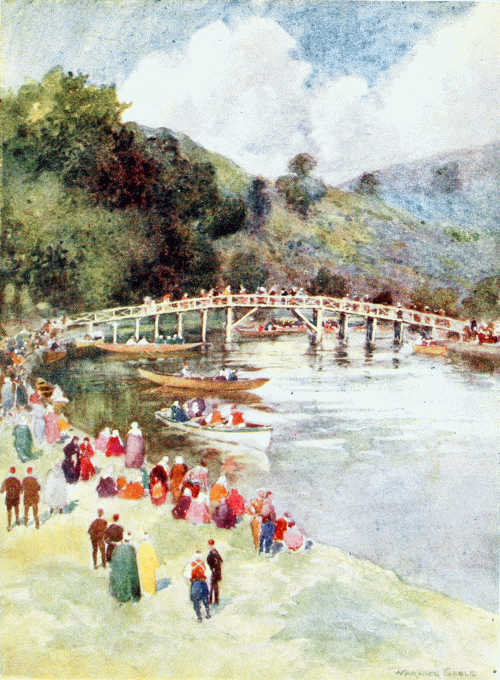
THE SWEET WATERS OF EUROPE
A pleasure resort near the upper end of the Golden Horn much in favour in the spring, when every Friday afternoon crowds of Turkish ladies with their children flock there for recreation by the water-side.
But the world moves, and Turkish women move with it. The last generation has witnessed remarkable changes in their habits both in the capital and in other great cities of the Empire. For one thing, there has been a striking change in the matter of dress. The time was, when a Turkish woman brought vivid colouring into every scene she adorned. Her yashmak, enveloping head and face and neck in white gauze; her feredjé enfolding her form down to the feet in red, green, blue, pink, or any other hue she fancied; her yellow boots and yellow overshoes, worn like slippers, made her as gay and bright as a butterfly or a flower. What wonderful pictures did groups of women thus attired form, as they squatted on a red rug spread on the green grass under the shade of cypresses or plane-trees, beside the Sweet Waters of Europe and the Heavenly Waters of Asia; or as they sat in long rows by the shores of the Bosporus to drink in the salt air, to watch the blue waters and the hurrying to and fro of boats and sails and steamers; or as they floated in a caïque over the quiet sea. What a fantasia of colour they made as they went slowly past, seated in a long, narrow wagon (arabah), its high sides bright with painted flowers and gilded256 arabesque, under a scarlet awning edged with gold fringe, drawn by white oxen, over whose heads heavy red tassels, attached to rods fixed in the yoke, waved with every motion of the creaking wheels!
But this feast of colour has ended, and the world of Turkish womanhood has exchanged the brightness of summer for the sober tints of autumn. The yashmak is now universally discarded, except by the ladies of the imperial household who are still required to wear it, as well as a black feredjé; the only bit of bright colour permitted being in the matter of the headkerchief of tulle they wear under the yashmak. In the costume of the mass of Turkish women, the feredjé has been replaced by the charshaf, a mantle worn over the head and about the body down to the feet, drawn in slightly at the waist. The material and the colour of the garment differ according to the means and taste of the wearer, but the colour is always quiet and subdued. To the portion of the charshaf above the eyes a dark veil is attached, and this can be worn over the face, or thrown back over the head, as the wearer pleases. When thrown back, a Turkish lady’s face is seen as plainly as that of her European sister. The charshaf may also be made of two pieces of cloth in order to secure a better 257fit, and although the garb might seem to defy artistic arrangement and effect, it is often very becoming and graceful. It would appear that the charshaf was the original dress of Turkish women, with the important difference from the present fashion that the veil could not be thrown back, and was furnished with two holes for the eyes, as among Moslem women to-day in Persia and India. The yashmak, it is said, came into vogue at the time of the Conquest, being an adaptation of the veil worn then by women of the Christian peoples of the land. Its abandonment for the sake of a style which permits greater freedom is a sign of progress. But the change, which was made some thirty years ago, roused considerable opposition. Merchants in the bazaars objected to it, because a charshaf required less material to be made up than a feredjé, and consequently injured trade. Others found fault with it simply because it was an innovation; while others feared that when worn with the veil down it might facilitate disguise in carrying on social or political intrigues. Nay, imperial iradès denounced and forbade the new mode. But all was in vain, for even in Turkey it is possible for women to have their own way. Nor is it only258 in their out-door dress that Turkish women have introduced alterations. They have done so likewise in their dress when at home. The baggy trousers, the embroidered vest and jacket, which constituted the costume in which a Turkish hanum reclined upon her divan, have been replaced, in the progressive section of Turkish female society, by garments after European fashions. A Turkish bride belonging to a wealthy family wears a wedding dress like that which adorns a young lady under similar circumstances in Western lands, the only difference being that the former allows her hair to hang down, and decorates it with long narrow streamers of tinsel, pieces of which she presents to her young friends for good luck. Elegant tea-gowns and the latest Parisian robes are worn in wealthy harems. Turkish ladies, indeed, have yet to adopt the low-necked dress, but, not to be altogether behind the times, they make their servant-maids don that attire on great occasions. When the maids are dark-skinned daughters of Africa, the effect is not flattering to the costume. But after all, these changes are interesting chiefly as indications of the fact that the spirit of Turkish women has come, to some degree, under the influence of new ideas. Poly259gamy is on the decline. Greater attention is now paid to the education of girls among all classes of the community. In wealthy families it is common for the daughters to have English or French or German governesses, and to be instructed in the ordinary branches of education, even to the extent of doing something so foreign as to learn to ride. In a few instances, Turkish girls attend foreign schools, and it is a most significant sign of the times to see the female relatives of such girls present at the public proceedings of these institutions. Periodicals providing special literature for ladies have appeared, and there are Turkish authoresses, some of whom enjoy a great reputation among their countrywomen. As might be expected, this upward movement meets with opposition, as upward movements always meet wherever they occur. Such a thing has been known as an imperial iradè, commanding all foreign governesses to be dismissed from Turkish homes, because of teachers pernicious ideas. On the eve of Ramazan it is usual to issue strict orders for Turkish ladies to keep their veils down. A Turkish lady once attended, with her husband, an “At Home” in a foreign house. Shortly thereafter, the police called upon the gentleman, late in the evening, as the custom is in this part260 of the world, and informed him that he was wanted at the police-court next morning on important business. What that business was the police did not condescend to say, preferring to make night uncomfortable for the couple, by keeping them in suspense. Upon appearing at the court the husband learned that the visit of his wife to a foreign house, on the occasion referred to, had been noticed and duly reported to the authorities, and he was warned (under threat of severe penalty) not to allow the offence to be repeated. At public gatherings at the Sweet Waters of Europe and Asia, the police watch the behaviour of Turkish ladies as though so many naughty or helpless children were abroad. One has seen a policeman order a lady to put up the window of her carriage, because she attracted too much admiration. At another time, one has seen a company of respectable Turkish ladies, who were enjoying a moonlight row on the Bosporus, packed home by the police. The life of educated Turkish women is rendered hard and humiliating by such restrictions. On the occasion of a visit to a Turkish gentleman in his garden, it so happened that two of his nieces, not knowing that any one was calling, came to greet their uncle. Surprised 261at seeing a man with him, the young ladies started back, as gazelles might start at the sight of a hunter. Their uncle, however, summoned them to return, and with extreme courtesy introduced them to his visitor, with the information that one of the young ladies could speak English. Conversation in that language had not gone far, when another gentleman was announced. Instantly the girls sprang to their feet and darted away as for dear life. “See,” said the uncle in tones of mingled vexation and sorrow, “See what it is to be an educated Turkish lady!”
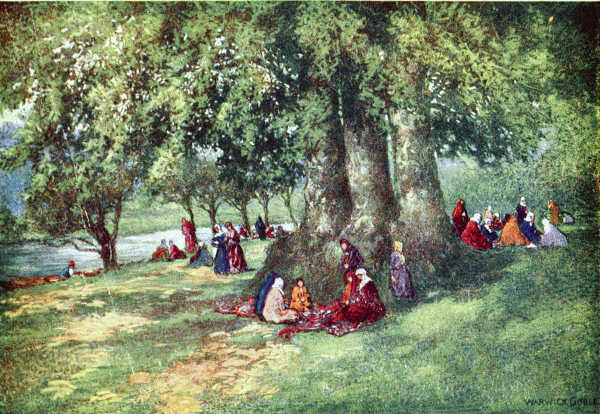
THE SWEET WATERS OF ASIA
Another favourite pleasure resort much frequented by Turkish ladies in summer.
A Turkish gentleman of high rank wishing his daughters to enjoy the advantage of a European education, but anxious to spare them as much as possible the chagrin and ennui of being educated above the station of a Turkish lady, hoped to attain his object by having his girls learn to speak French without being able to read in that language. Such experiences are disheartening. But, as the pale flowers which come ere winter has wholly gone herald the spring and foretell the glory of summer, so the recent improvements in the lot of Turkish women, however slight they may appear meantime, warrant the hope of further progress and final emancipation.
CHAPTER XIII
epilogue
To live in Constantinople is to live in a very wide world. The city, it is true, is not a seat of lofty intellectual thought. Upon none of its hills have the Muses come to dwell. It is not a centre of literary activity; it is not a home of Art. Here is no civic life to share, no far-reaching public works of philanthropy to enlarge the heart, no comprehensive national life to inspire patriotism, no common religious institutions to awaken the sense of a vast brotherhood enfolded within the same great and gracious heavens. If one is so inclined, it is easy for life here to be exceedingly petty. And yet, it is certain that to live in Constantinople is to live in a wide world. It is not for any lack of incentive that a resident here fails “to think imperially” or to feel on an imperial scale. When a man possessed by the genius of the place263 quits the city to reside elsewhere, the horizon of his life contracts and dwindles, as when a man descends from the wide views of a mountain peak to the life pent within the walls of a valley. For nowhere else is the mind not only confronted, but, if one may thus express it, assailed by so many varied subjects demanding consideration, or the heart appealed to by so many interests for its sympathy.
The very geography of the place offers a wide outlook. As a part of his everyday experience, a resident of Constantinople lives within sight of Europe and Asia. Every day of his life, he sees the waterway that runs between the two great continents thronged with vessels of every nation, hurrying to and fro to bring the ends of the earth together. Then, how much human power has been enthroned here—the dominion of Byzantium for one thousand years; the rule of Constantine and his successors for eleven centuries; the sway of the Ottoman Sultans through four hundred and fifty years. If what we see has aught to do with what we are, here is a mould in which to fashion a large life. But Europe and Asia are present in more than their physical aspects, or in long periods of their history. Their civilisations also meet here.264 On every side there is the pressure of a dominant Oriental society and polity, with its theocratic government, autocracy, the creed of Islam, polygamy, slavery, eunuchs, secluded and veiled womanhood, men in long robes and turbans, sluggishness, repose, the speech of Central Asia softened by the accents of Persia and Arabia, minarets, domes surmounted by the Crescent, graceful but strange salutations, festivals which celebrate events in a course of history not your own, and express joys which have never gladdened your soul. And mingling, but not blended, with this world of Asiatic thought and sentiment and manner, is a European world, partly native, partly foreign, with ideas of freedom, science, education, bustle, various languages, railroads, tramways, ladies in the latest Parisian fashions, church bells, the banner of the Cross, newspapers and periodicals from every European and American capital, knitting scattered children to the life of their fatherland. The members of the foreign communities in the City of the Sultan do not forget the lands of their birth, or of their race and allegiance. Though circumstances have carried them far from their native shores and skies, physical separation does not sever them from the spirit of their peoples. Nay, as if to265 make patriotic sentiment more easy, foreigners are placed under the peculiar arrangements embodied in what are termed the Capitulations, whereby, in virtue of old treaties, they enjoy the privilege of living to a great extent under the laws of their respective countries, with little interference on the part of the Ottoman Government. When your house is your castle, in the sense that no Turkish policeman dares enter it without the authorisation of your Consulate or Embassy, when legal differences between yourself and your fellow-countrymen are submitted to judges, and argued by barristers, bred in the law which rules in your own land, when your church and school can be what they are at home, and when you can forward your letters, not only to foreign countries but even to some parts of the Turkish Empire, with a stamp bearing the badge of your own Government, it is natural that European residents in Constantinople should be able to preserve their special character, both after living here for many years, and also from generation to generation. A Mohammedan polity is opposed to the assimilation of strangers, unless the aliens become converts to Islam. Whatever process of assimilation goes on in Constantinople appears in the slow changes of the East towards some likeness266 to the West. Otherwise, the European world is as present to the view as the Asiatic, and together they spread a wide vista before the mind.
Furthermore, what a broad outlook does the heterogeneous population afford! Whether you walk the streets or stay at home, on the mart of business, at all large social gatherings, in all public enterprises, you deal with diverse nationalities and races. Everywhere and always a cosmopolitan atmosphere pervades your life. One servant in your household will be a Greek, another an Armenian, a third a German or an Englishman. Your gardener is a Croat, as tender to flowers as he is fierce against his foes. The boatmen of your caïque are Turks. In building a house, the foundations are excavated by Lazes; the quarrymen must be Croats; the masons and carpenters are Greeks and Armenians; the hodmen, Kurds; the hamals, Turks; the plumbers, Italians; the architect is an Englishman, American, or a foreigner of some other kind; the glaziers must be Jews. Fourteen nationalities are represented by the students and professors of an international college.
When the season of pilgrimages comes round, the streets are thronged by Tartars, Circassians, Persians, Turcomans, on their way to Mecca267 and Medina, wild-looking fellows in rough but picturesque garb, staring with the wonder and simplicity of children at the novelties they see, purchasing trifles as though treasures, yet stopping to give alms to a beggar, and groping for the higher life.
Nor is it only in great matters that this wideness of human life comes home to the mind in Constantinople. It is pressed upon the attention by the diversity that prevails, likewise, in matters of comparatively slight importance; in such an affair, for example, as the calculation of time. For some, the pivotal event of history is the birth of Christ; for others, it is the Flight of Mahomet from Mecca to Medina, and accordingly, two systems of the world’s chronology are in vogue. One large part of the populations still adheres to the primitive idea that a new day commences at sunset, while another part of the community defers that event until the moment after midnight. Hence in your movements and engagements you have constantly to calculate the precise time of day according to both views upon the subject. The time-tables of the steamers which ply between the city and the suburbs on the Bosporus and the Sea of Marmora, adopt “Turkish time,” and require you to convert268 the hour indicated into the corresponding hour from the European or “Frank” standpoint; and the same two-fold way of thinking on the subject is imposed upon all persons having dealings with the Government and the native population in general. A similar diversity exists in regard to the length of the year. The Turkish year consists of twelve lunar months, a thirteenth being added from time to time to settle accounts with the sun. The question when Ramazan, the month of fasting by day and of feasting at night begins, or when the festival of Bairam commences is determined, at least formally, by the appearance of the new moon, upon the testimony of two Moslem witnesses before a judge in any part of the Empire. Thus these religious seasons might commence on different days in different localities, the moon not being visible in some places, on account of the state of the weather. The formula in which the approach of these seasons is now announced to the public, since the increase of astronomical knowledge in Turkish circles, is a curious compromise between former uncertainty and actual assurance on that point. “Ramazan begins (say) on Tuesday next, provided the new moon is visible. If not, the Fast will date from Wednesday.” Alongside the269 Turkish mode of measuring the year, there is the method introduced into the Roman world by Julius Cæsar, the “Old Style,” followed by Greeks and Armenians, and also the “New Style,” the mode of reckoning inaugurated by Pope Gregory XIII., now thirteen days in advance of the Julian Calendar. Accordingly, to prevent mistakes in regard to a date, letters and newspapers are often dated according to both styles. With some the year begins in March, with the advent of spring; with others it commences in September, when autumn gathers in the fruits of the earth; others make January, in midwinter, their starting-point. The difference between the “Old Style” and the “New Style” involves two celebrations, as a rule, of Easter, two observances of New Year’s Day, while Christmas is celebrated three times, the Armenian Church having combined the commemoration of that festival with the more ancient festival of the Epiphany. For one section of the community, moreover, the day of rest is Sunday, for another Saturday, for yet another the day of special religious services is Friday. All these differences are not matters seen at a remote distance of place or time; they are not curious items of archæological lore. On the contrary, they enter into the270 practical experience of your workaday life, compelling you to see things from various points of view, and to conform with the ways of humanity in manifold directions.
Then what a diversified scene is spread before the mind by the variety of religious faiths professed here. A native of Constantinople put the case before the Parliament of Religions, held at the Chicago Exposition, thus: “We have a Parliament of Religions every day in Constantinople.” The faith of Israel, Mohammedanism, and Christianity, are here matched against each other in great organised communities, with the marks of the controversies and wars which form so large a part of the history of this Eastern world fresh and clear upon them.
Here are the sects and schools of thought which divide Islam; the Sunnites who maintain the legitimacy of all the Caliphs, the Shiites who hold that Ali, the cousin and son-in-law of the Prophet, was his first lawful successor, and who gather annually in the court of the Validè Khan in Stamboul, to cut and gash themselves, like their brethren in Persia, as they mourn the murder of Ali’s sons, Hussein and Hassan; the Howling and the Dancing Dervishes who hope to apprehend the Divine in271 their ecstasy, the Bektashs Dervishes, more rationalistic, more tolerant, more latitudinarian. Here are the sects that divide the Christian world; Orthodox Greek, Roman Catholic, Gregorian Armenian, Protestant, representatives of the Nestorian Church, and of the Syrian Jacobites. What long vistas of Church History are thus open on every hand; what different modes of conceiving truths stare you in the face at every turn!
Finally, but not least, there is the spacious outlook afforded by the political situation, of which Constantinople has long been the centre. The question of the continued existence of the Ottoman rule in Europe, if not also in Asia, has been a burning question for many generations, affecting both the destiny of the peoples subject to that rule and the interests and relations of all the Great Powers of Europe. It is one of the biggest, most important, most complicated problems that can occupy the minds of the statesmen of the world, and it has no less magnitude in its appeals to the concern of philanthropists. Here, to speak with malice to none and with charity for all, is a rule established by the might of conquest over different races, rival nationalities, various creeds. As already observed, the conquerors have neither wished nor272 been able to efface these distinctions, nor have the conquered had any inclination to be merged into a common life and polity. In such a state of things it is not surprising that no love has been lost. Legend has it that the battle of Chalons was waged with such ferocity, that, after the bodies of the combatants lay cold upon the ground, their spirits continued to fight in the air. The struggle between the conqueror and the conquered in Turkey has raged in their hearts even when, to all appearance, it seemed to have ended. In thought and sentiment the country has always been in a state of war. That a rule carried on in the spirit of conquest and of religious exclusiveness should have involved intolerable treatment of the subject peoples is only what might be expected, notwithstanding occasional good intentions. And that peoples thus treated, and persistently reminded of their subjugation and inferior legal standing should never abandon the hope of deliverance, and should even endeavour to create opportunities to achieve emancipation is, likewise, only what might be expected. Whether the subject peoples could have already gained their liberty, if they had been united, is a question open to debate. But what is certain is that their rivalries,273 their dissensions, and their natural but incompatible expectations, have retarded the realisation of their ambitions. To a large extent, this is their misfortune; the fate imposed upon them by their circumstances. Look, for example, at the situation in the European portion of the Empire. How can any one expect Roumanians, Servians, Bulgarians, Greeks, and Albanians to forget their historical antecedents, their race distinctions, and their associations with different parts of the country, in order to become one nationality? How can they be persuaded to combine in a common effort to become free, while the points in dispute between themselves remain unsettled? The question is rendered yet more difficult when these peoples, as is often the case, dwell side by side in the same section of the country.
Here is a tangle of claims which an impartial mind finds hard to unravel, and feels tempted to relegate to the sword that cuts the Gordian knot. The fundamental difficulty that hinders the solution of what is known as “the Eastern Question” is the absence of a large homogeneous population within the bounds of the Empire, to which the Government of the country can be transferred from the hands of the present ruling race. No single people, under274 Ottoman rule, can replace the Turk in the mastership of the whole Empire. It is a property that must be divided, and the division of the inheritance, if it is to be carried out in the spirit of justice and common sense and not of partisanship, is a matter of extreme perplexity. Hence the occasion for the interference of the Great Powers of Europe, sometimes to assist the weak, sometimes to repress risings, sometimes to limit the area of disturbance, sometimes to extort concessions, sometimes to appropriate a portion of the spoils, always to guard their own interests, real or artificial. That interference is crippled, often paralysed, by mutual jealousies, by native dissensions, by greater concern for the success of foreign schemes than for the welfare of the country, by the dread of a great war, by inability to answer clearly the question, What next? The spectacle presented by the action of the Powers is not always edifying. It has, at times, provoked the opinion that they are not powerful, but powerless. But the historical evolution which is in process has brought great actors upon the scene. It keeps great themes continually before the mind. Again and again, it has been accompanied with the tramp of armies, and resounded with the thunders of war. It is studded with Conferences and Con275gresses, at which the foremost statesmen of the day have discussed the destiny of this city and land, as the most momentous problem of European politics. It is still overshadowed by war-clouds.
Nor has all this been a vain show. In the course of the past century, liberty has won many victories in the Near East. Servia, Roumania, Bulgaria, Greece, have risen from the dead and become independent and progressive nations. Old national memories, stretching, in the case of Greece, as far back as classic times, have united with modern ideas to restore the continuity of history, and to hasten the day when the whole of Europe will move forward together. The flood which covered the land has slowly subsided. Tract after tract of the devastated earth has risen above the waters, and is reclaimed for new life and fruit. And the forces which have produced this wonderful transformation still operate. Who can stay their power? What precise form the final consummation will assume—a federation, the rule of a Free Russia, a group of independent but friendly States, partition between the Great Powers—is a secret no one can meantime divine. The unexpected may happen. But the future destiny of a city which has acted so great a part in the past, and which is276 capable of acting an even greater part in the time to come, is only another reason why life here is so large. What other city presents such a problem? One may as soon dwell by the shore of an ocean, or in view of peaks rising to heaven, and fail to be impressed by the greatness of the world, as live in Constantinople without realising the vastness of human interests and problems.277
INDEX
- Abimelech, 254
- Acœmetæ, 150, 155
- Acropolis, 15, 16, 88, 89
- Admiralty, 109, 117
- Adrianople, 33, 144
- Aivan Serai, 54, 102, 115, 119
- Alaric, 45, 54
- Albanians, 273
- Alemanni, 29
- Alexander the Great, 13
- Ali, 270
- Alti Mermer, 37
- Amalfi, 161
- Ammianus Marcellinus, 25
- Anemodulion, 39
- Anna Dalassena, 163
- Anthemius, Prefect, 55, 56, 57, 58, 59, 137, 149, 183
- Anthemius of Tralles, 180
- Aqueduct of Valens, 218
- Arabs, 123
- Arcadia, 48
- Arian, 234
- Arius, 35
- Armenian Church, 68, 234
- Armenians, 211, 234
- Athanaric, 34, 35
- Athenais, 71, 72
- Athyras, 122
- Attila, 54, 57, 78, 122
- Augustaion, 20
- Avars, 120, 123, 155
- Bairam, 231, 268
- Balat, 111
- Basil, 86, 135, 157
- Basilica, 27
- Basilica Cistern, 218
- Basilica Theodosiana, 39
- Baths of Achilles, The, 60
- Baths of Constantine, 39
- Baths of Zeuxippus, 16, 19, 20
- Bektash Dervishes, 271
- Belgrade, 9
- Belisarius, 158
- Beshiktash, 84, 114, 116
- Blachernæ, 23, 53, 120
- Bohemond, 126
- Bondelmontius, 137
- Bonus, 155
- Bronze Horses of Lysippus, 60
- Browning, 104
- Bucoleon, 94, 96
- Bulgaria, 275
- Bulgarian Church, 239, 240
- Bulgarians, 236, 238, 239, 240, 273
- Bury, Professor, 148
- Buyuk Tchekmedjé, 122
- Buyukderé, 203
- Cannæ, 33
- Canning, Sir Stratford, 200, 250
- Capitol, 21, 62
- Capitoline Hill, 193
- Capitulations, 265
- Carthage, 54, 57
- Cassim Pasha, 114, 116
- Cassius, 4
- Chæronea, 149
- Chalcedon, 84
- Chalons, 272
- 278
- Charles Martel, 148
- Chichli, 202
- Christmas, 269
- Chrysopolis, 12
- Chrysostom, 45, 47, 55, 60, 69
- Churches—
- S. Agnes, 174
- All Saints, 136
- Anastasia, 36
- S. Barbara, 89
- S. Demetrius, 141
- S. Diomed, 99
- Forty Martyrs, 136
- S. George (Soulou Monastir), 99
- S. George Mangana, 89, 141
- Holy Apostles, 21, 24, 26, 35, 69, 138, 139, 140, 148, 168, 189
- S. Irene, 20, 48, 88, 141, 147, 148, 174, 186
- S. John Studies, 99, 150, 152, 154, 172, 186
- S. Mamas, 84
- S. Mark’s of Venice, 60, 190
- S. Mary of Blachernæ, 69, 110, 120
- S. Mary Hodegetria, 69, 89, 141, 167
- S. Mary Mouchliotissa, 146
- S. Mary Pammacaristos, 110, 139, 146, 164, 168, 189, 190
- S. Mary Panachrantes, 189
- S. Mary Peribleptos, 99
- S. Mokius, 136
- S. Peter in Galata, 167
- S.S. Peter and Mark, 110
- S.S. Peter and Paul, 157, 158
- S. Saviour-in-the-Chora, 149, 162, 166, 167, 168, 188, 189, 190, 191
- S. Saviour Pantepoptes, 110, 116, 162, 163, 191
- S. Saviour Pantocrator, 110, 162, 164, 190, 191
- S.S. Sergius and Bacchus, 92, 96, 155, 157, 175, 176, 177, 178, 179, 180, 184, 186
- S. Sophia, 26, 27, 47, 60, 79, 82, 93, 111, 135, 138, 139, 148, 155, 159, 162, 171, 180, 181, 182, 184, 185, 186, 187, 191, 218, 228
- S. Theodore, 93
- S. Theodore Tyrone, 190, 191
- S. Theodosia, 110, 166, 167, 168
- S. Vitale at Ravenna, 177, 178, 180
- Circassians, 266
- Clavijo, 132
- Code of Justinian the Great, 65
- Code of Theodosius II., 64, 65
- Column of Claudius Gothicus, 47
- Column of Marcus Aurelius, 38
- Column of Trajan, 38
- Constantine the Eparch, 58, 59, 77
- Coptic Church, 68, 234
- Council of Chalcedon, 68
- Council of Ephesus, 68
- Count Robert of Paris, 126
- Crum, 120, 123, 153
- Custom House, 207, 211
- Cyril, 160
- Cyrus, Prefect, 57, 58, 60, 61, 77
- Dancing Dervishes, 270
- Dandolo, Doge Henrico, 60, 87, 106, 114, 115, 116, 163
- Dardanelles, 203
- Darius I., 13, 224
- De Amicis, 195
- Delphi, 22
- Demophilus, 36
- Dionysius, 155
- Dockyard, 109
- Ducange, 132
- Ducas, 168
- Easter, 269
- Easter Monday, 211
- Eleutherius, 21
- Emperors—
- Alexius I. Comnenus, 106, 126, 127, 163
- Alexius V. Ducas, Murtzuphlus, 38, 116, 163
- Andronicus II. Palæologus, 192
- Andronicus III. Palæologus, 85
- Arcadius, 42, 44, 45, 46, 47, 49, 50, 55
- Baldwin I., 127, 164
- Basil I., 99, 135, 157
- Basil II., 85, 100, 124
- Claudius Gothicus, 14. 47
- Constantine the Great, 1, 4, 7, 9, 11, 12, 15, 16, 17, 19, 20, 21, 24, 25, 31, 43, 44, 61, 64, 83, 88, 91
- Constantine IV. Pogonatus, 98
- Constantine V. Copronymus, 124
- Constantine XII. Dragases, 129, 130
- 279
- Constantius II., 25, 26, 27
- Diocletian, I, 7, 8, 9
- Heraclius, 87, 98, 120, 124, 155
- Honorius, 42, 50
- Isaac I. Comnenus, 151
- Isaac II. Angelus, 115
- John I. Zimisces, 94, 95, 100, 124, 160
- John II. Comnenus, 163
- John V. Cantacuzene, 168
- John VI. Palæologus, 136
- Julian, 27, 28, 29, 30, 32
- Justinian the Great, 89, 94, 96, 109, 135, 148, 155, 156, 158, 178, 185, 189
- Justin II., 30
- Leo III. the Isaurian, 148
- Leo V. the Armenian, 10, 12
- Leo VI. the Wise, 85
- Licinius, 12, 15
- Manuel Comnenus, 85, 119, 126
- Marcian, 71, 78
- Michael VII. Ducas, 151
- Michael VIII. Palæologus, 85, 97, 106
- Nero, 1
- Nicephorus Phocas, 94, 100
- Phocas, 87, 98
- Septimius Severus, 13, 16, 98
- Theodosius the Great, 34, 35, 36, 37, 38, 39, 40, 41, 42, 44, 148
- Theodosius II., 39, 40, 49, 53, 55, 57, 59, 61, 62, 64, 65, 67, 69, 70, 71, 72, 73, 78, 84, 101, 118
- Theophilus, 85, 86, 124
- Trajan, 26
- Valens, 31, 32, 33
- Empress Dominica, 33
- Epiphany, 269
- Eubulus, 88
- Eutropius, 45
- Eutychius, 71
- Exakionion, 37
- Exarch, 239
- Exokionion, 36, 37, 149
- Exokionitæ, 36
- Eyoub, 111, 113, 114
- Factions, 41, 58, 75
- Field of the Witnesses, 223, 224
- Fortress of the Seven Towers, 140
- Forum of Arcadius, 49
- Forum of Theodosius, 38, 49
- Forum of Theodosius I., 49
- Forum of Trajan, 25
- Forum Romanum, 3
- Fountain of Sultan Achmed III., 218
- Fourteen Wards, 23
- Fourth Crusade, 38, 87, 106, 113, 123, 126, 127, 163
- Frederic, Cardinal, 161
- Gainas, 45, 46
- Galata, 23, 84, 108, 195
- Galata Bridge, 105, 202
- Gates—
- Achour Kapoussi, 83
- Adrianople, 183
- Ancient Gate, 17, 36, 37
- Beautiful Gate of S. Sophia, 162
- Charisius, 123, 129
- Daoud Pasha Kapoussi, 83, 96
- Deïrmen Kapoussi, 86, 89
- Edirne Kapoussi, 128
- Egri Kapou, 23, 119
- Eugenius, 102
- Golden Gate, 39, 40, 77, 124, 140, 149, 202
- Isa Kapoussi, 37
- Jesus, 17
- Kerkoporta, 130
- Kiretch Kapoussi, 102
- Narli Kapoussi, 151
- Odoun Kapan Kapoussi, 109
- Rhegium, 59, 77
- S. Æmilianus, 83, 96
- S. Romanus, 123, 128
- Tchatlady Kapou, 94
- Top Kapoussi, 123, 128
- Xylokerkou, 77
- Yali Kiosk Kapoussi, 102
- Yeni Mevlevi Khaneh Kapoussi, 59
- Zindan Kapoussi, 106
- Gennadius, 138, 139
- Genoa, 88, 107, 108, 128, 129
- Genoese Castle, 224
- Genseric, 54
- George the Despot of Servia, 86
- Geysa I., 163
- Gibbon, 3, 193
- 280
- Giustiniani, 129, 130
- Gladstone, Mr., 125
- Godfrey of Bouillon, 126, 163
- Goths, 6, 14, 33, 34, 35, 49
- Great Palace, 94
- Great Powers, 271, 274, 275
- Greece, 275
- Greek Orthodox Church, 238, 239, 240, 271
- Greeks, 236, 240, 273
- Gregorian Armenian, 271
- Gregory of Nyssa, 67
- Gregory of Nazianzus, 36
- Harbour of Eleutherius, 21, 42, 98
- Harbour of Julian or New Harbour, 30, 87, 96
- Harbour of Kaisarius, 97
- Harbour of the Kontoscalion, 96
- Harbour of Sophia, 30, 87
- Harbour of Theodosius I., 98
- Harrison, Mr. Frederic, 95
- Haskeui, 111, 114
- Hassan, 270
- Hebdomon, 57
- Heraclea, 14
- Herodotus, 224
- Hippodrome, 16, 19, 20, 22, 30, 40, 41, 58, 60, 61, 77, 87, 92, 96, 134, 136, 151, 171
- Hodgkin, Dr., 11
- Holy Well, 110
- Hormisdas, 24, 26
- Hospital of Sampson, 88
- Howling Dervishes, 229, 270
- Hugo of Saint Paul, 127
- Humbert, Cardinal, 160, 161
- Huns, 33, 55, 78, 122, 149, 206
- Hussein, 270
- Iconoclast, 152
- Imarets, 231
- Imperial Palace, 136
- Imperial Treasury, 199
- Indjili Kiosk, 89
- Inner Bridge, 17, 10l, 109, 115, 202
- Isidorus of Miletus, 180, 183
- Janissaries, 225
- Kadikeui, 83, 85
- Kadriga Limani, 30, 87
- Koran, 242
- Kurds, 211, 266
- Kutzo-Wlachs, 240
- La Broquière, 137
- Lake of Derkos, 218
- Latin Crusaders, 138
- Layard, Sir Henry, 196
- Lazes, 266
- Leontius, 71, 72
- Libanius, 29
- Louis of Blois and Chartres, 127
- Lycus, 129, 131
- Macedonia, 239, 240
- Mahomet, 111, 162, 232, 267
- Mangana, 89
- Mardonius, 27
- Marina, 48
- Mary Ducæna, 163
- Maximus, 39
- Mecca, 266, 267
- Medina, 267
- Megara, 12
- Methodius, 160
- Milan, 8
- Milion, 20
- Mir-Akhor Djamissi, 150
- Mithridates, 13
- Modestius, Prefect, 31
- Monastery of Hormisdas, 159
- Mosaic Mosque, 149
- Mosques:—
- Aivas Effendi, 126
- Atik Mustapha Pasha Djamissi, 110
- Eski Imaret Djamissi, 110, 162
- Eyoub, 224
- Fethiyeh Djamissi, 166
- Gul Djamissi, 110, 166
- Isa Kapoussi Mesdjidi, 17, 149
- Kahriyeh Djamissi, 110, 149, 162
- Kutchuk Aya Sofia, 155, 175
- Shahzadè, 190
- Suleiman the Magnificent, 109, 190
- Sultan Achmed, 20, 93, 191
- Sultan Mehemet, 21, 31, 148, 190
- Sultan Selim, 49, 190
- Tulbenkdji Djamissi, 97
- Zeirek Kilisse Djamissi, 162
- Mount Olympus, 91
- Museum of the Janissary Costumes, 199
- 281
- Naissus, 9
- Naval Hospital, 109
- Neorion or Dockyard of the Heptascalon, 97
- Nestorian Church, 234, 271
- Nestorius, 71, 73, 67
- New Style, 269
- New Year’s Day, 269
- Nicephorus Gregoras, 168
- Nicomedia, 9, 24, 27
- Night of Power, The, 228
- Nika, 148
- Nisch, 9
- Normans, 106
- Odessa, 239
- Okmeidan, 109
- Old Style, 269
- Ortakeui, 202
- Ostrogoths, 46
- Othman, 11, 199
- Pachymeres, 97, 168
- Palace of—
- Palatine, 93
- Pantheon, 179, 187
- Pardoe, Miss, 197
- Parthenon, 79
- Patriarch Jeremiah, 141
- Paulicians, 153
- Paulinus, 72, 73, 74
- Pausanias, 13
- Pera, 102, 108, 202
- Persia, 6, 28, 124
- Persians, 22, 266
- Pescennius Niger, 13
- Peter the Hermit, 126, 163
- Phanar, 49, 110, 115, 116, 146
- Philip of Macedon, 13, 88
- Philopation, 89
- Phrantzes, 168
- Pisans, 107
- Platæa, 13
- Pope Gregory the Great, 157
- Prison of Anemas, 120
- Proclus, 41
- Procopius, 32
- Psamatia, 17, 99, 150, 172
- Public Fountains, 217
- Public Granaries, The, 60
- Pulcheria, 48, 69, 70, 72, 73
- Ramazan, 228, 231, 243, 259, 268
- Ravenna, 8
- Robert of Normandy, 126
- Roumania, 275
- Roumanians, 236, 273
- Roumeli Hissar, 215, 223
- Rufinus, 45
- Russia, 275
- Sacred Palace, 171
- Samson, 233
- Samson Agonistes, 232
- San Stefano, 114
- Saracens, 107, 111, 124
- Sardica, 6
- Sarmatians, 6
- Scutari, 12, 84, 114
- Second General Council, 37
- Senate House, 20, 29, 60
- Seraglio Lighthouse, 15
- Seraglio Point, 14, 15, 48, 81, 83, 84, 85, 88, 90, 91, 106, 138, 199, 219, 224
- Serpent Column, 22
- Servia, 275
- Servians, 236, 240, 273
- Seven Towers, 81
- Sheik-ul-Islam, 142, 224
- Shiites, 270
- Sigma, 30
- Simon, 154
- Simplicius, 48
- Singidunum, 9
- Sophia, 9, 36
- Spalato, 171
- Stanley, Dean, 11
- Strategion, 23
- Studius, 150, 151, 172
- Sultan Abdul Azis, 224
- Abdul Medjid, 90
- Bajazet II., 38
- Mahomet, 199
- 282
- Mehemet the Conqueror, 90, 113, 123, 128, 142, 143, 145, 162, 223
- Murad, 123, 224
- Selim I., 141
- Suleiman the Magnificent, 141
- Sunnites, 270
- Sweet Waters of Asia, 255, 260
- Sweet Waters of Europe, 111, 113, 255, 260
- Swiatoslaf, 124
- Symeon, 123
- Syrian Jacobites, 271
- Tancred, 126
- Tartars, 266
- Taxim, 211
- Tekfour Serai, 53, 118
- Temple Bar, 17
- Temple of Jupiter, 193
- Temple of the Winds, 39
- Themistius, 26, 43, 137
- Theodora, 94, 176
- Theodore, 152, 153, 154
- Theodore Metochites, 150
- Theodoric the Great, 177
- Theodosian Wall, 77, 118
- Therapia, 203
- Thermæ of Arcadia, 48, 89
- Thessalonica, 9
- Torcello, 175
- Tours, 148
- Tower of Galata, 102, 107
- Tower of Isaac Angelus, 120, 126, 135, 136
- Trajan, 26
- Troy, 9
- Turcomans, 266
- Tzycanisterion, 90
- Ulfilas, 45
- University of Constantinople, 62, 63, 77
- Validé, Khan, 270
- Validé, Sultana, 250
- Vandals, 57
- Varangian troops, 127
- Vefa Meidan, 190
- Venice, 60, 88, 106, 108, 114, 128
- Vienna, 205
- Ville-Hardouin, 114, 127, 134
- Visigoths, 45
- Vladimir, 159
- Vlanga, 17, 88, 134
- Vlanga Bostan, 42, 83, 98, 99
- Wheler, 50
- White, Colonel, 196, 197
- Xenophon, 88
- Xerolophus, 49, 69
- Yeri Batan Serai, 27, 218


